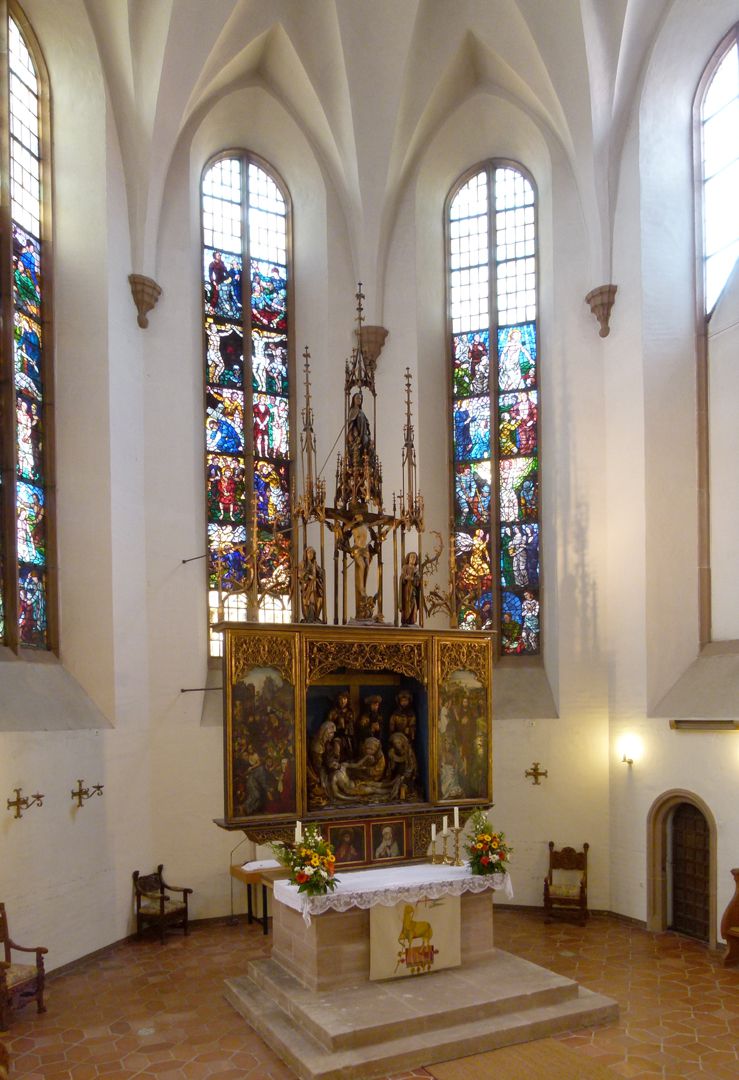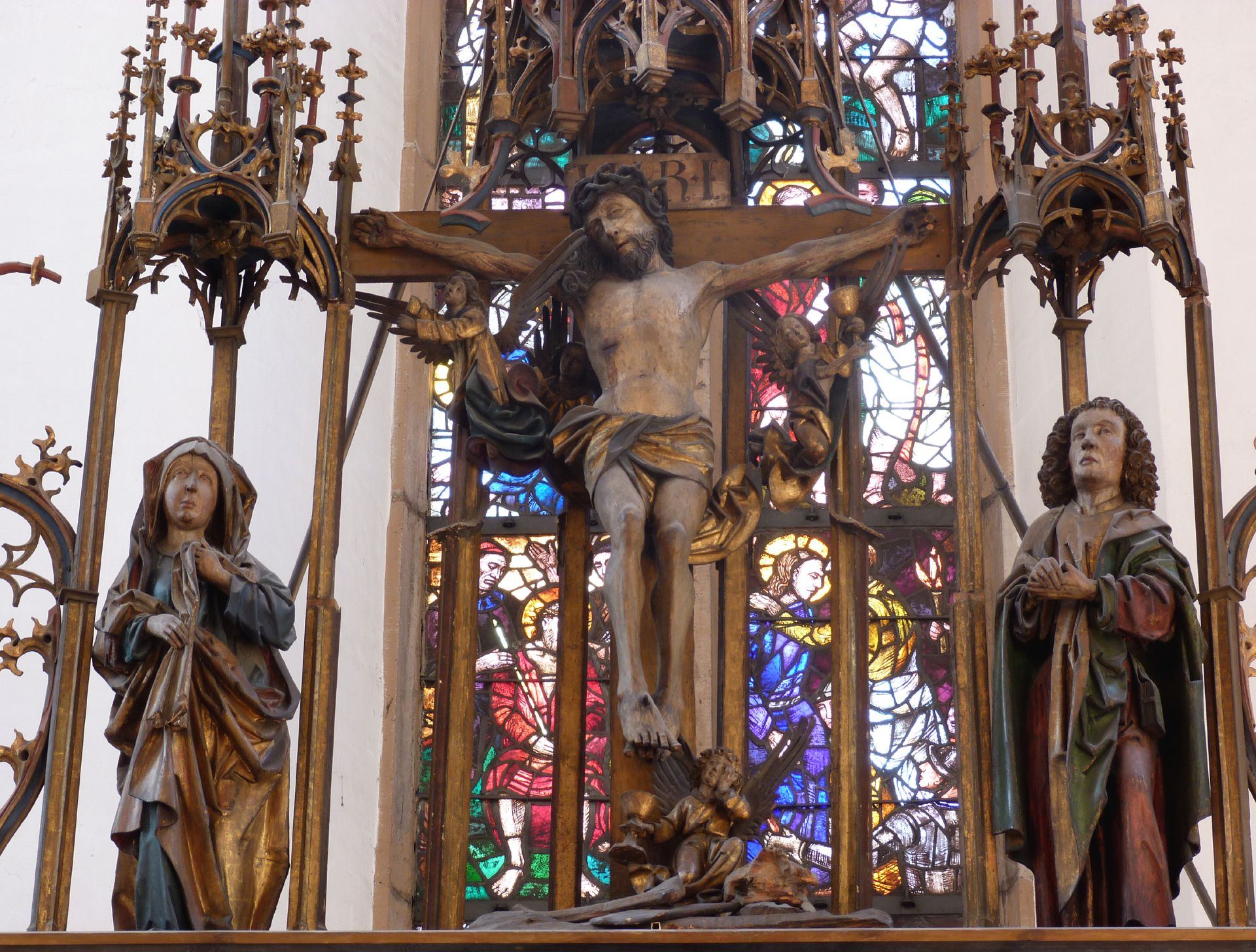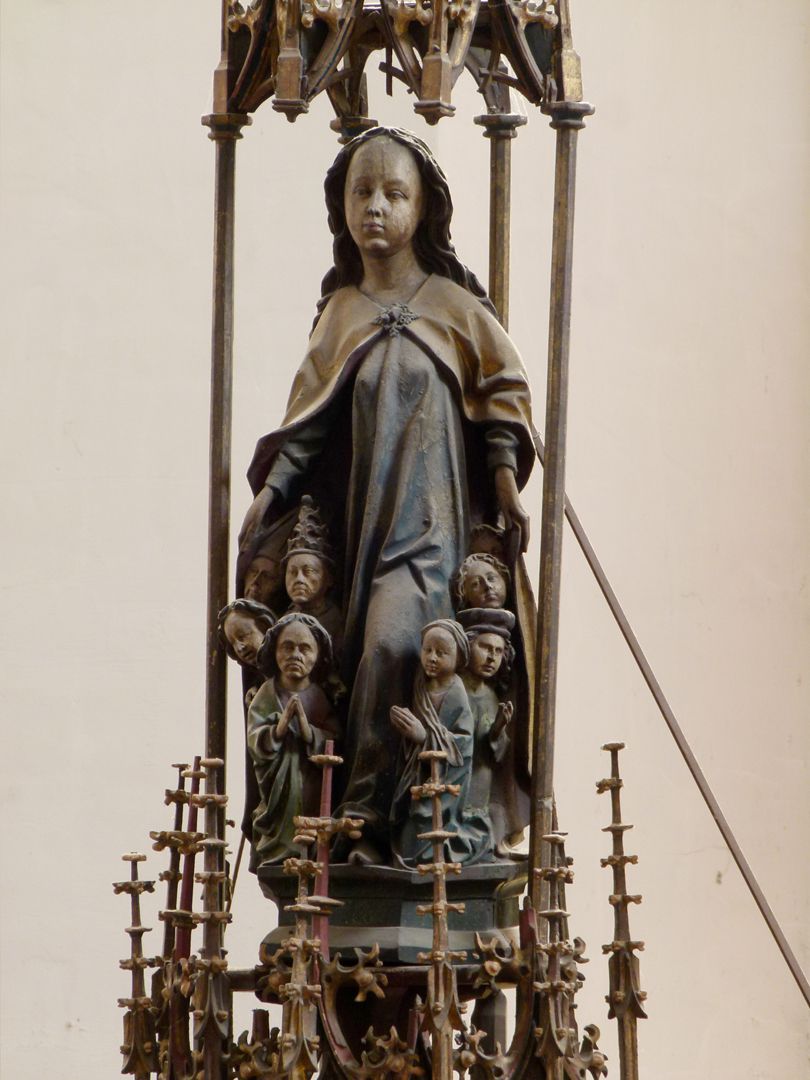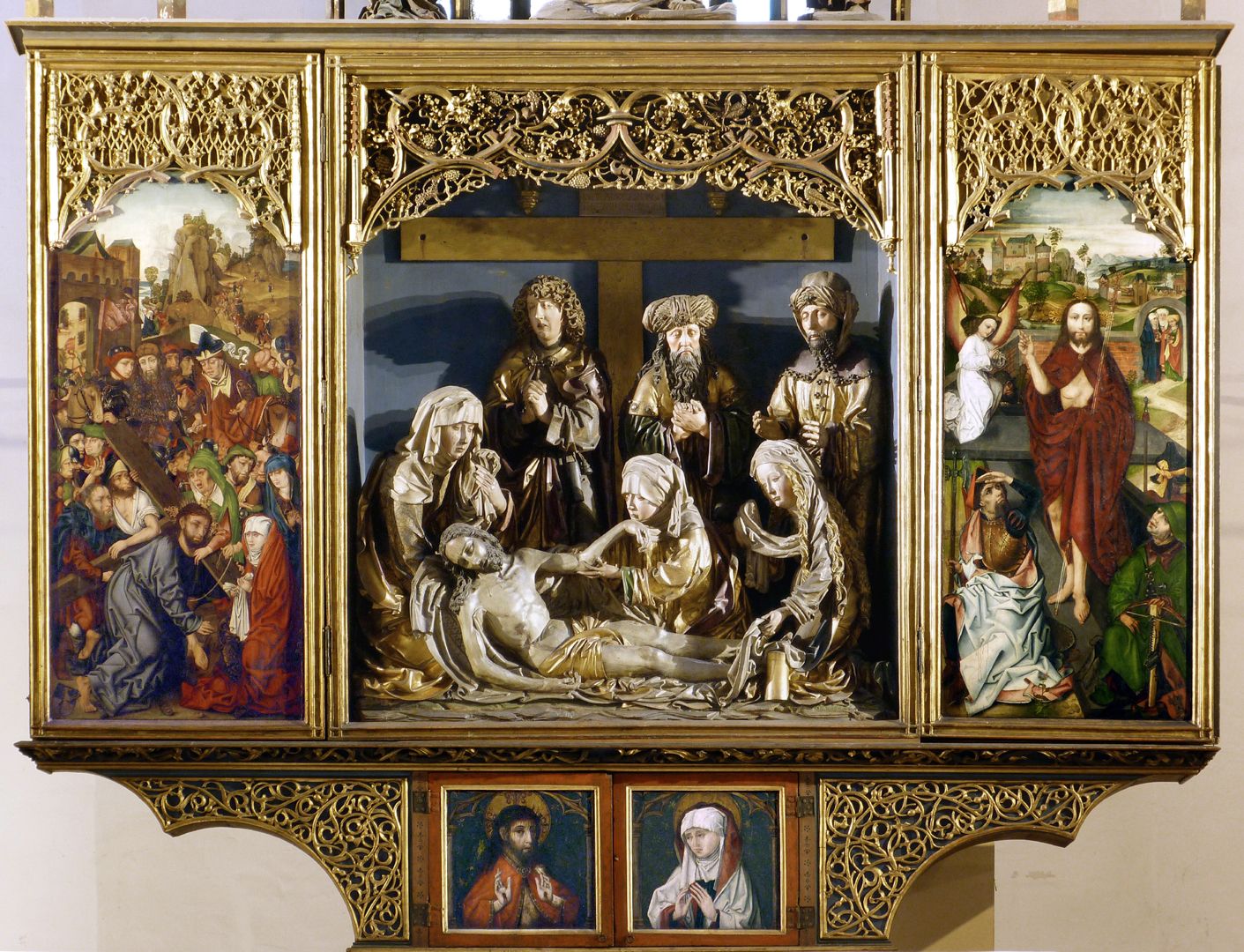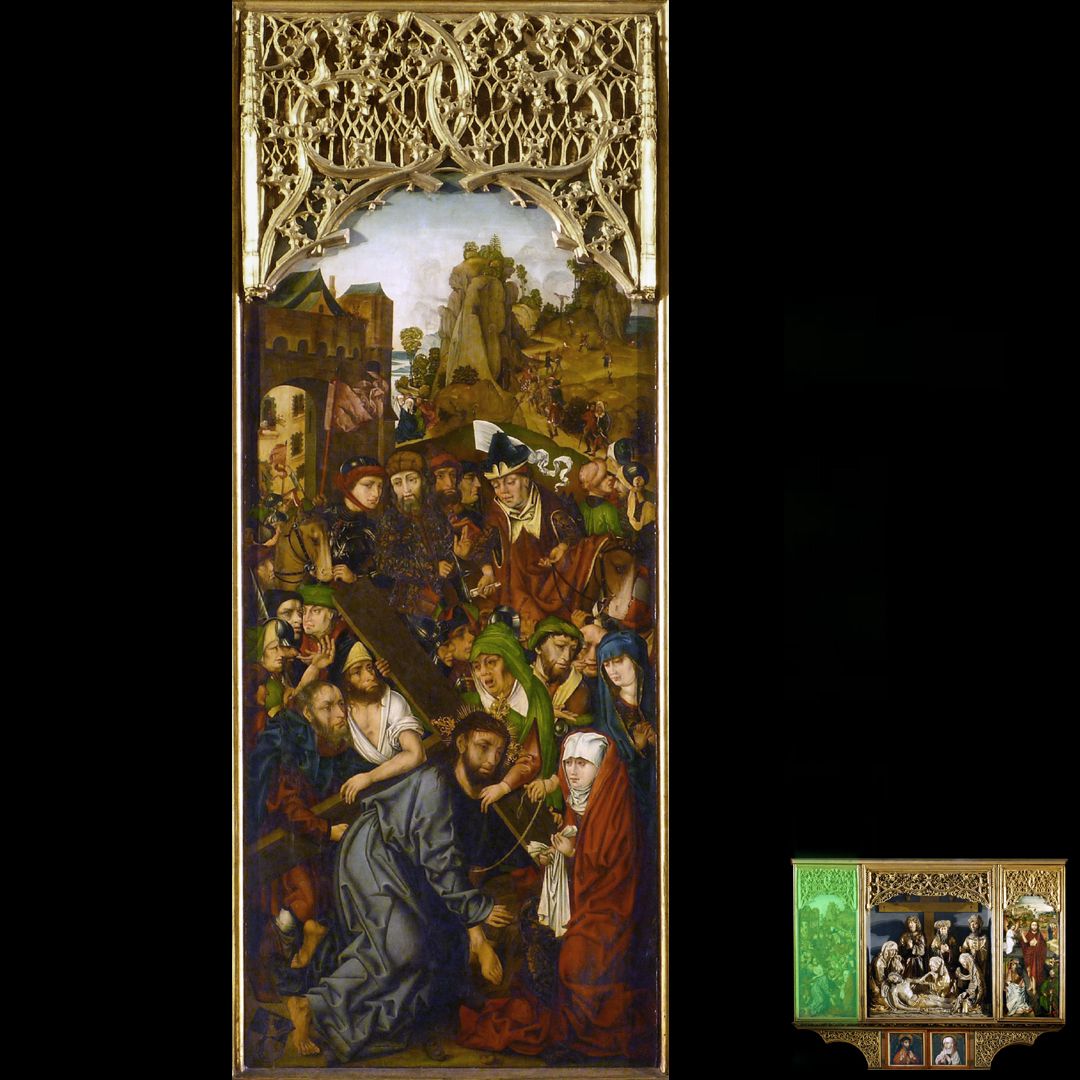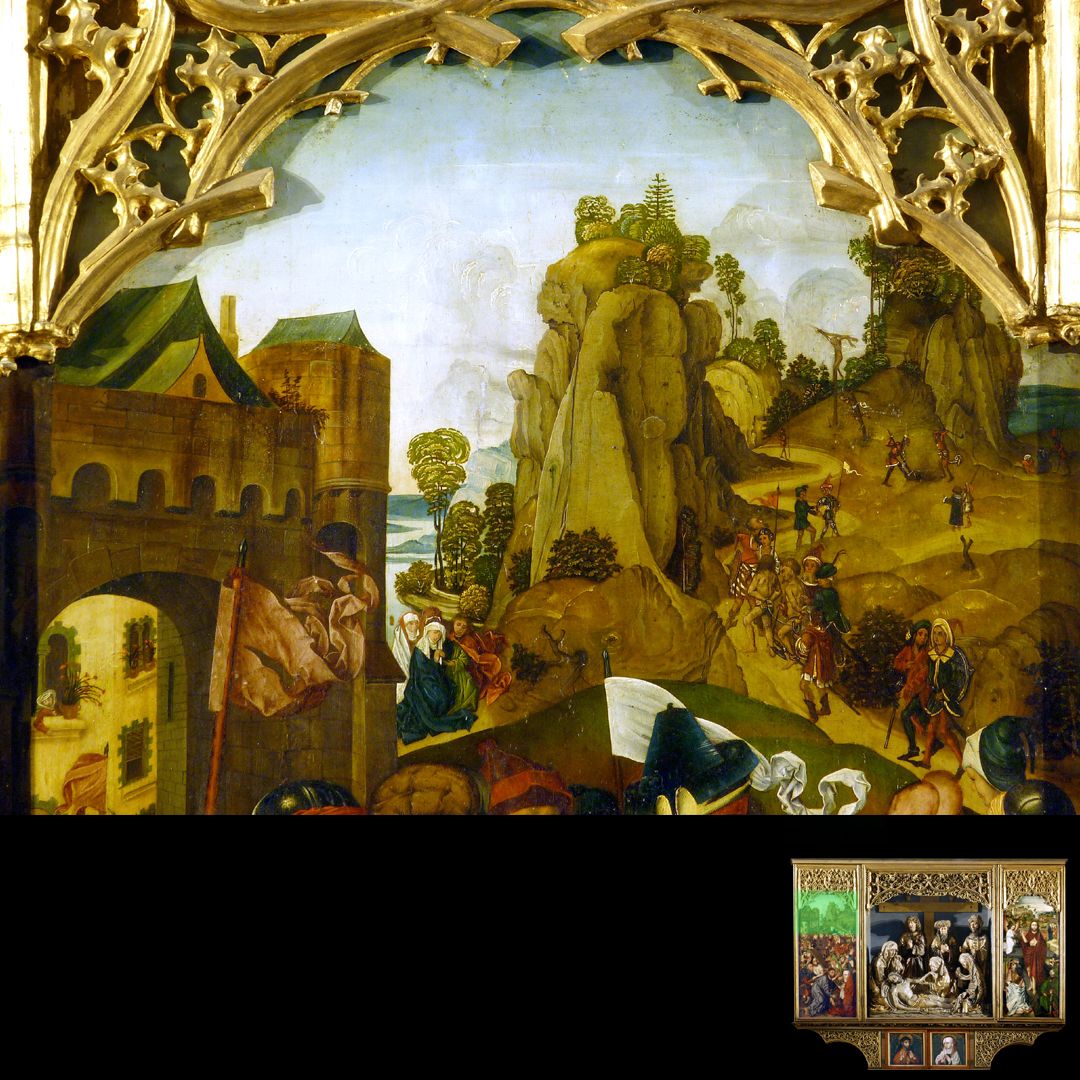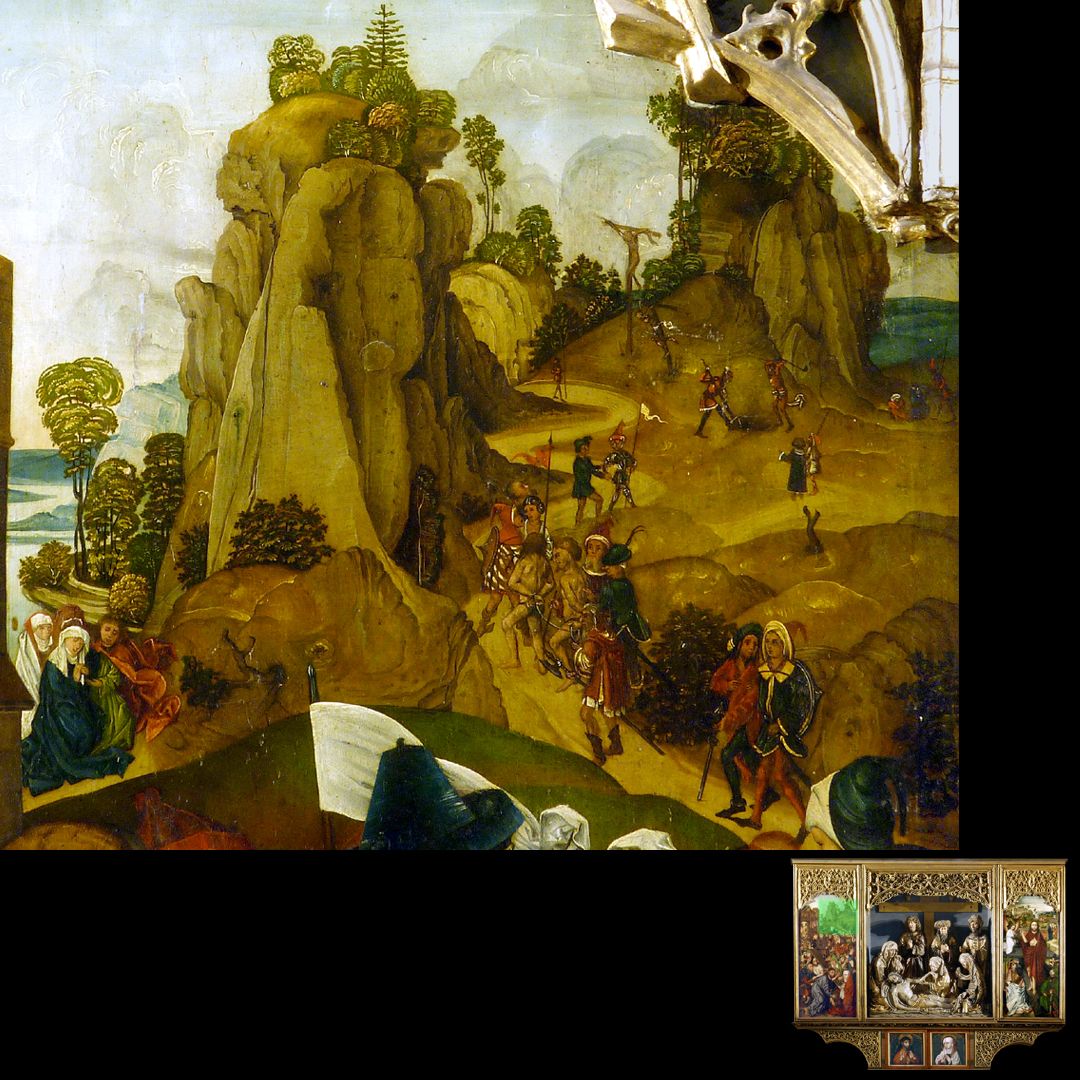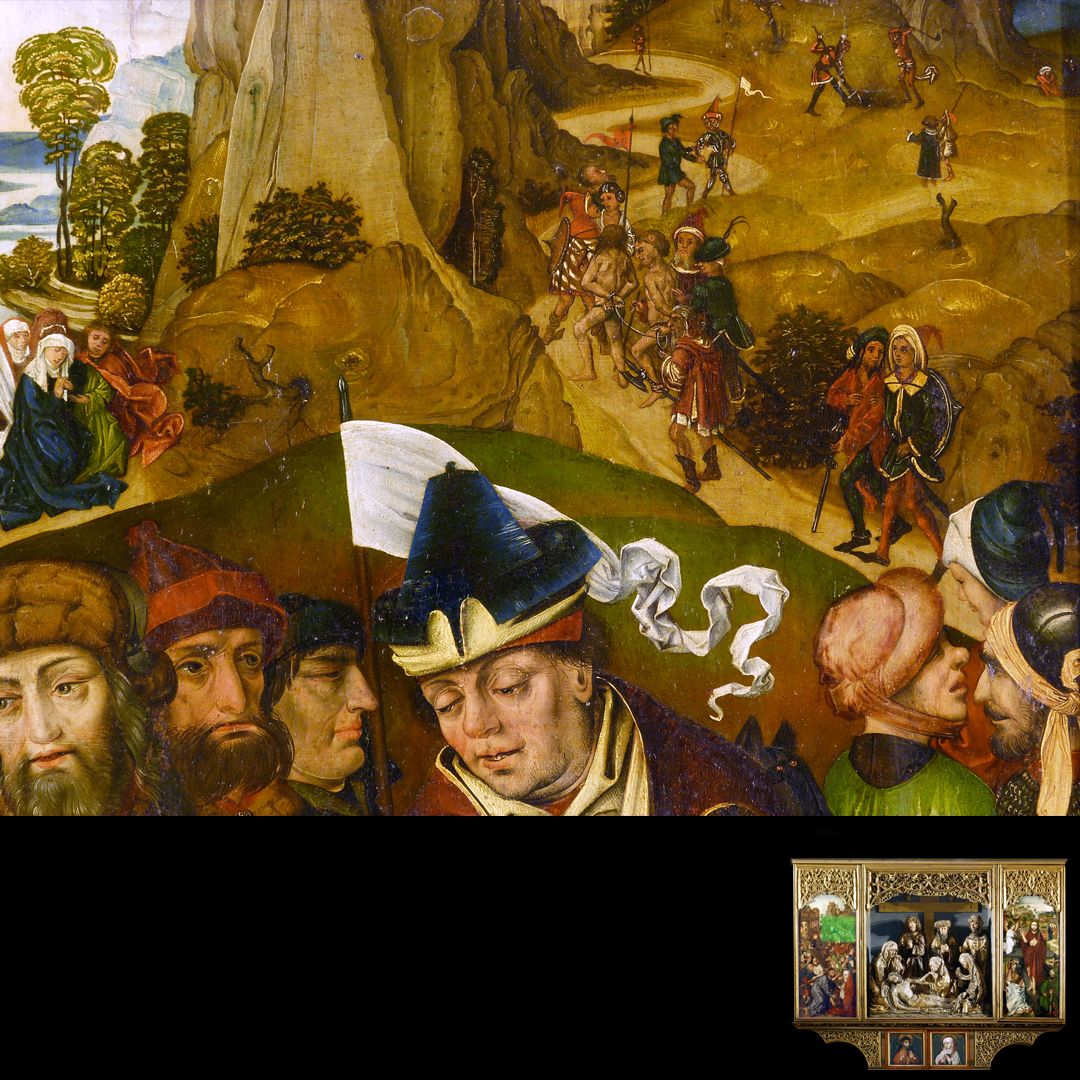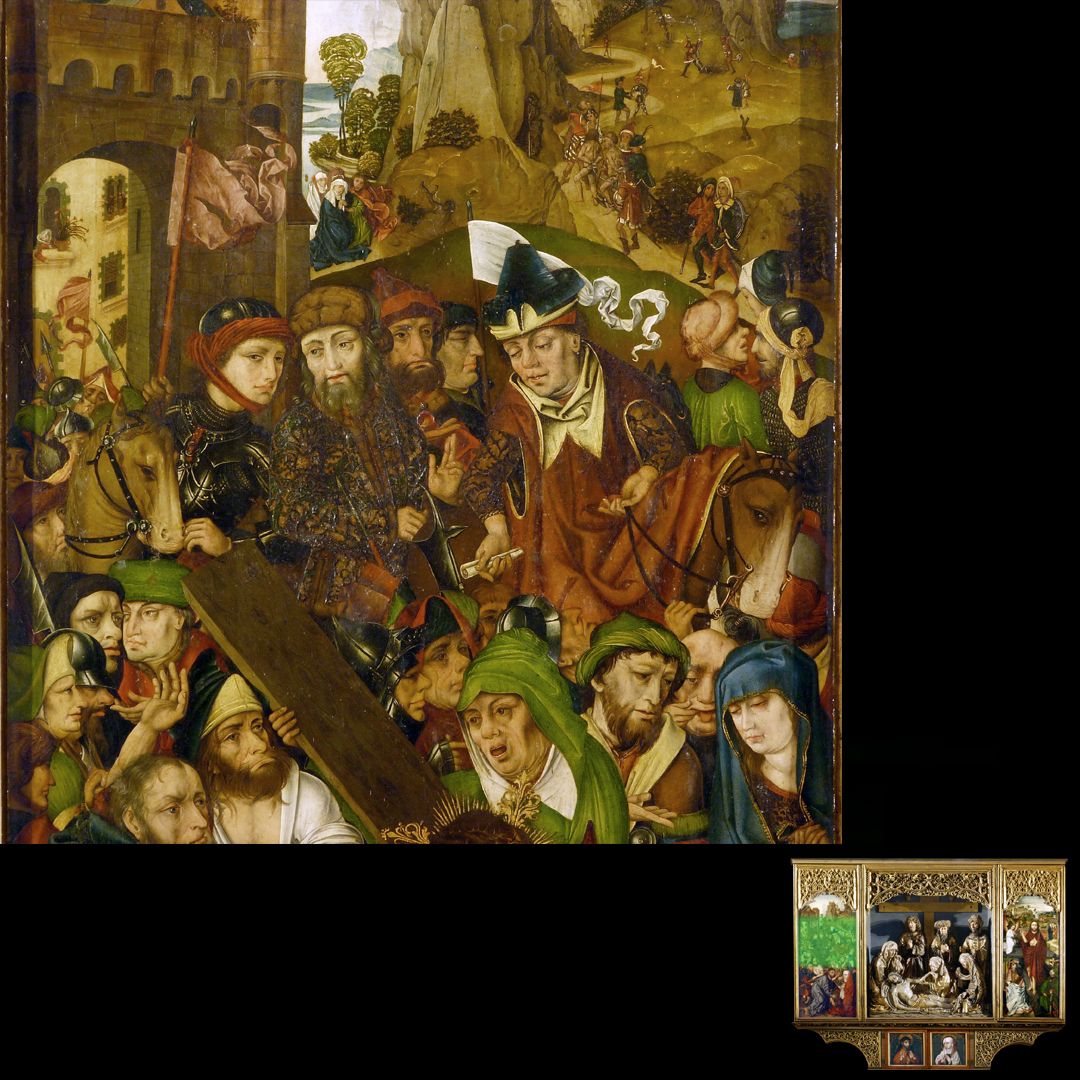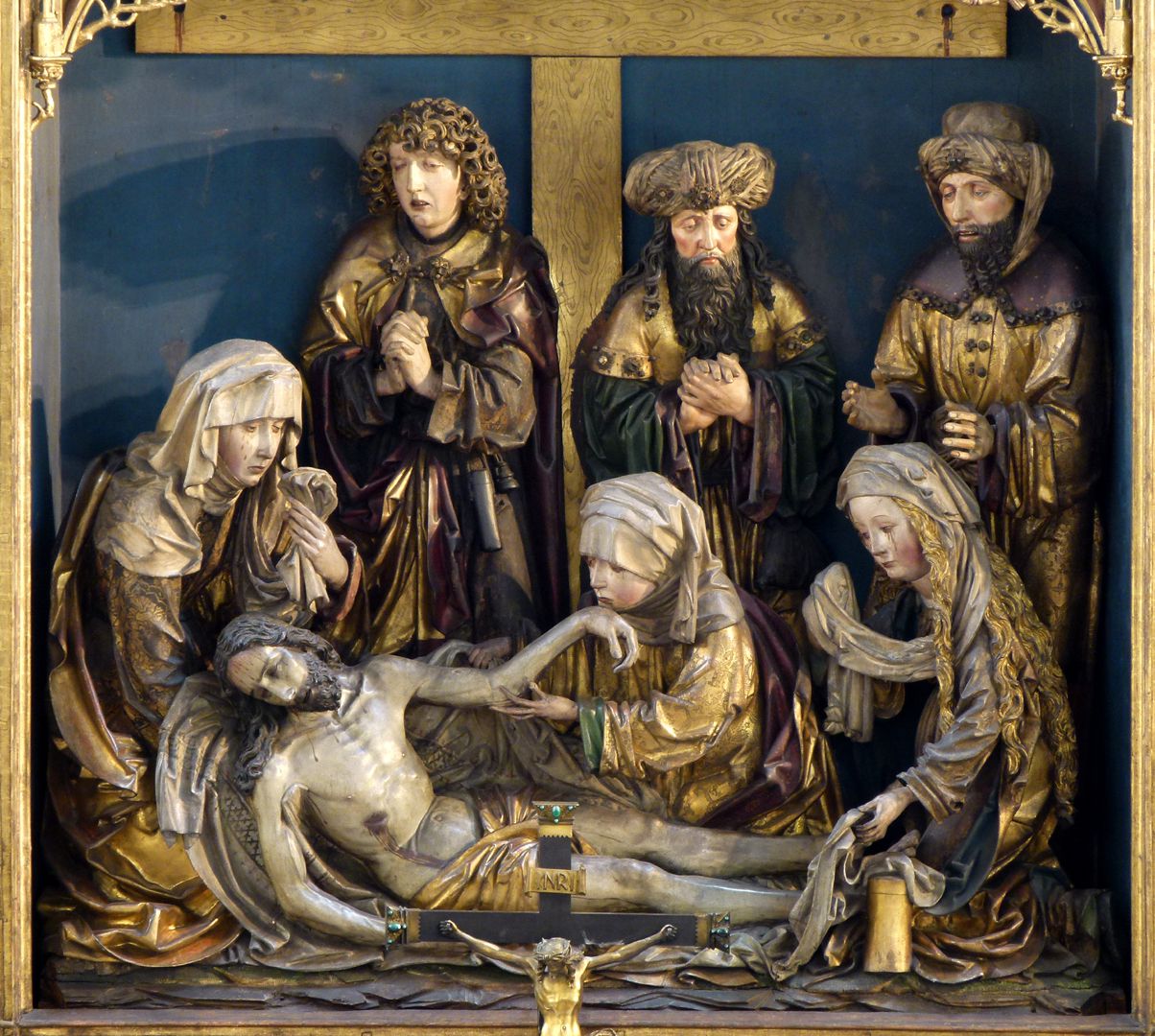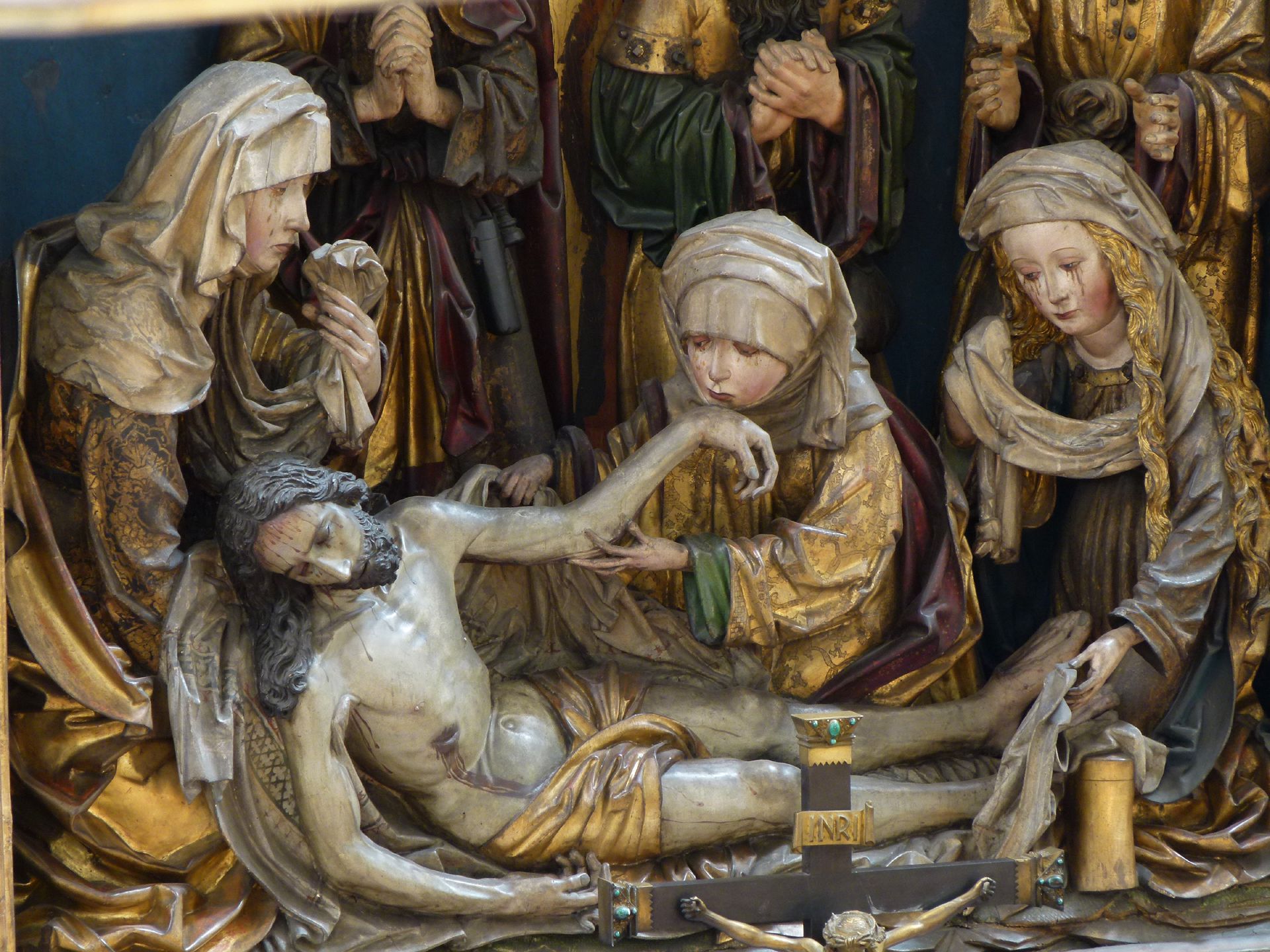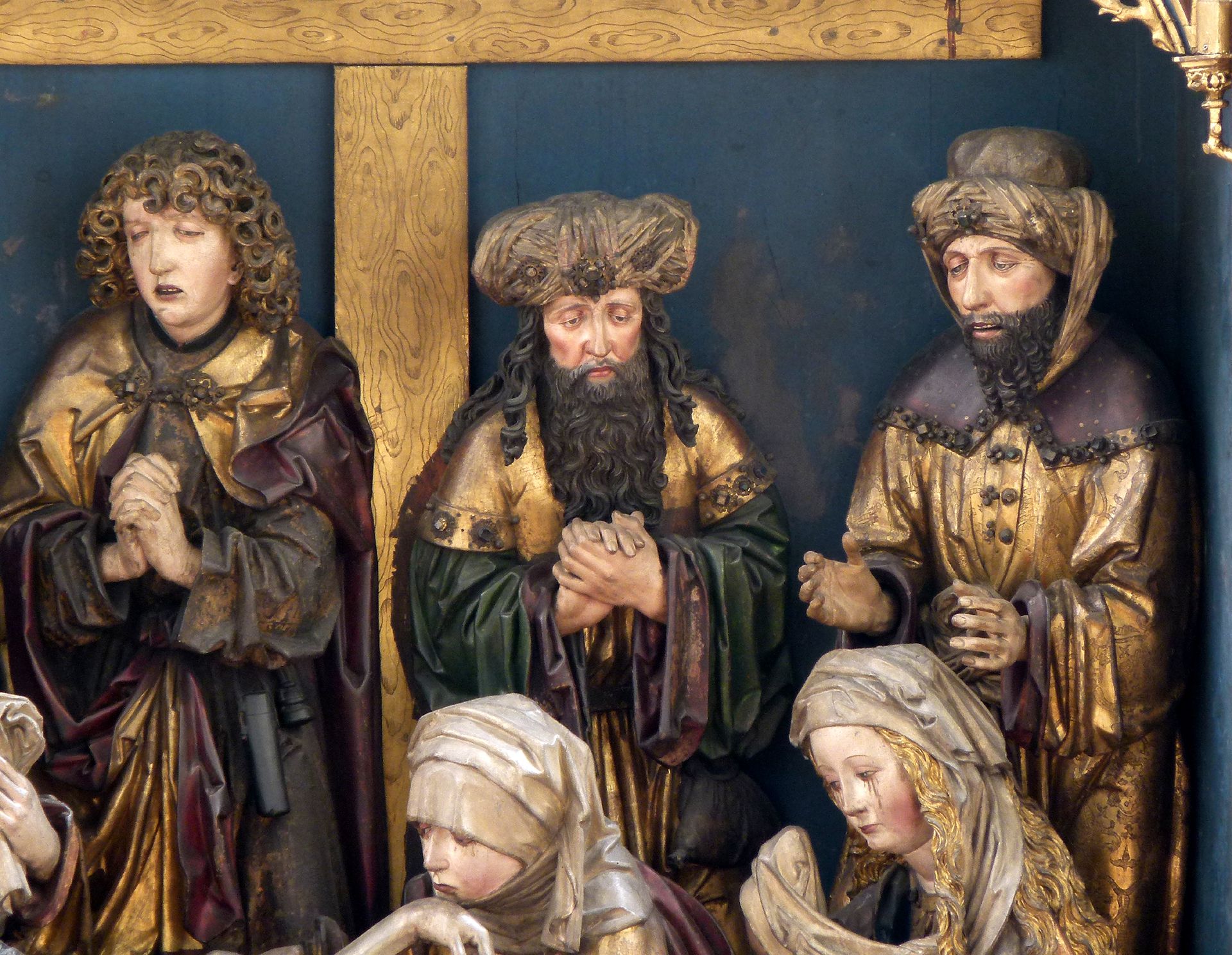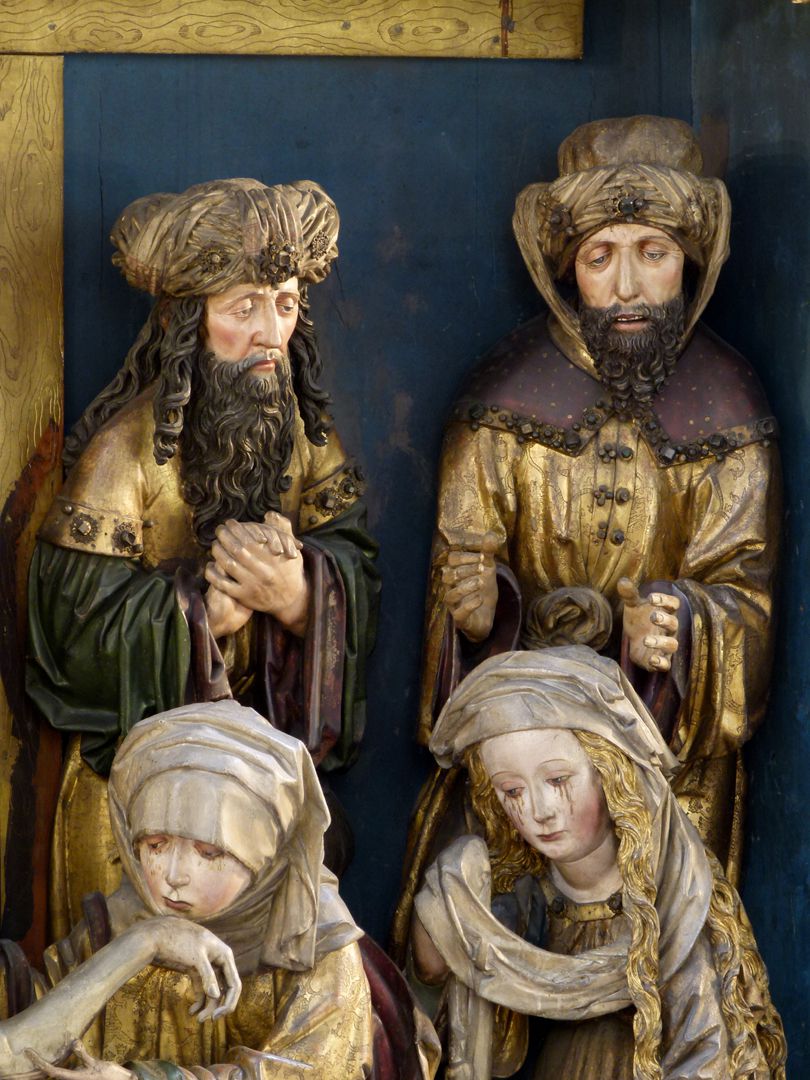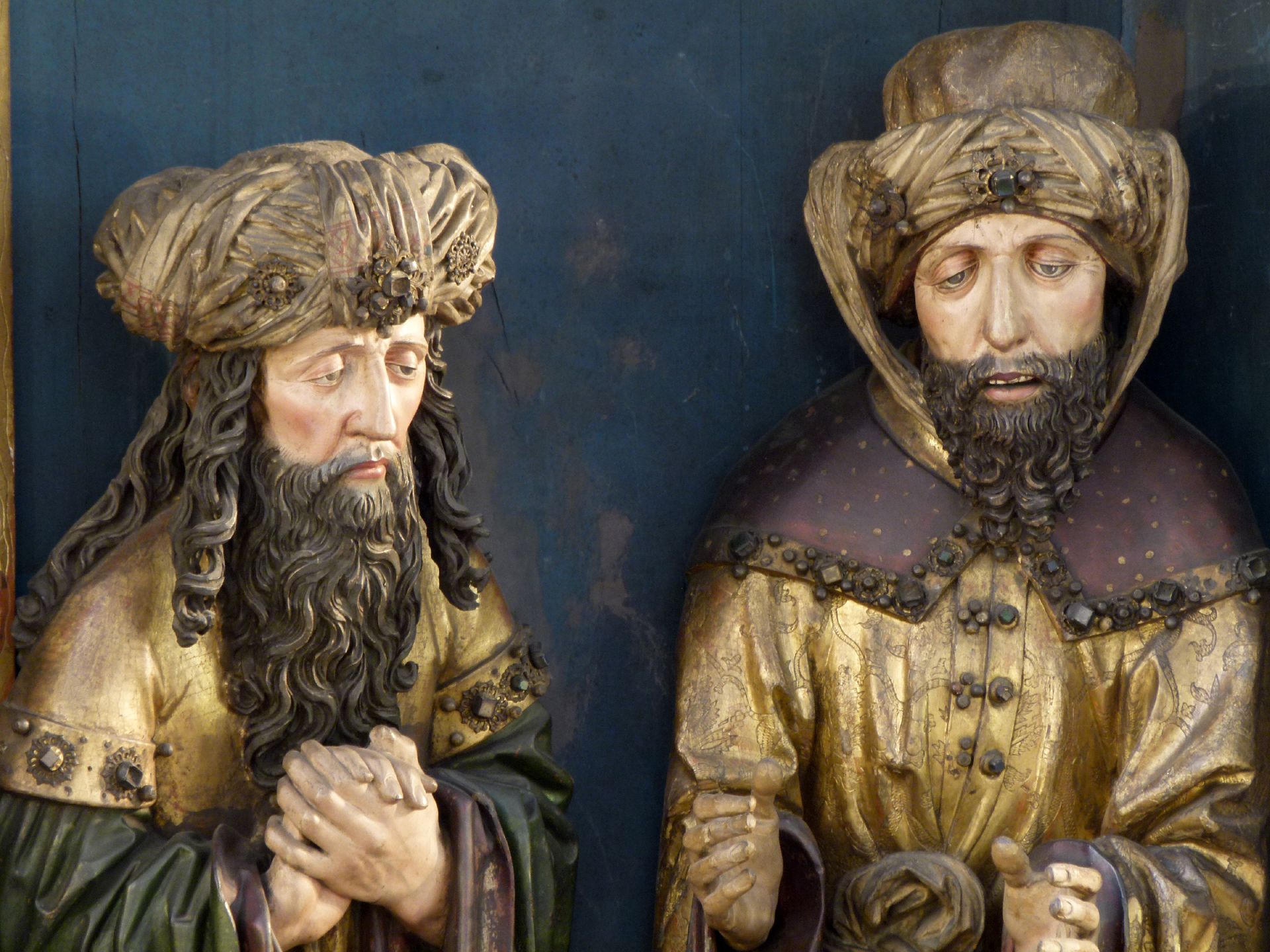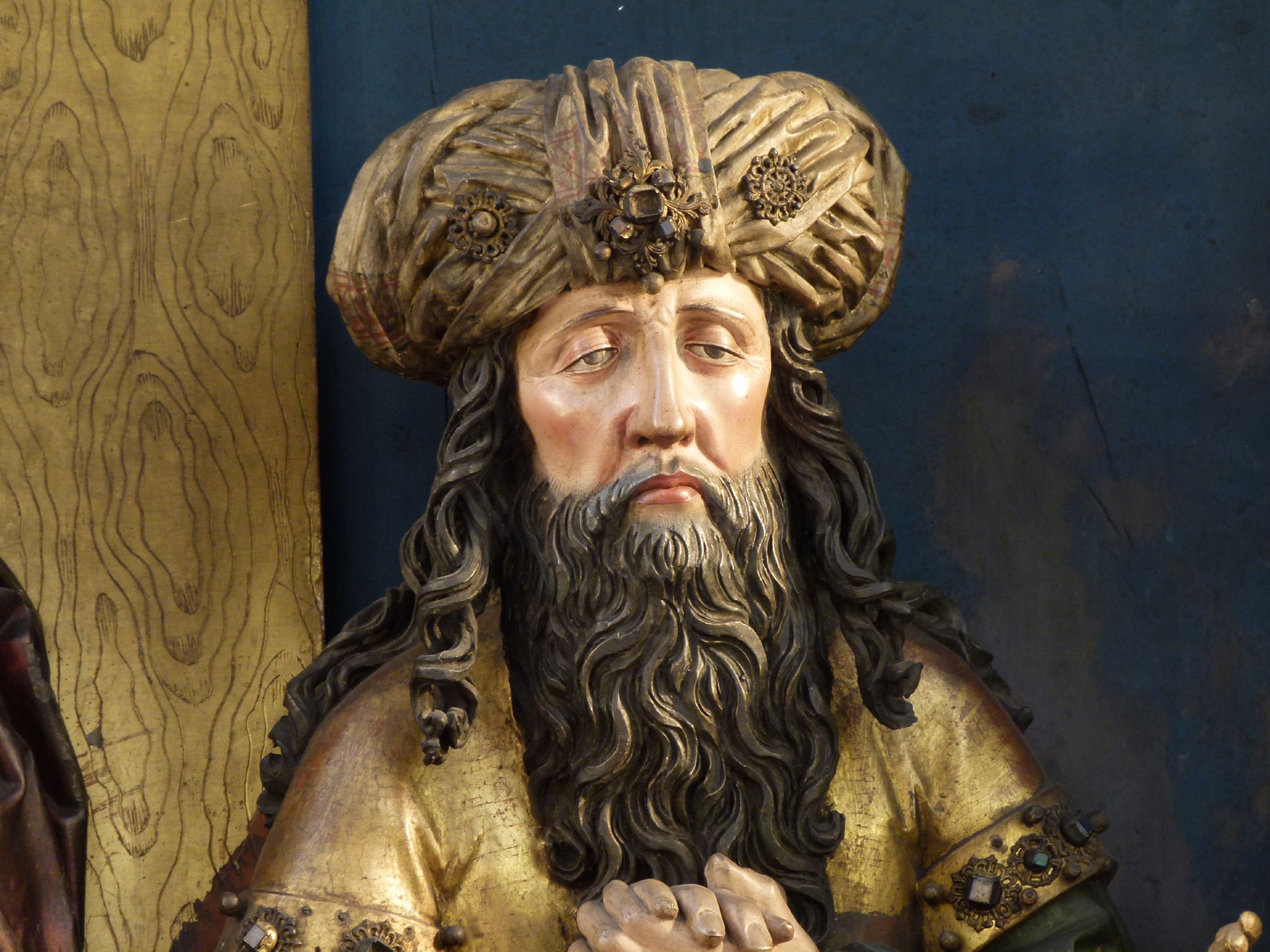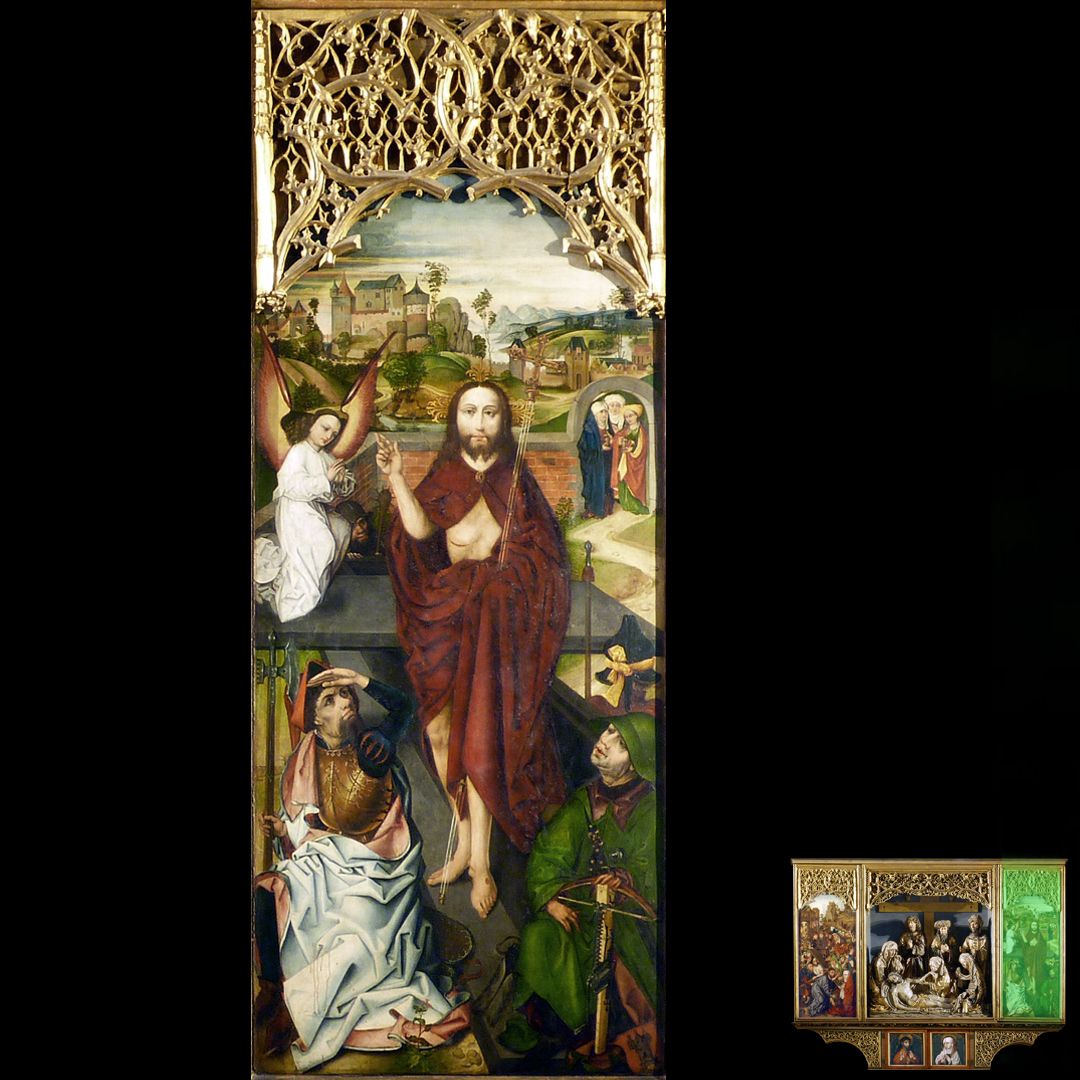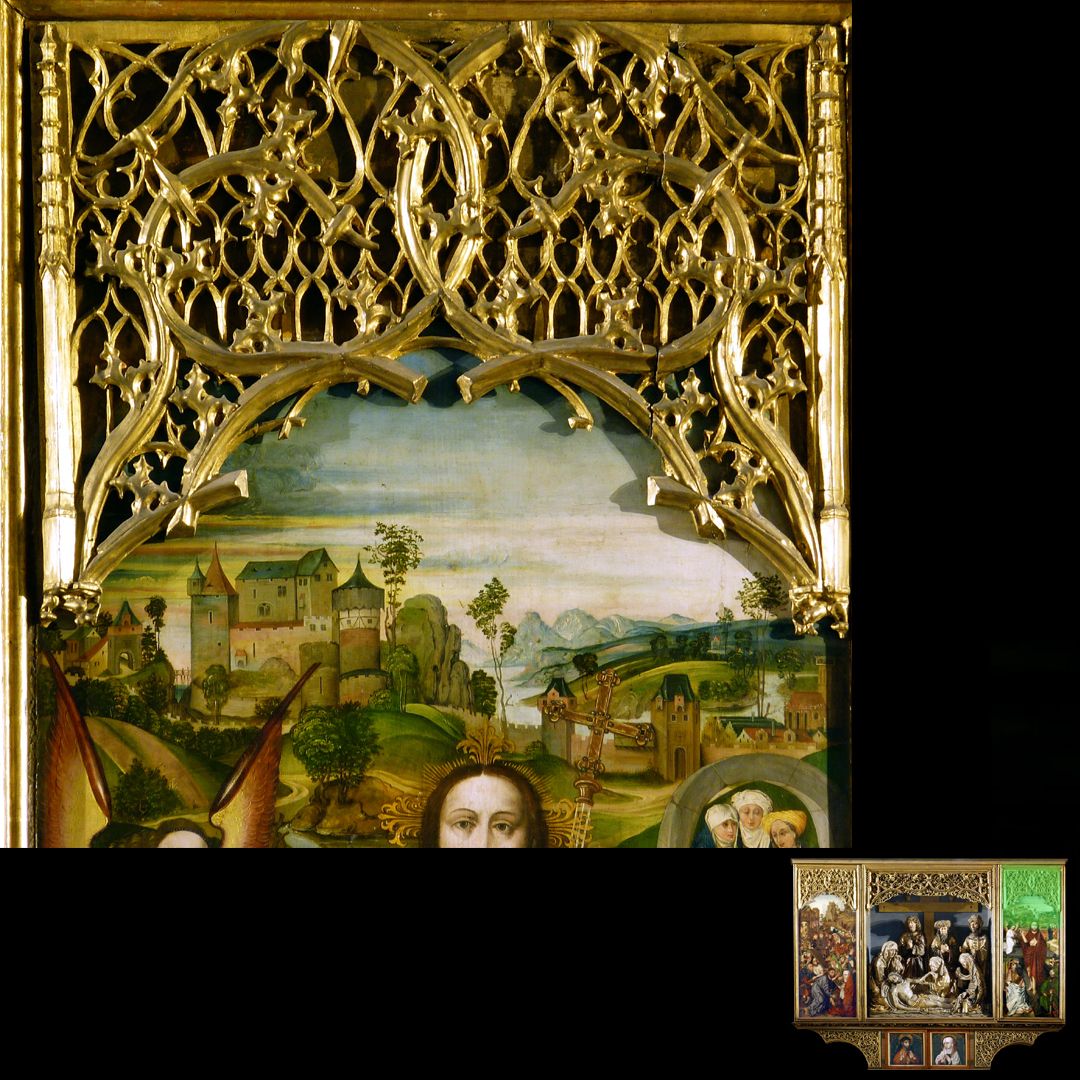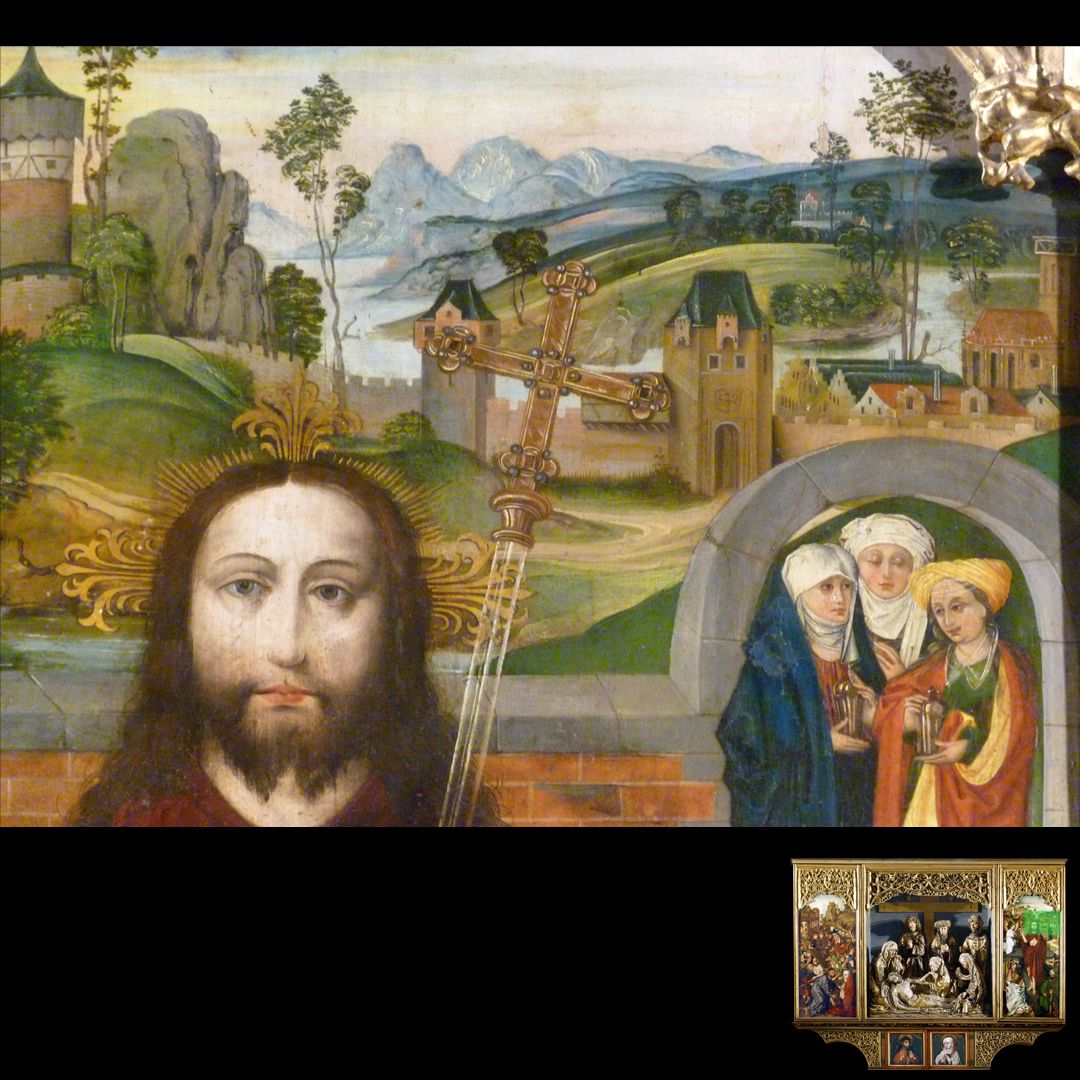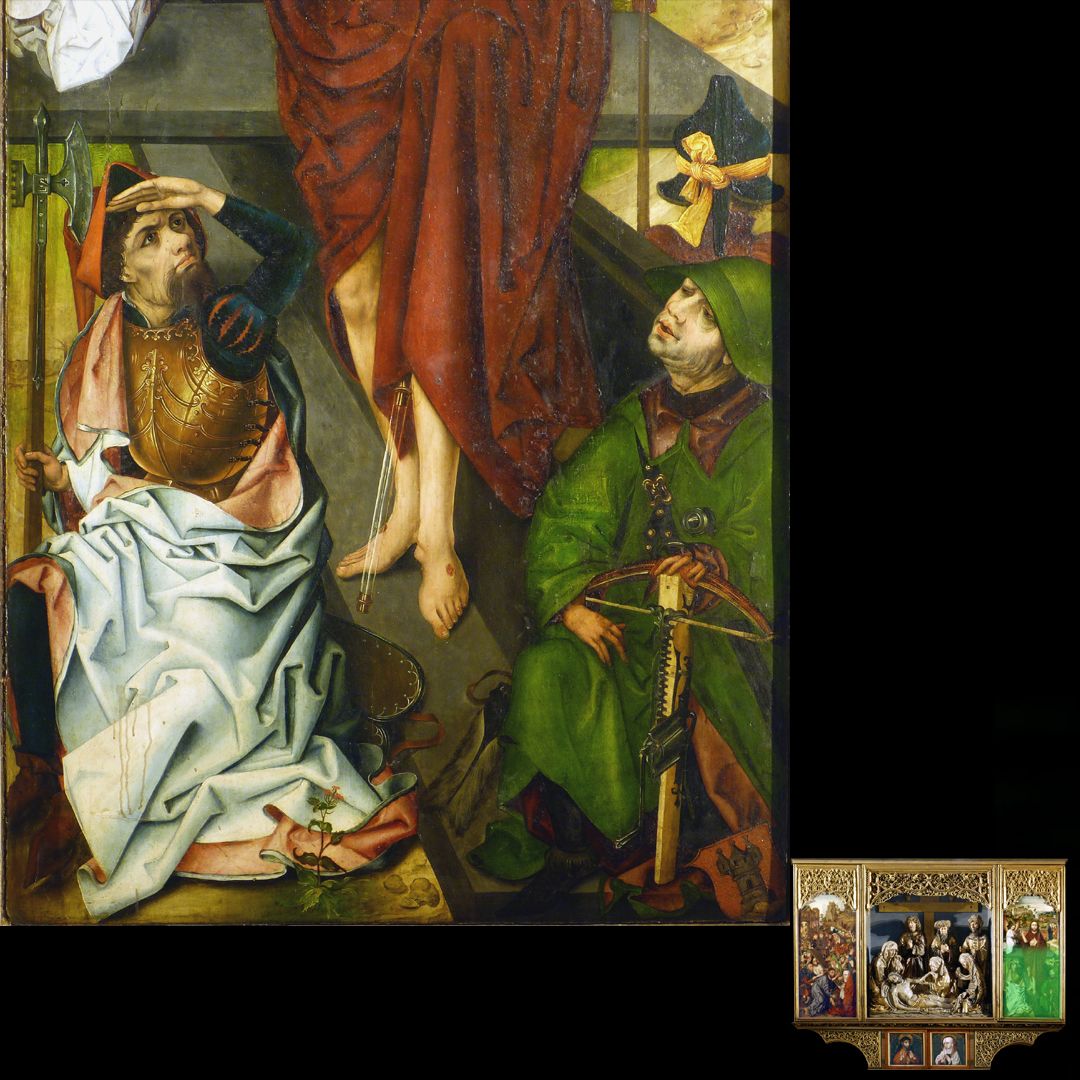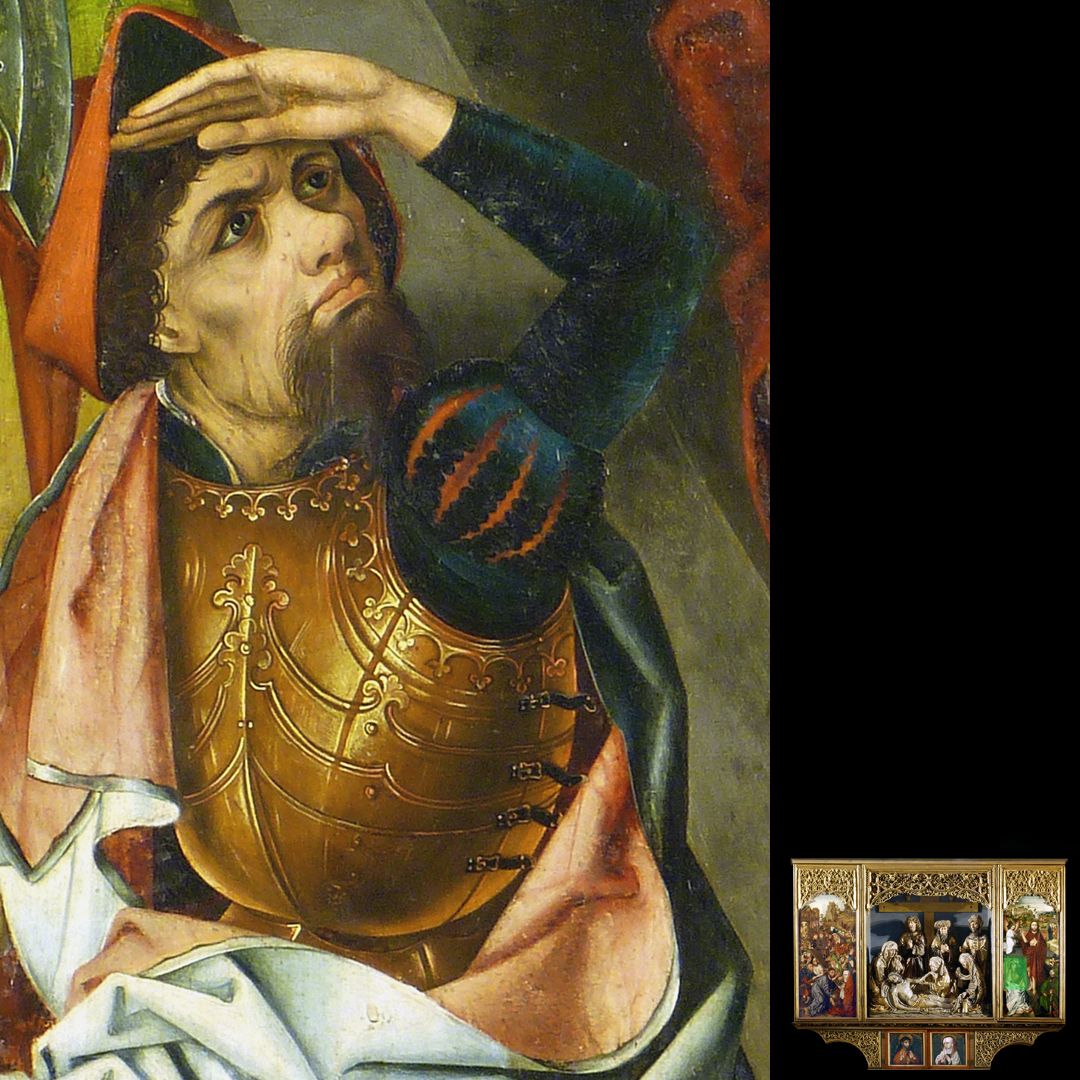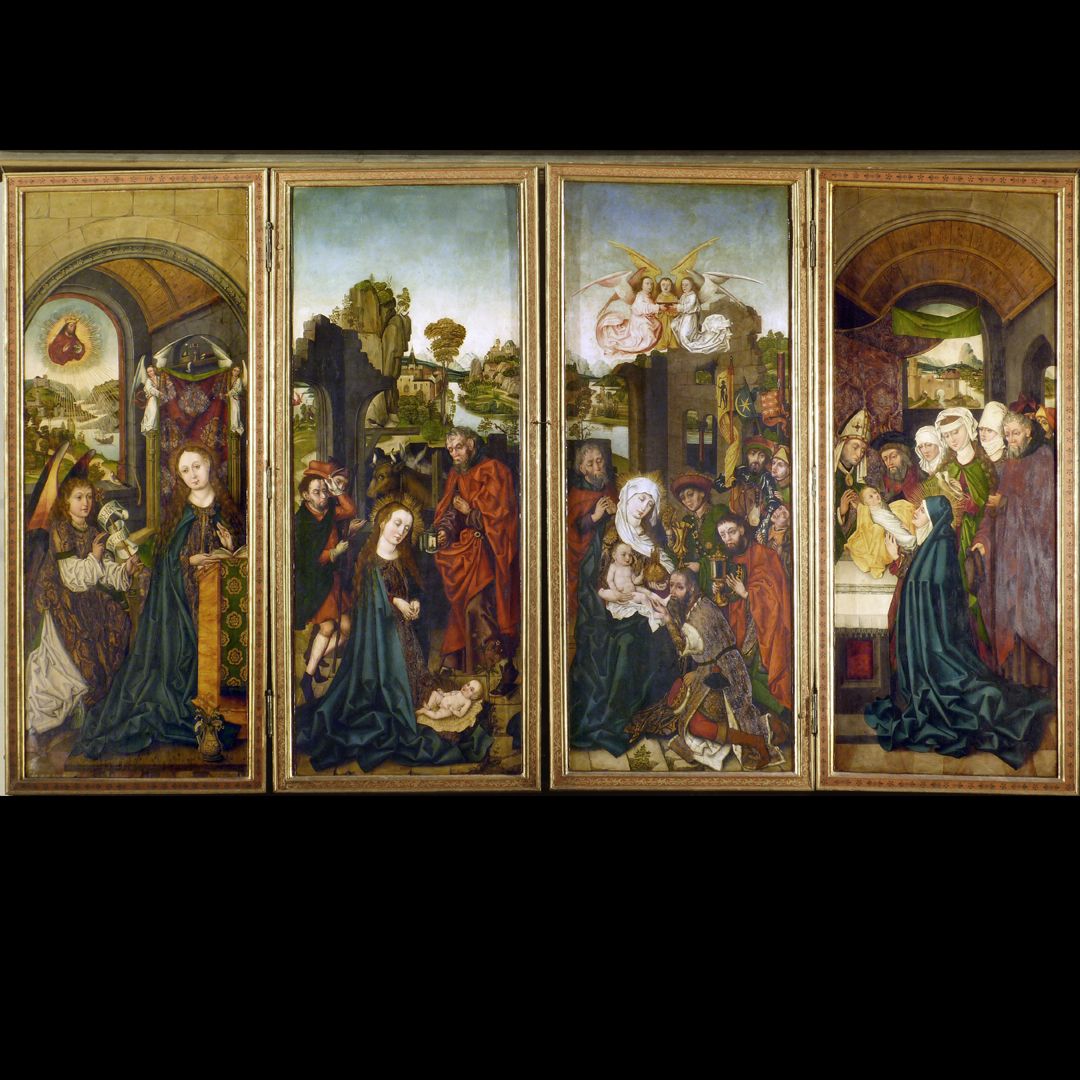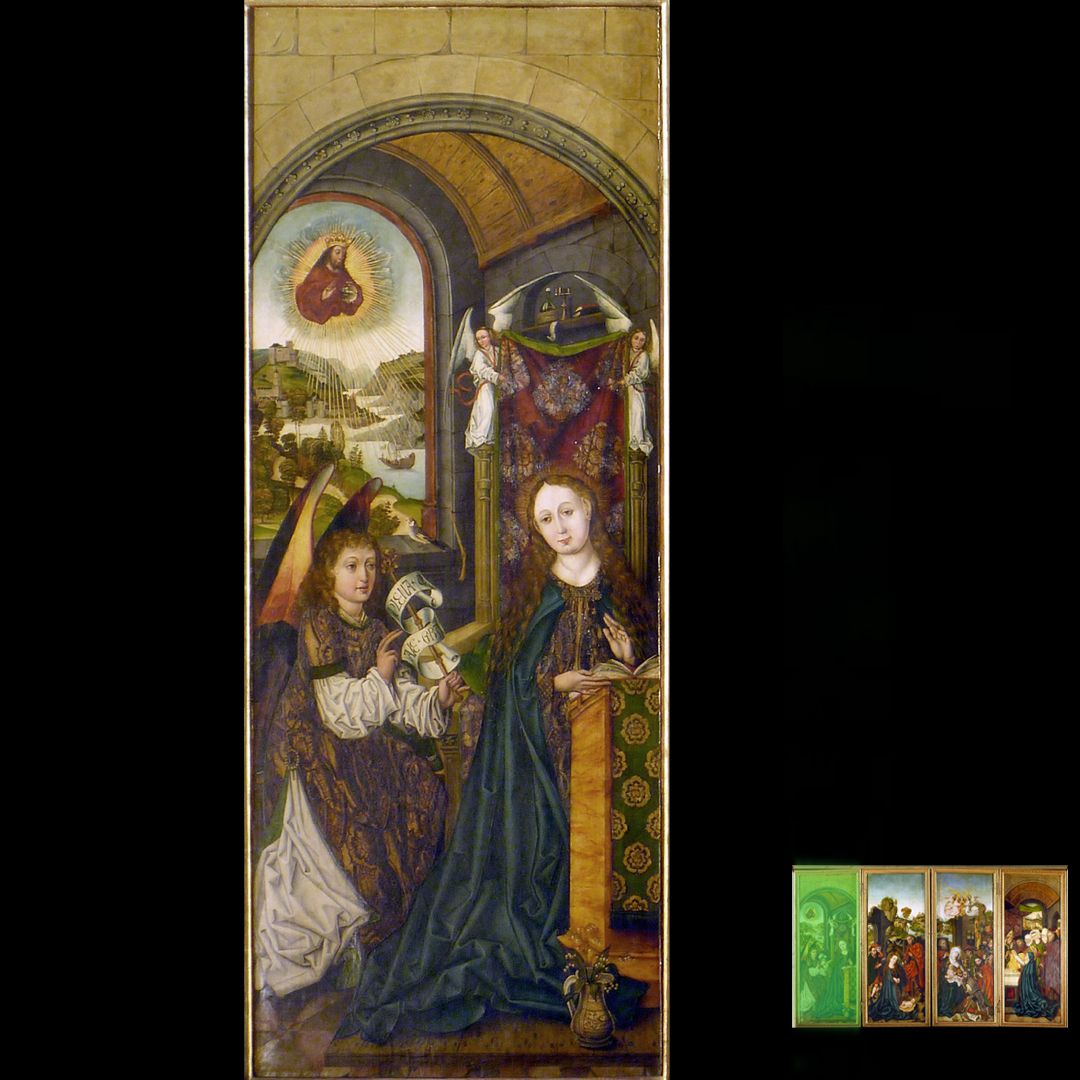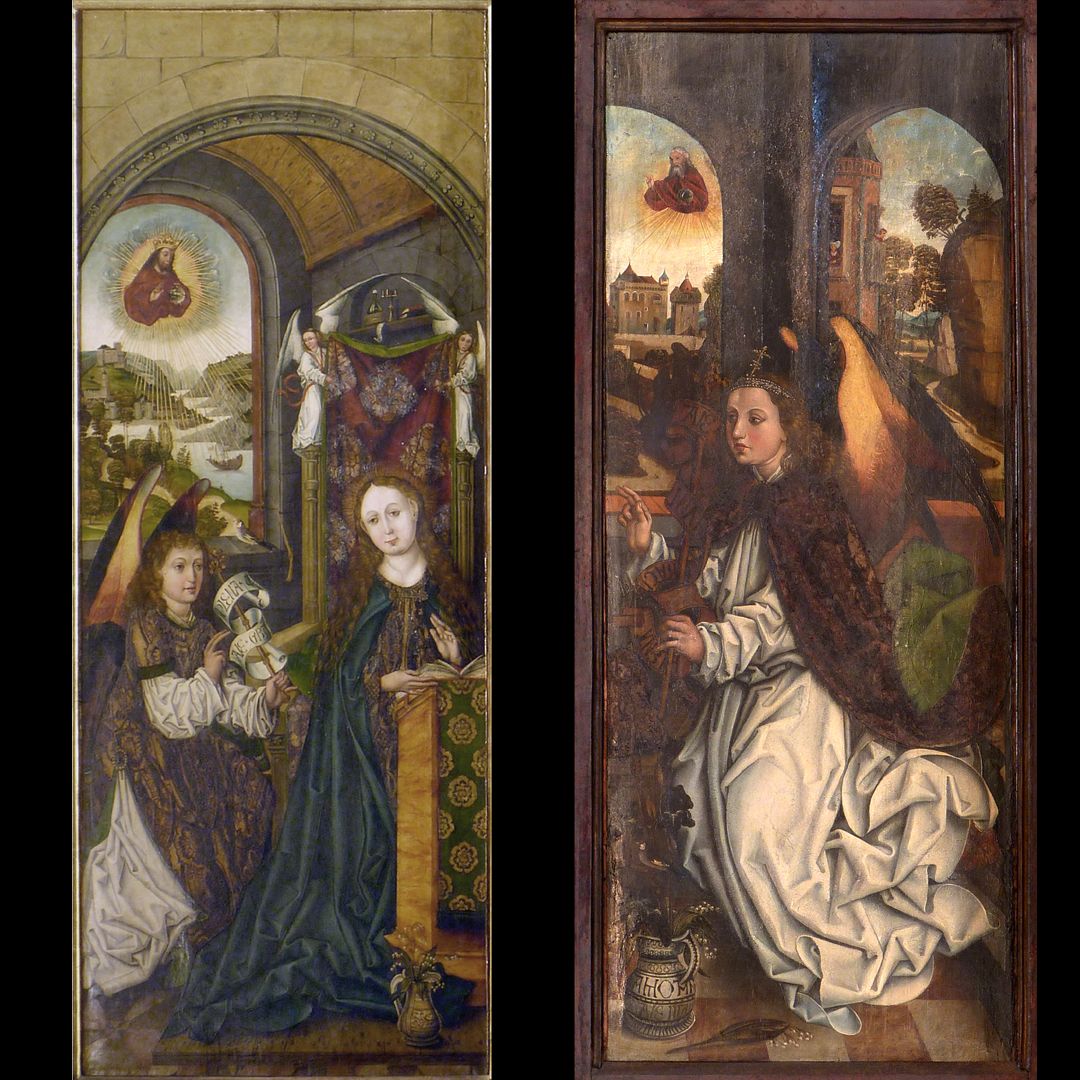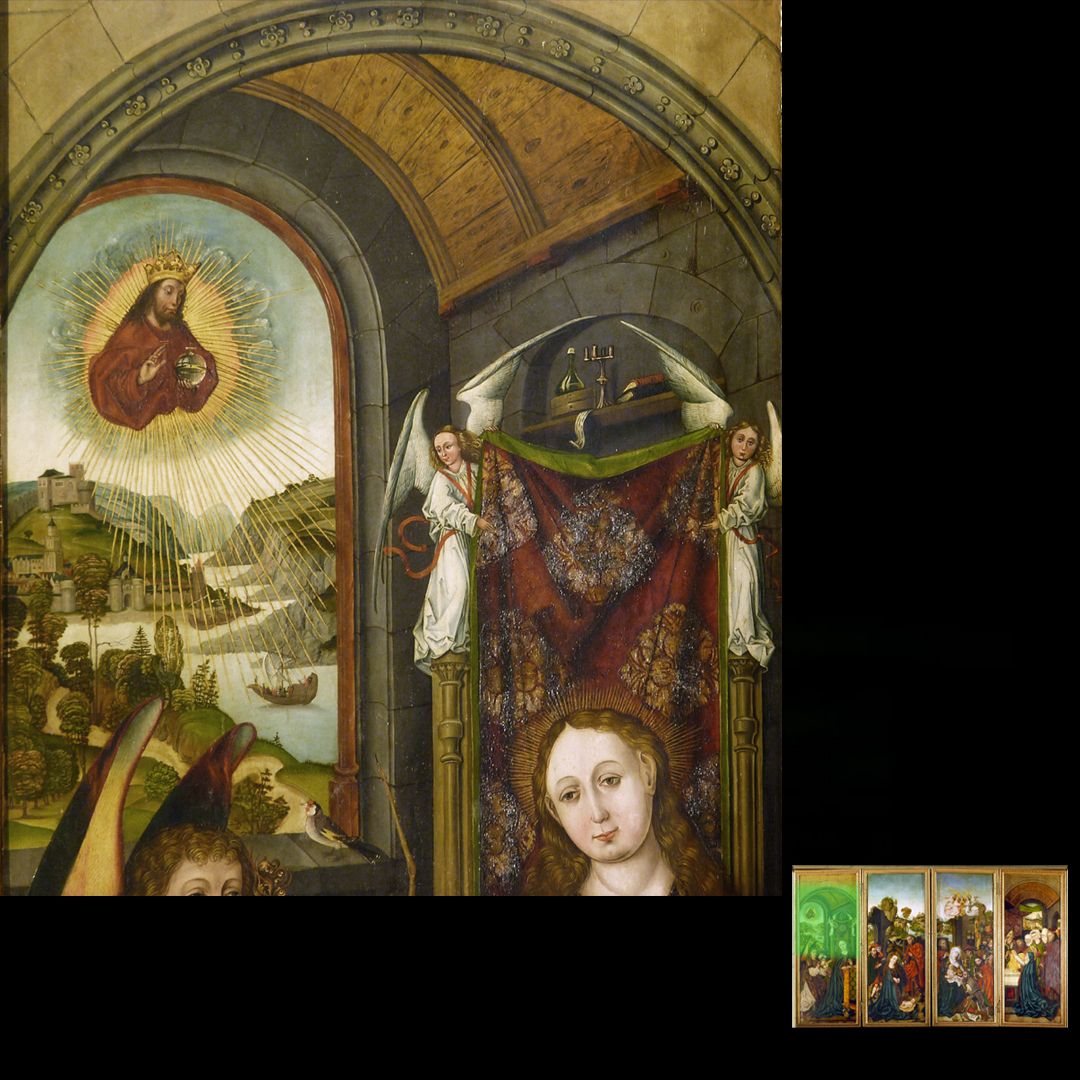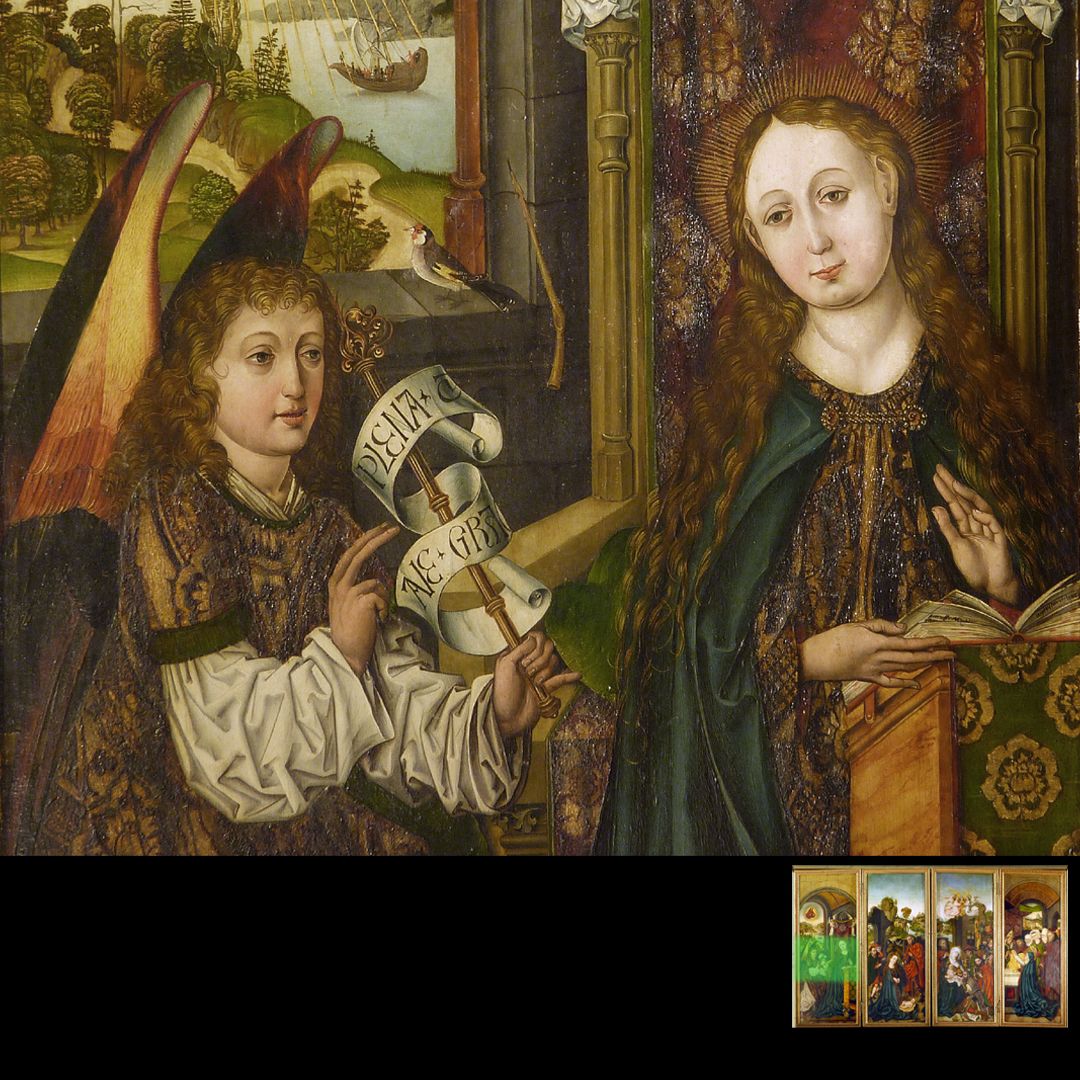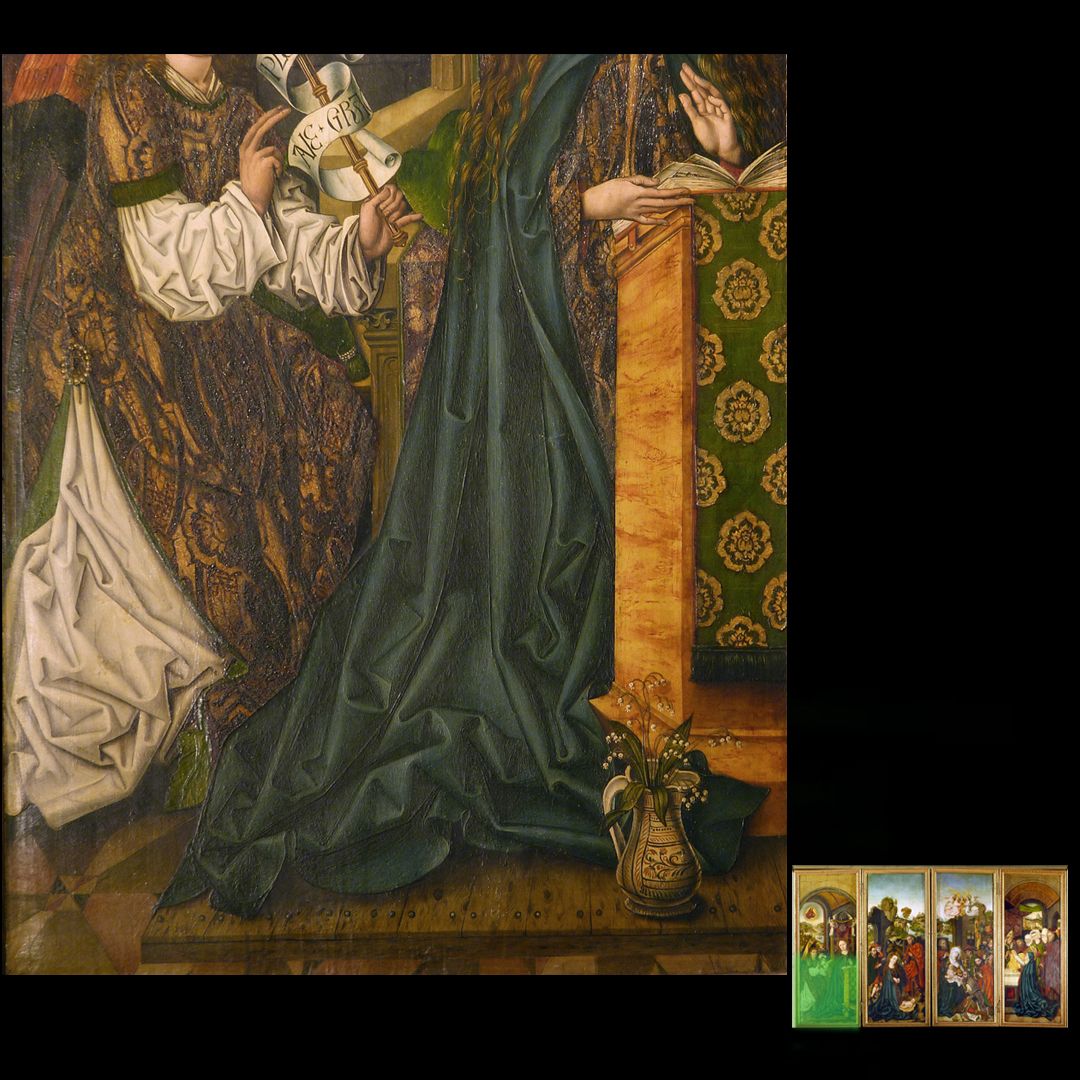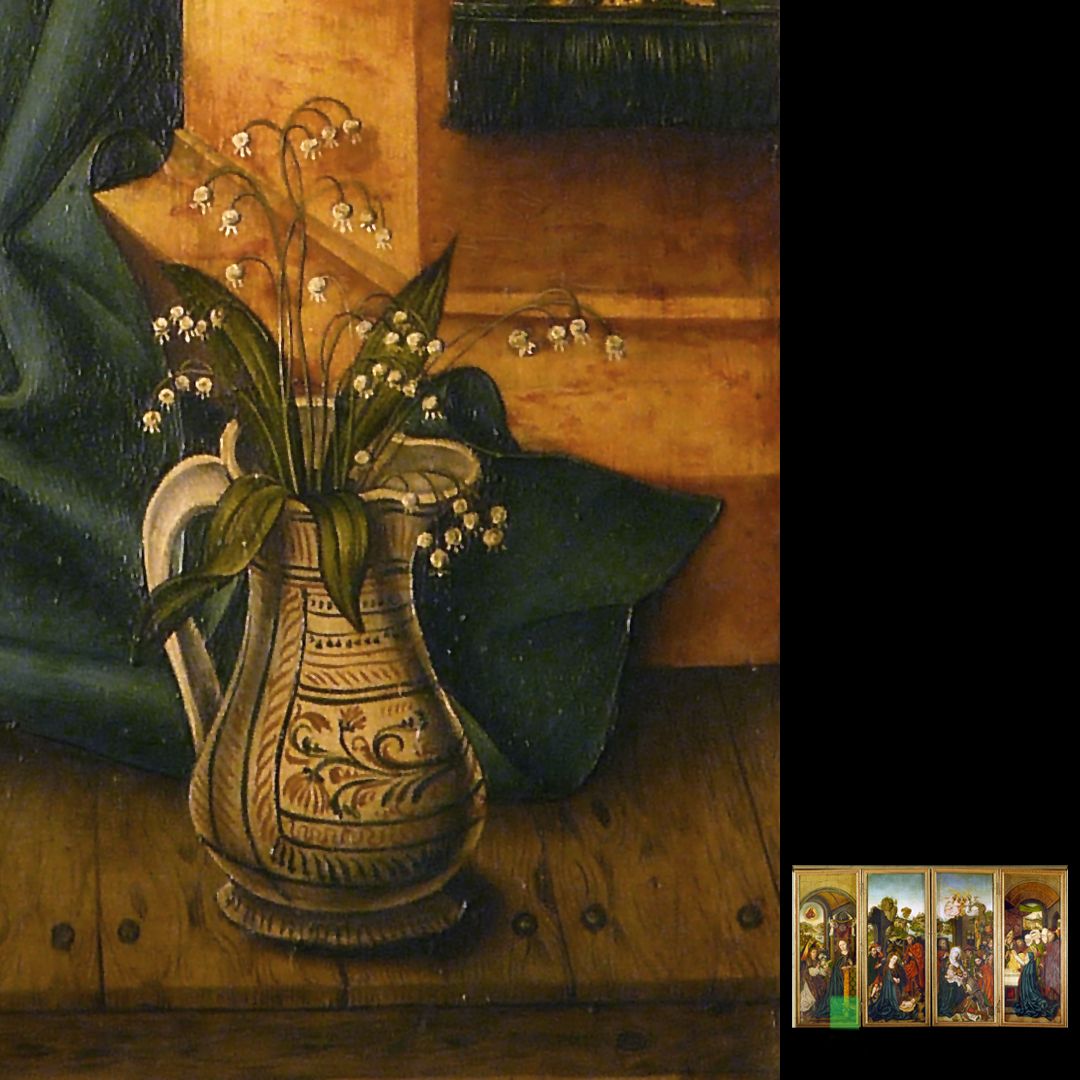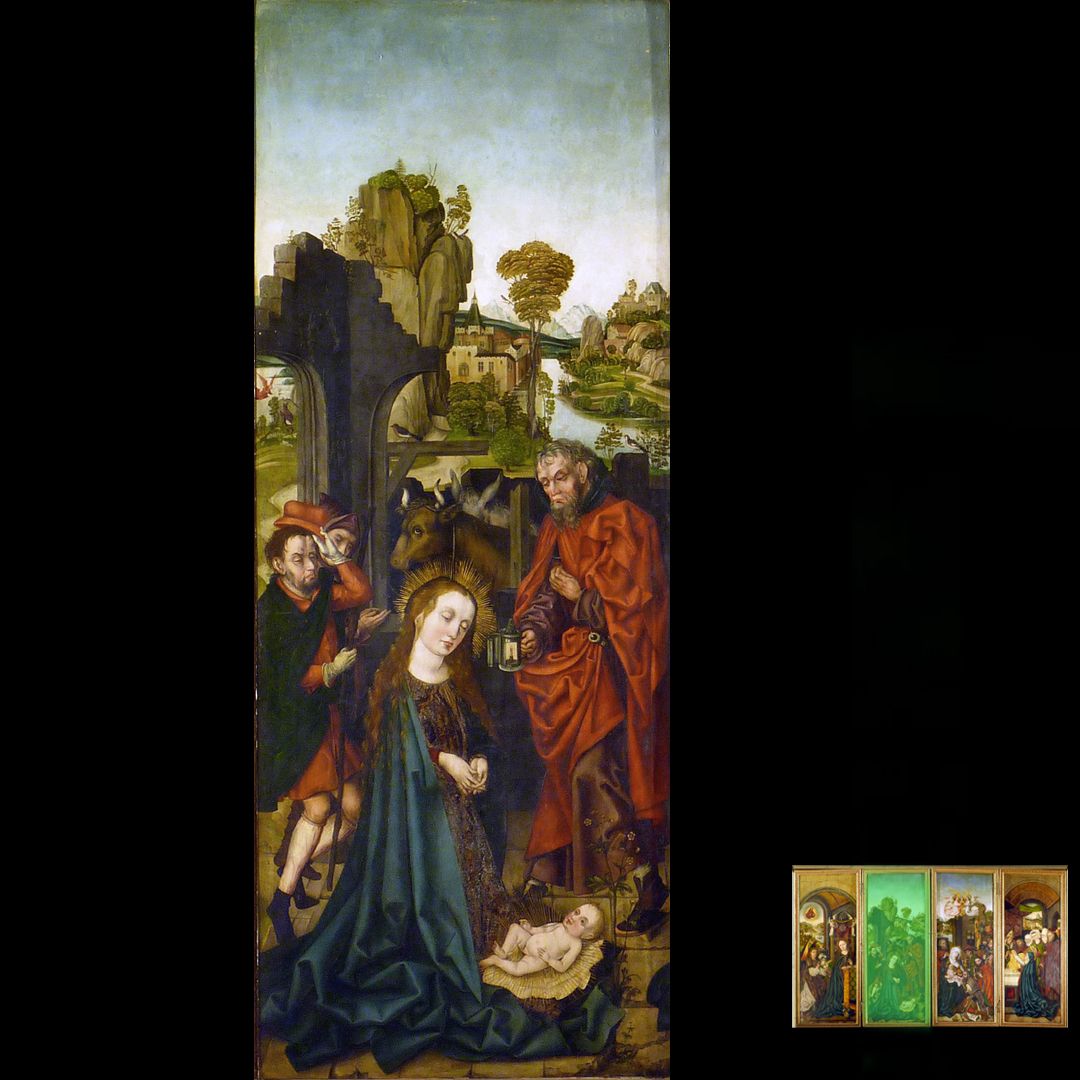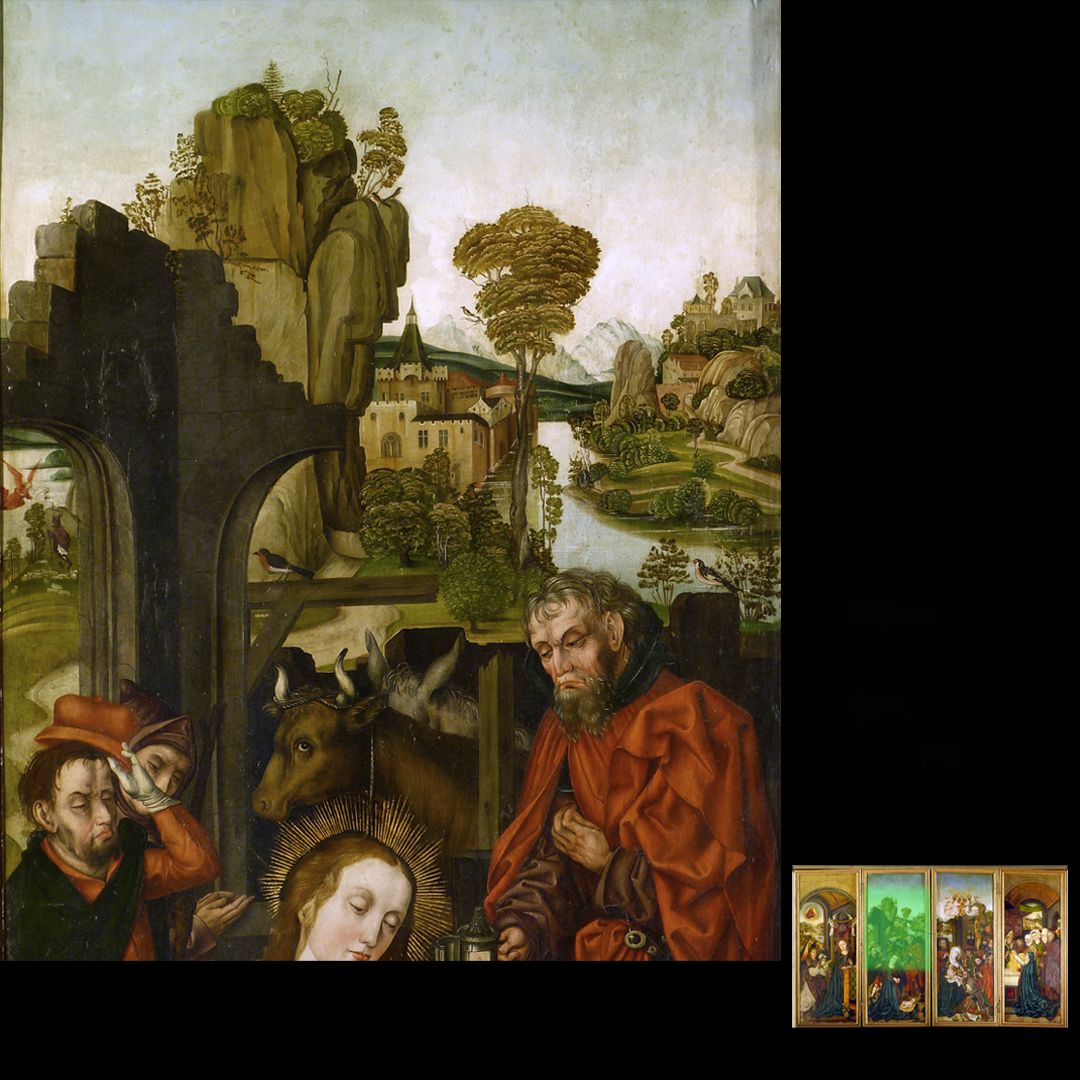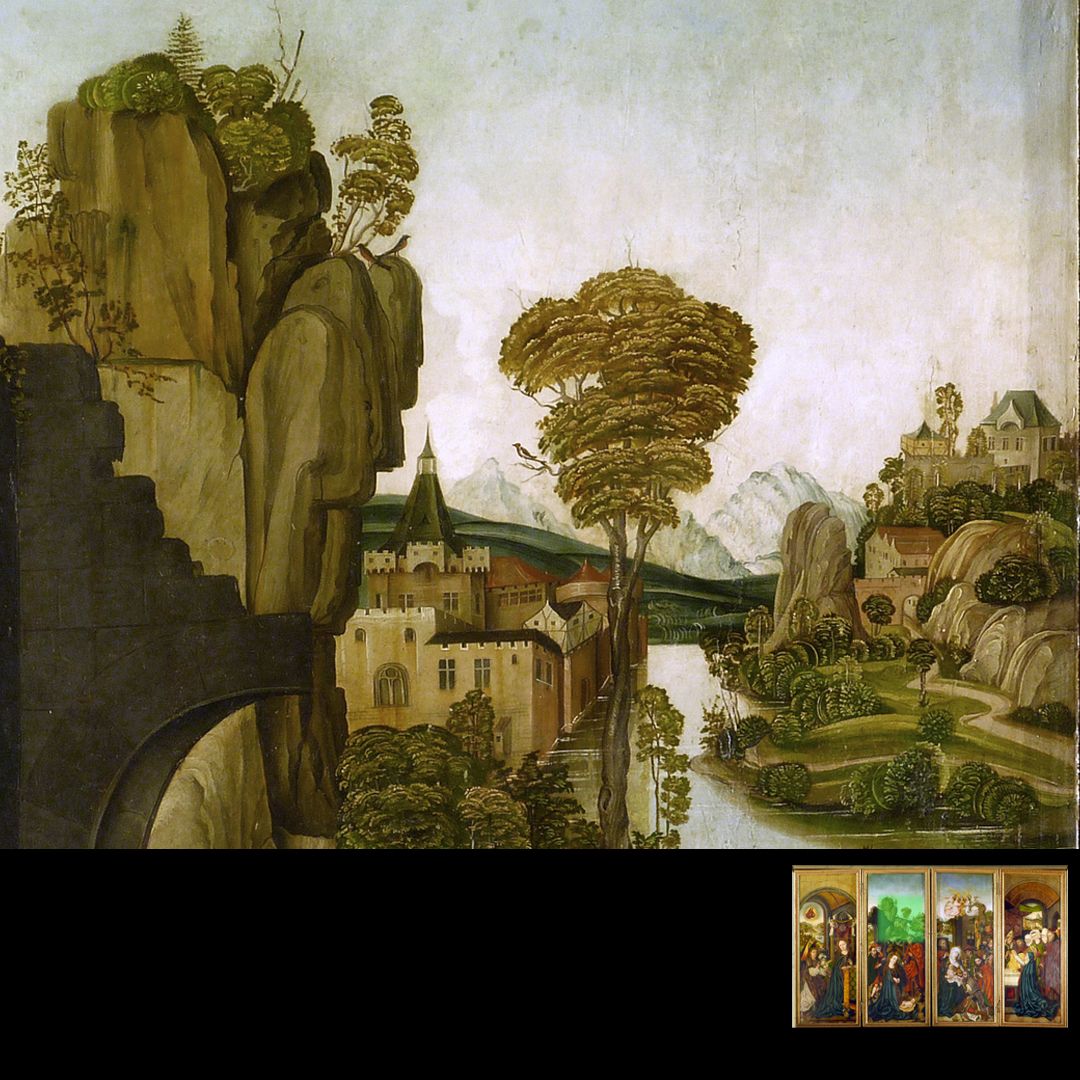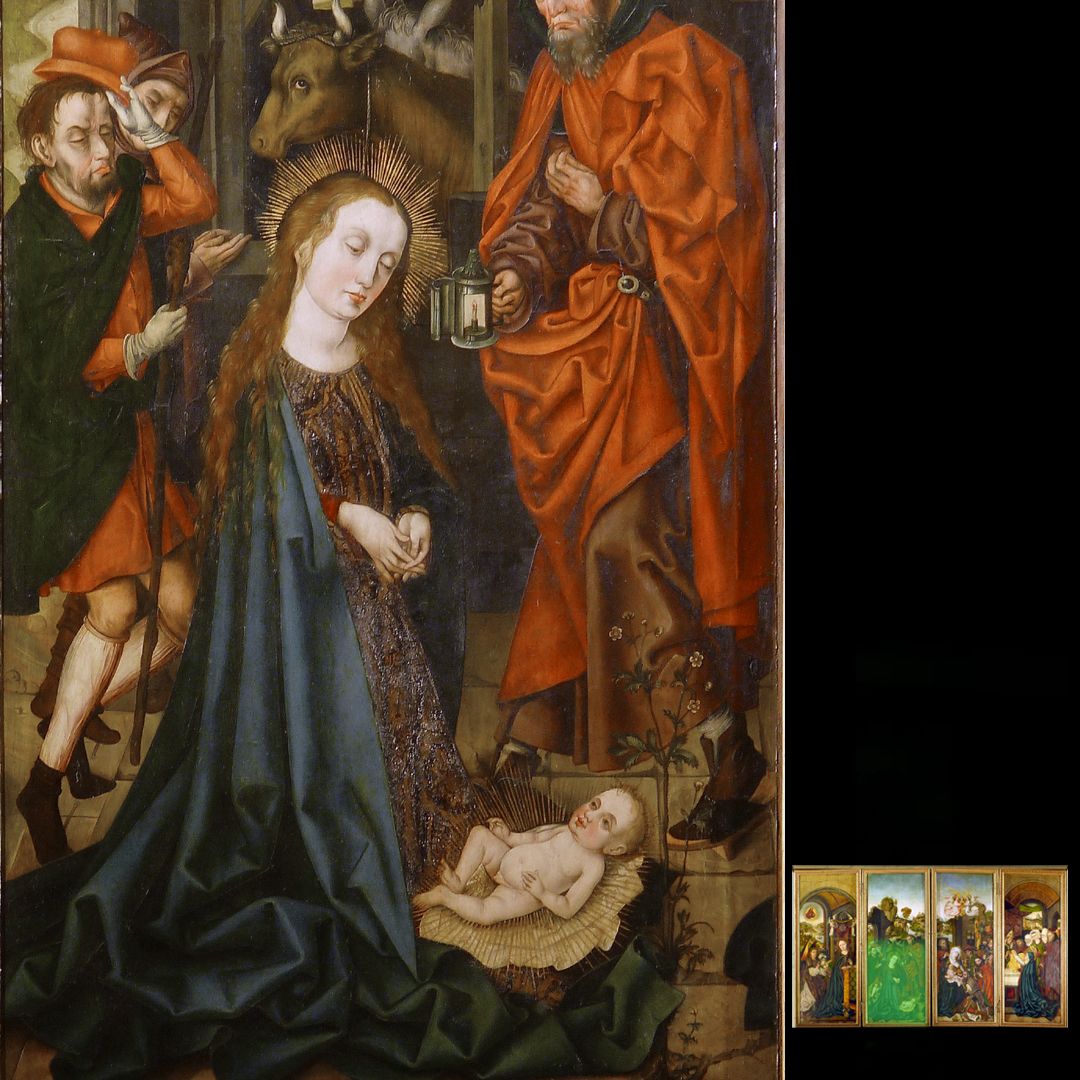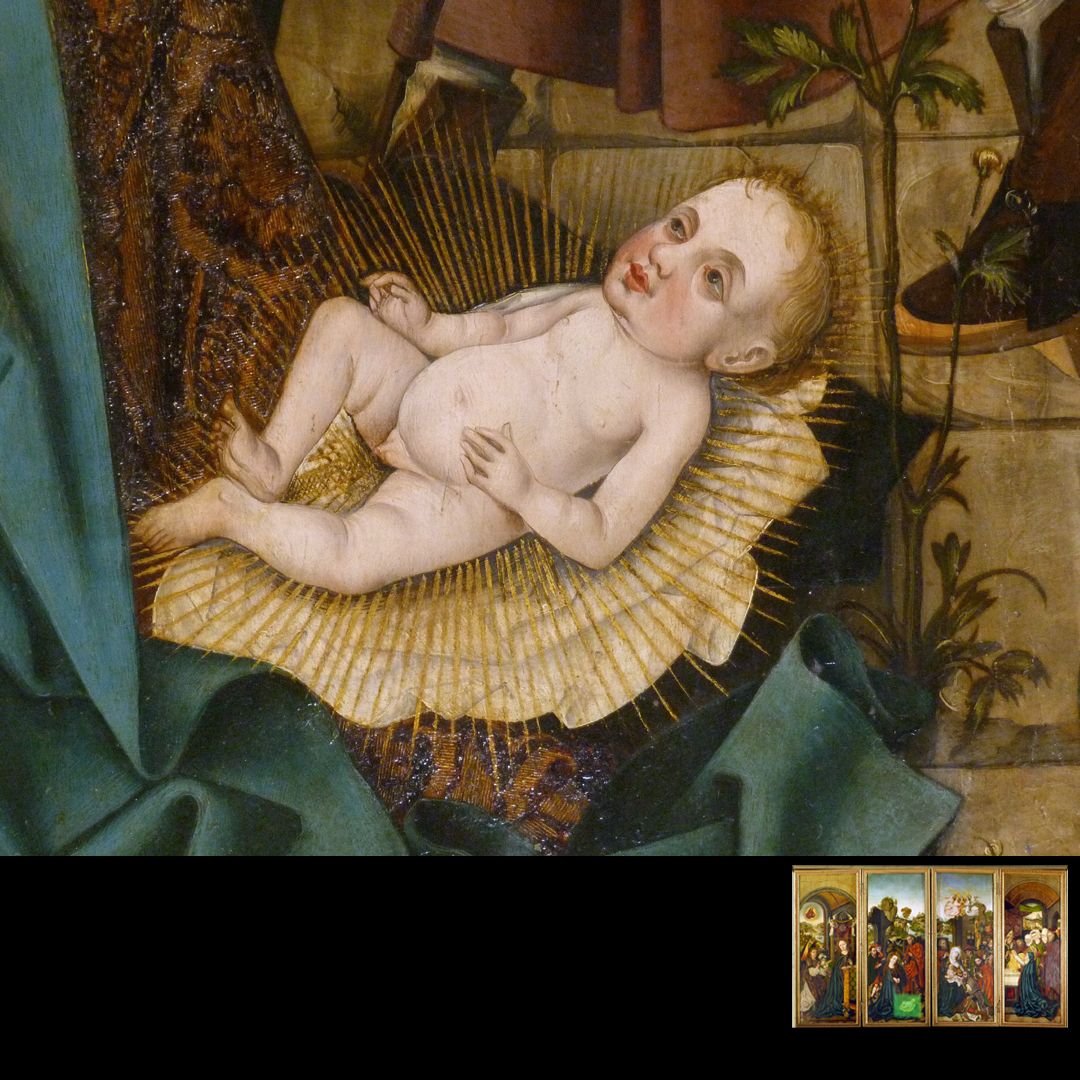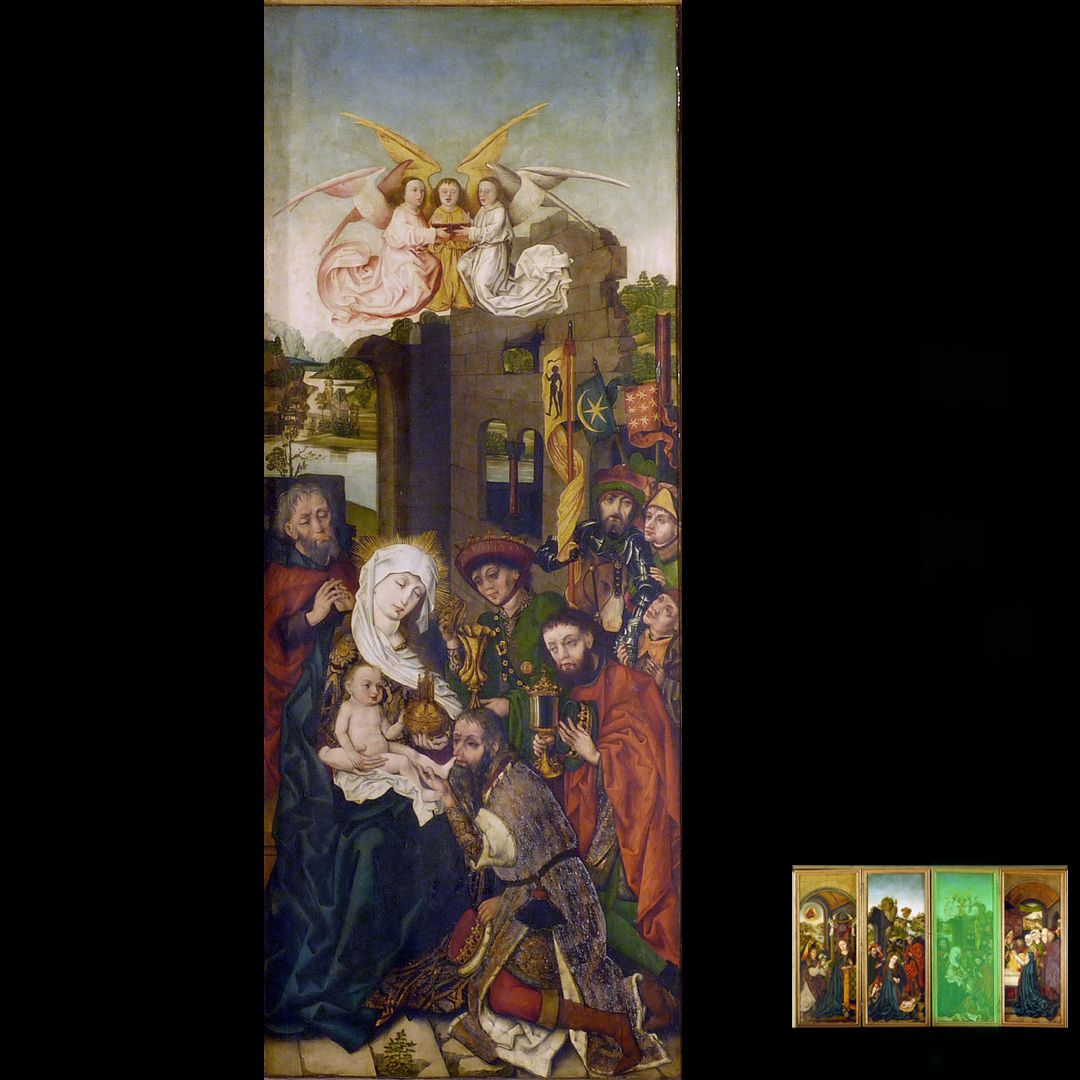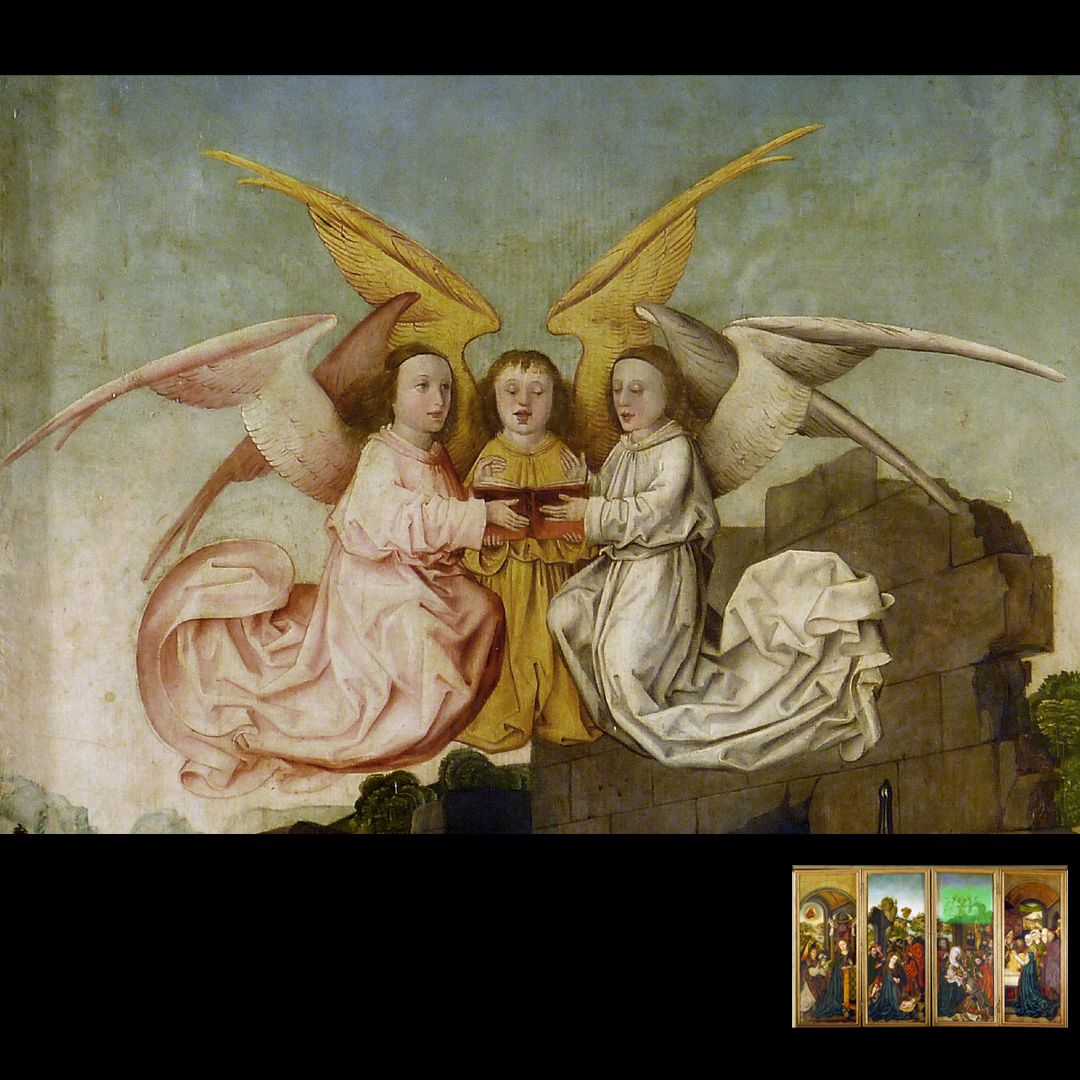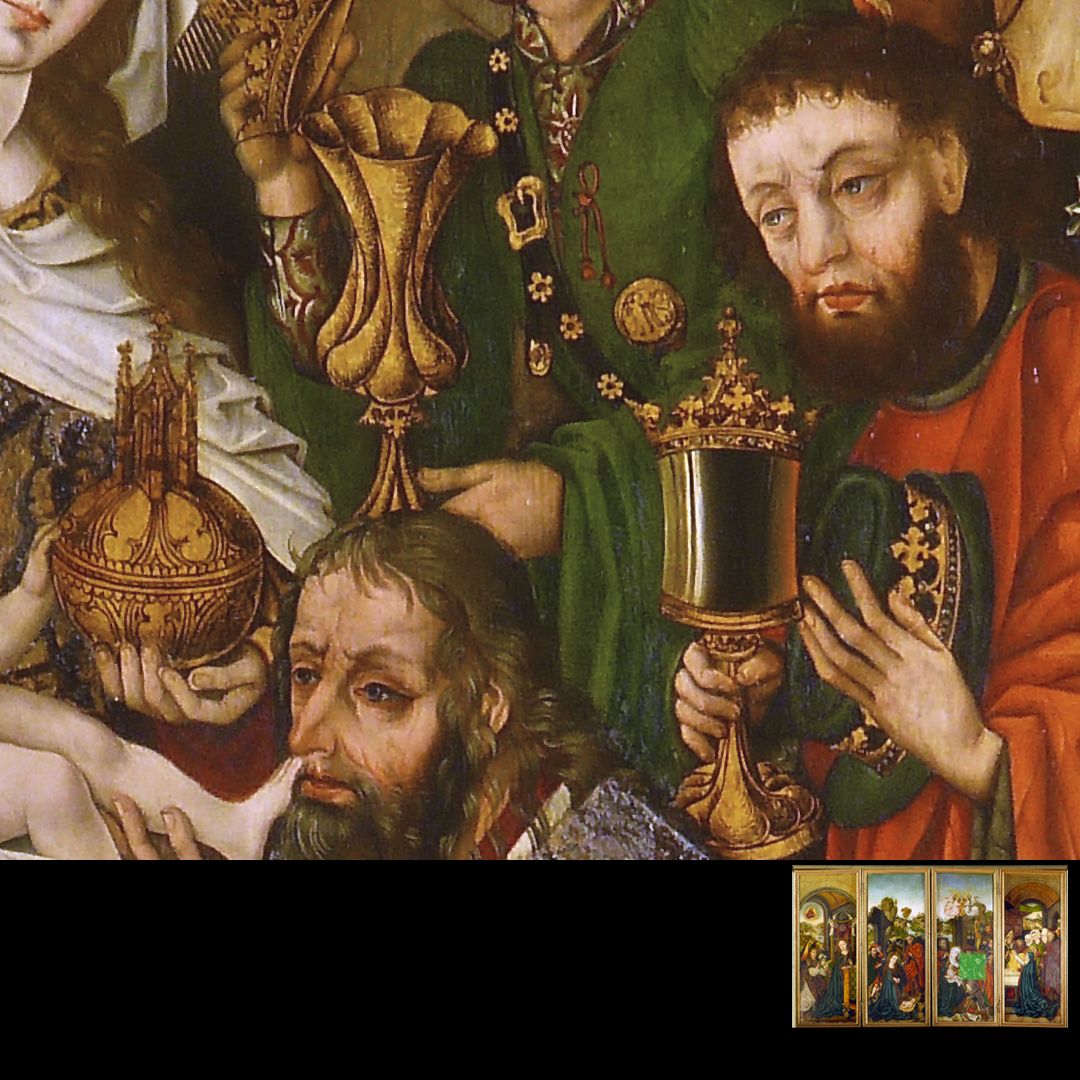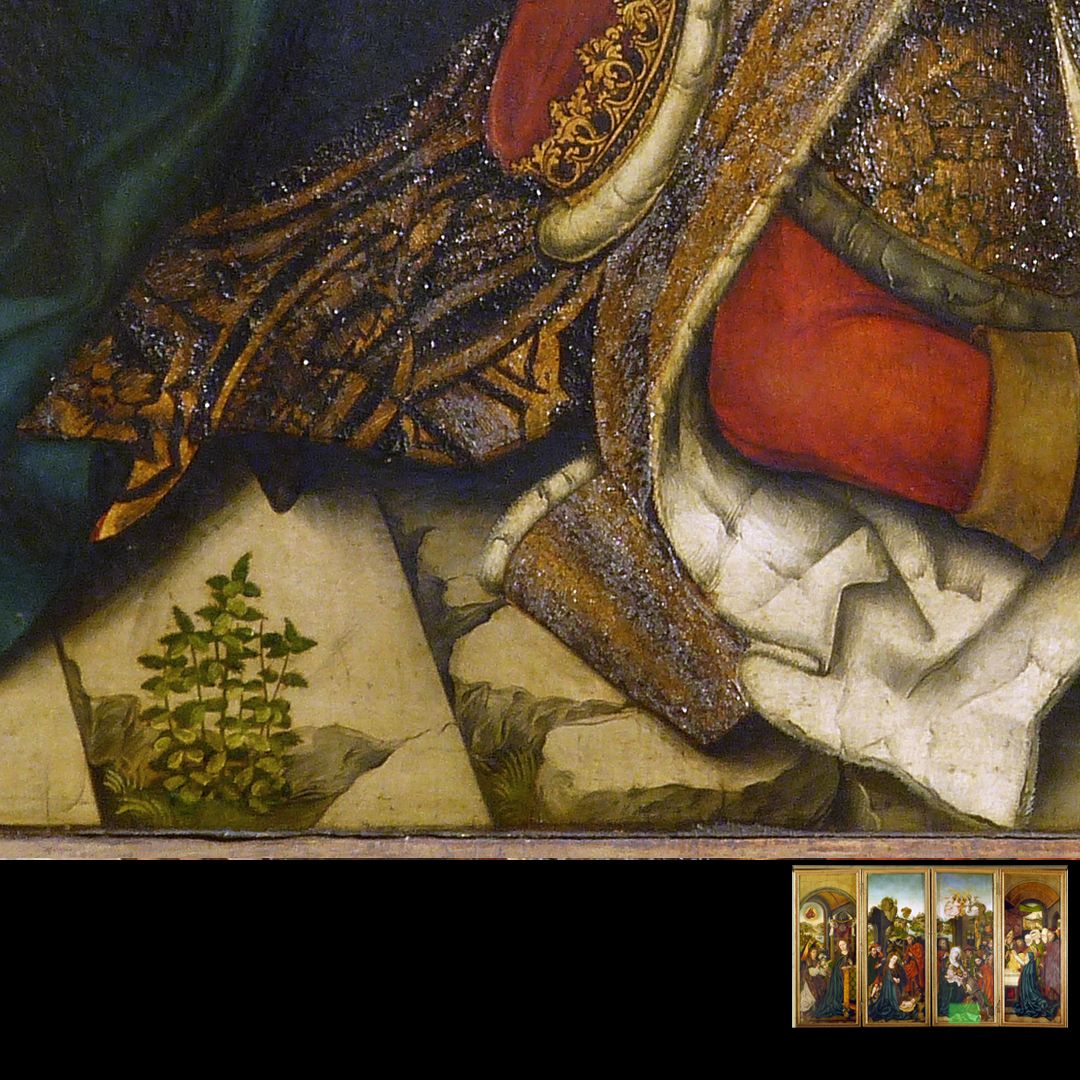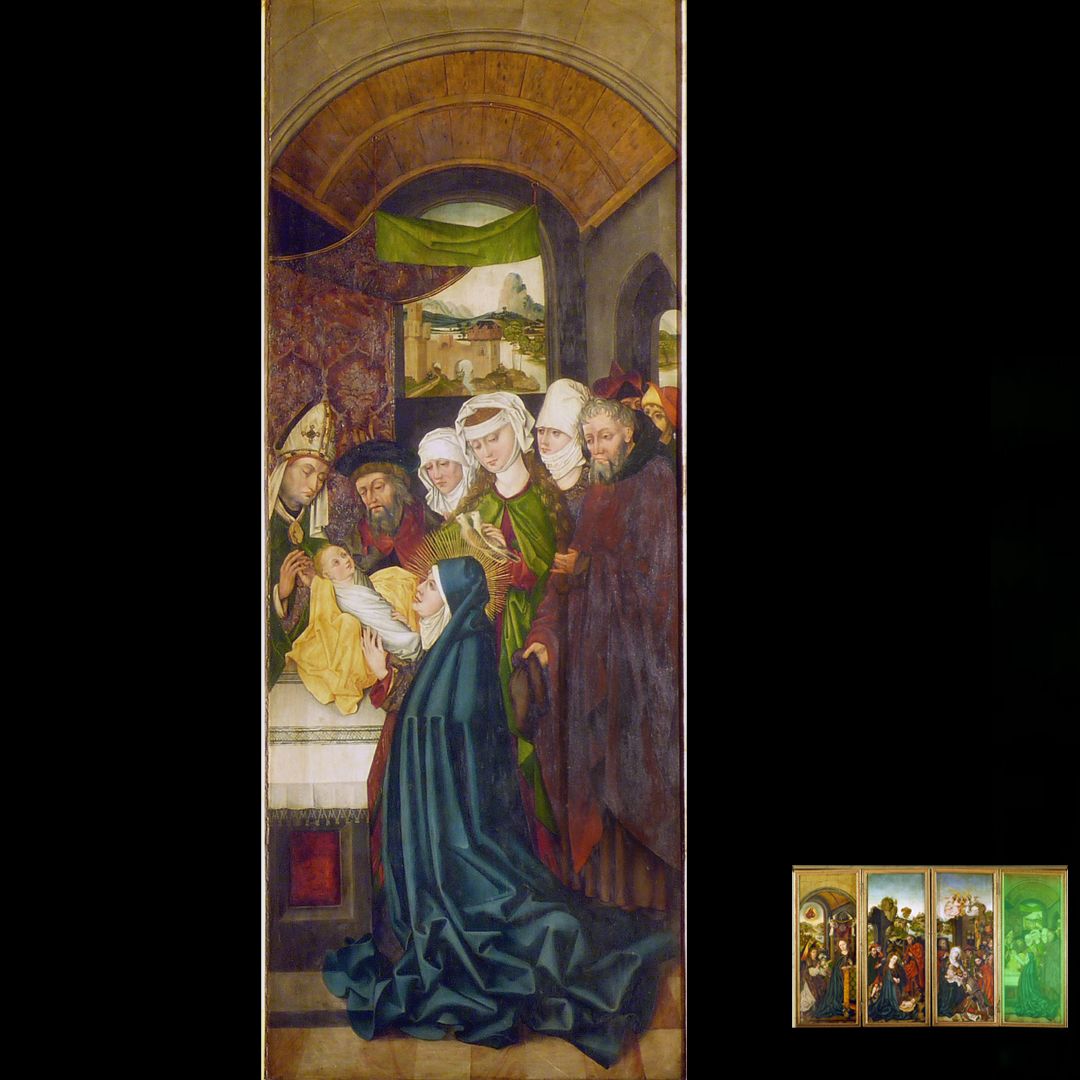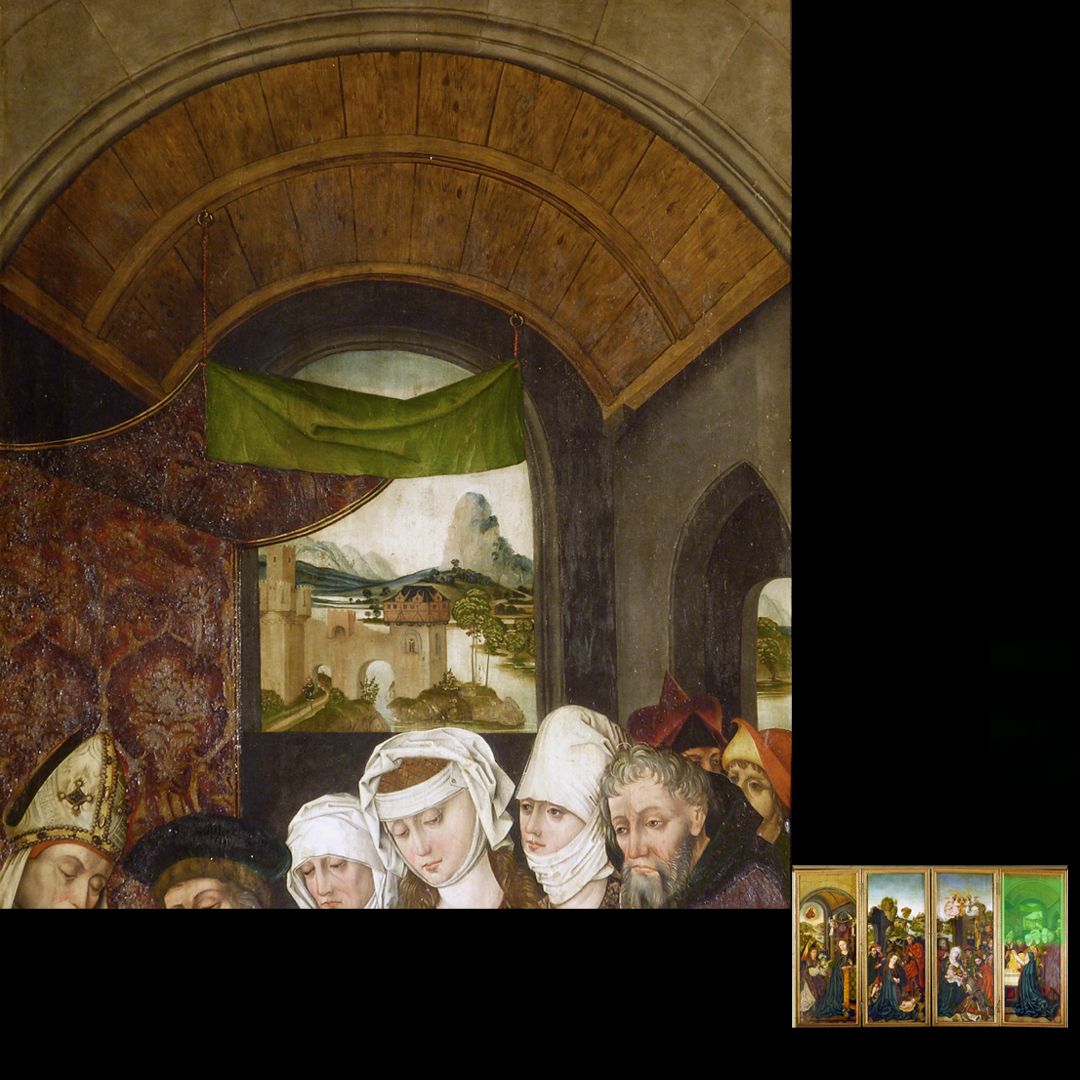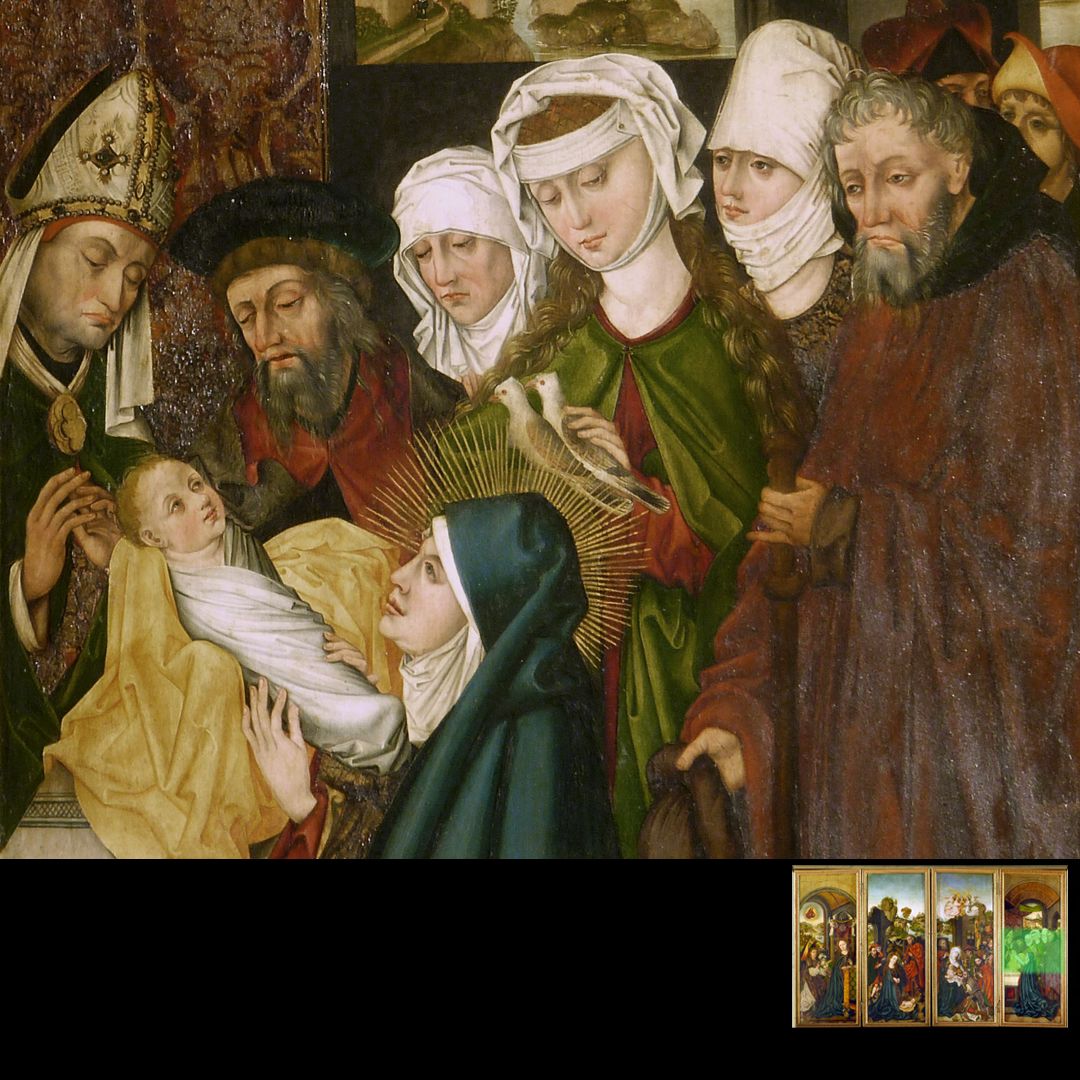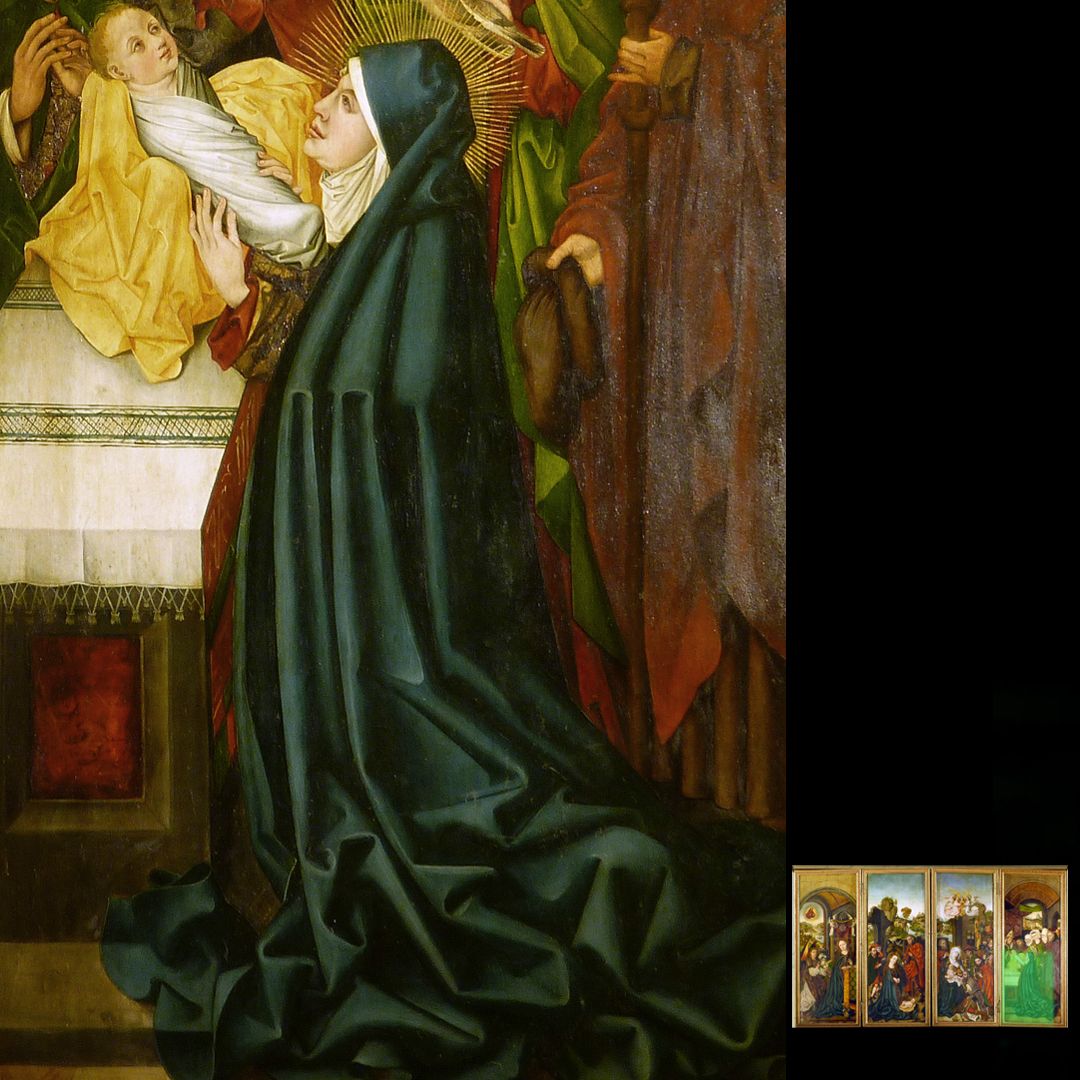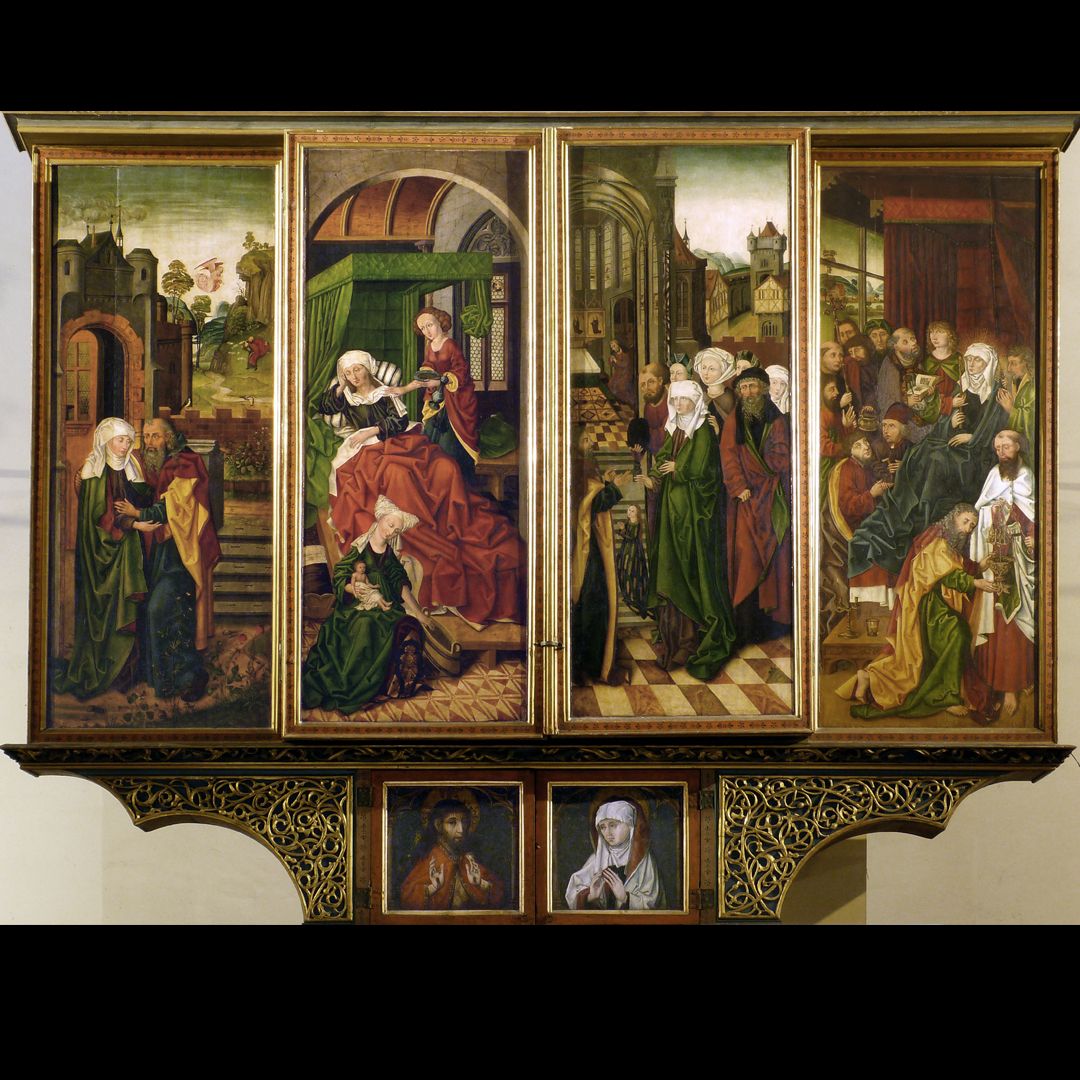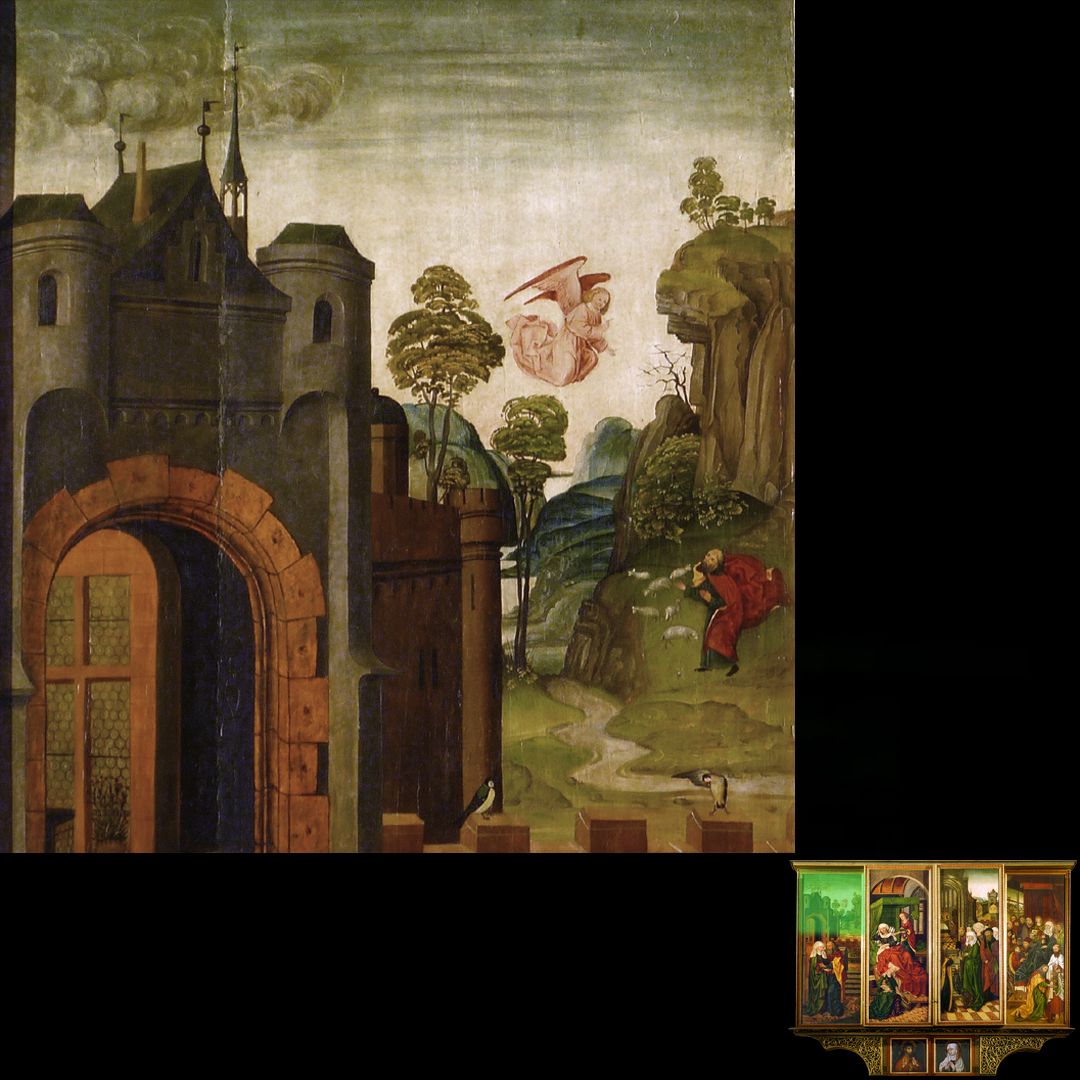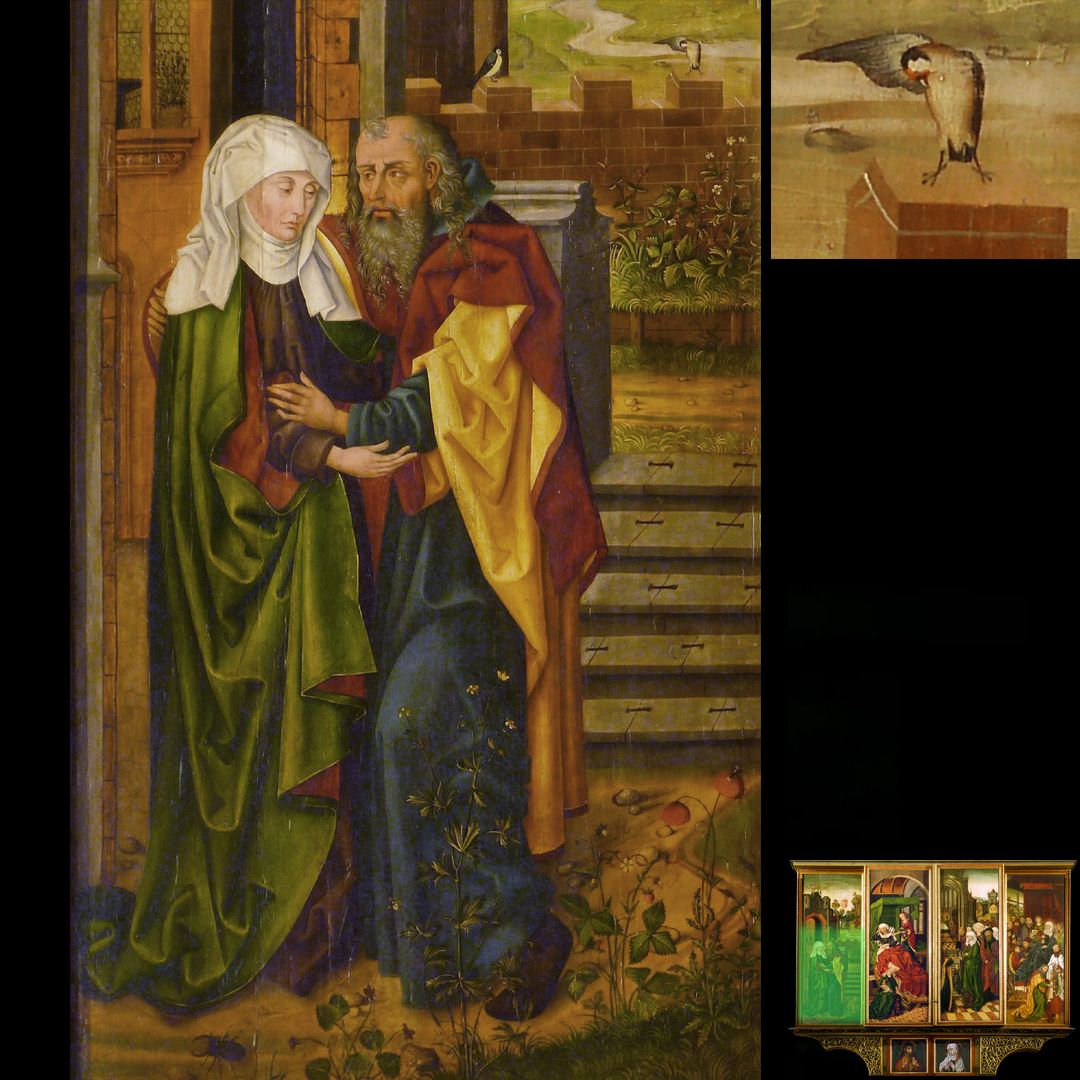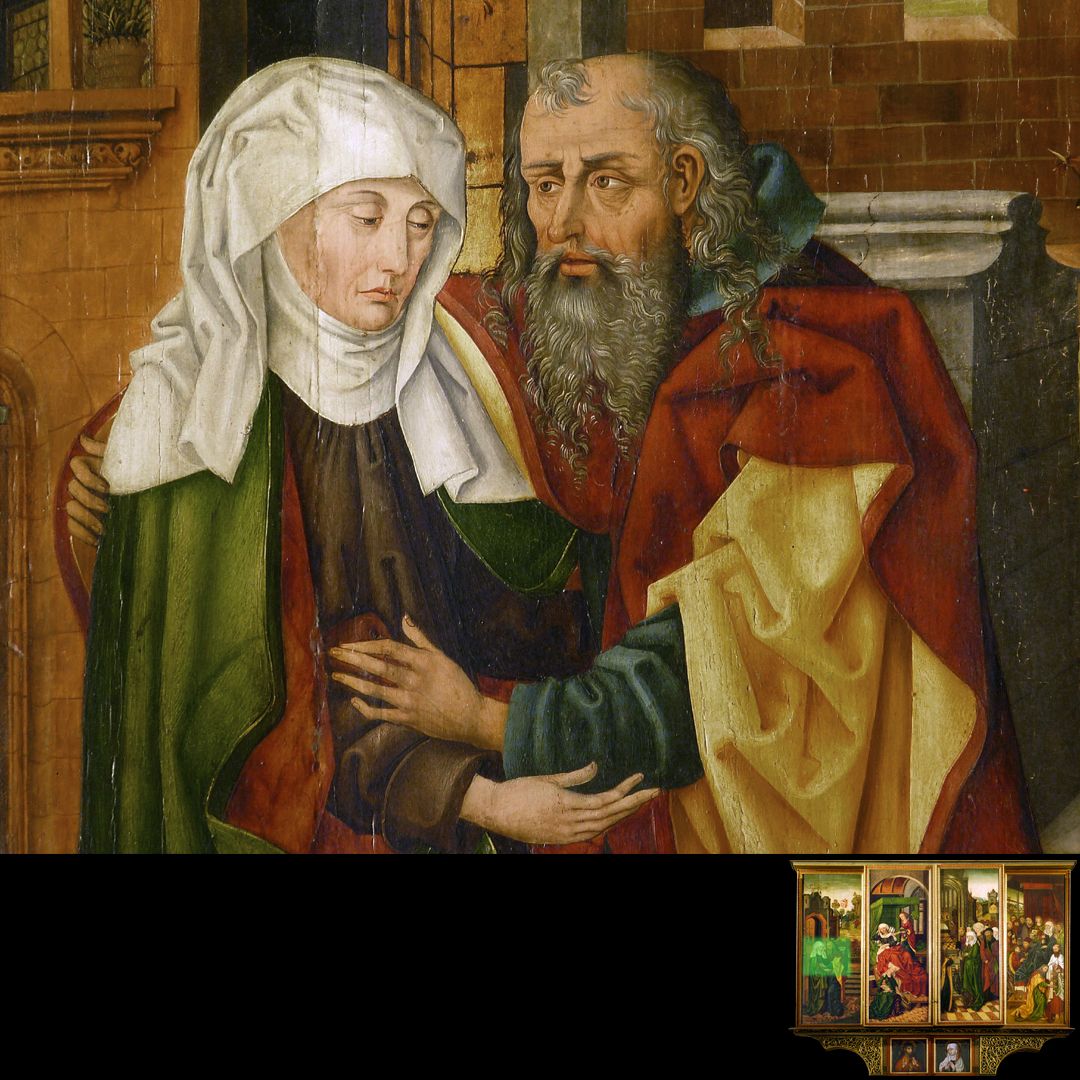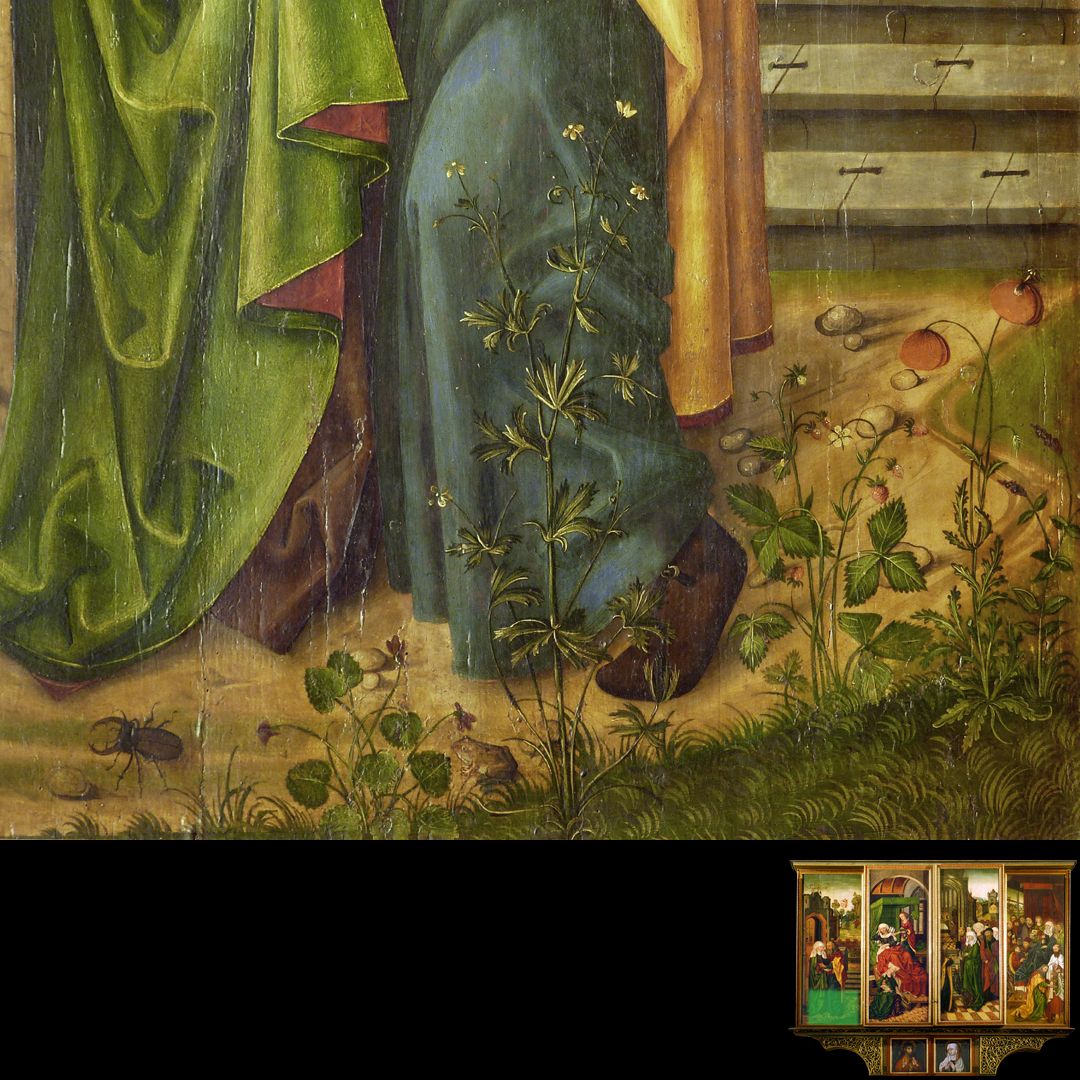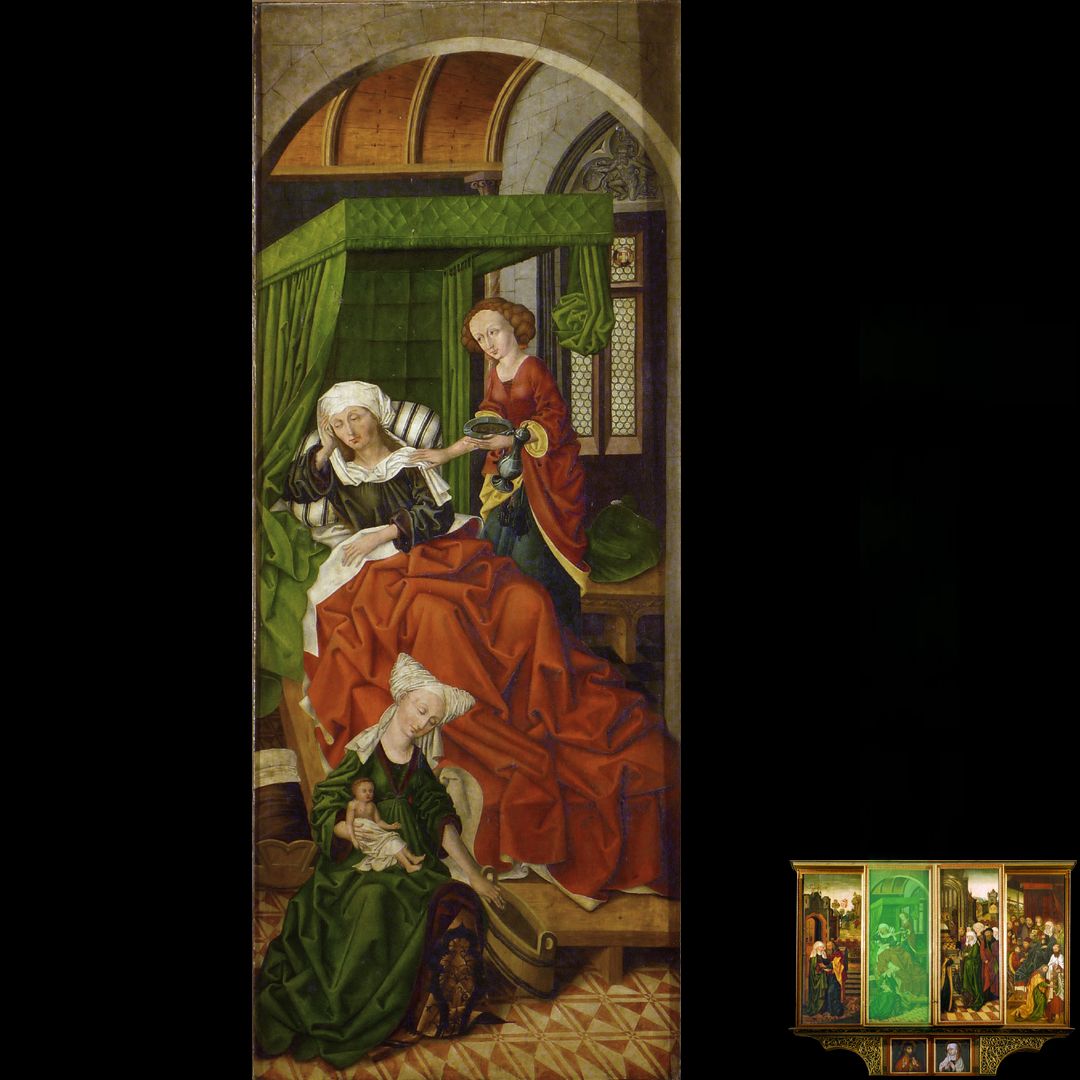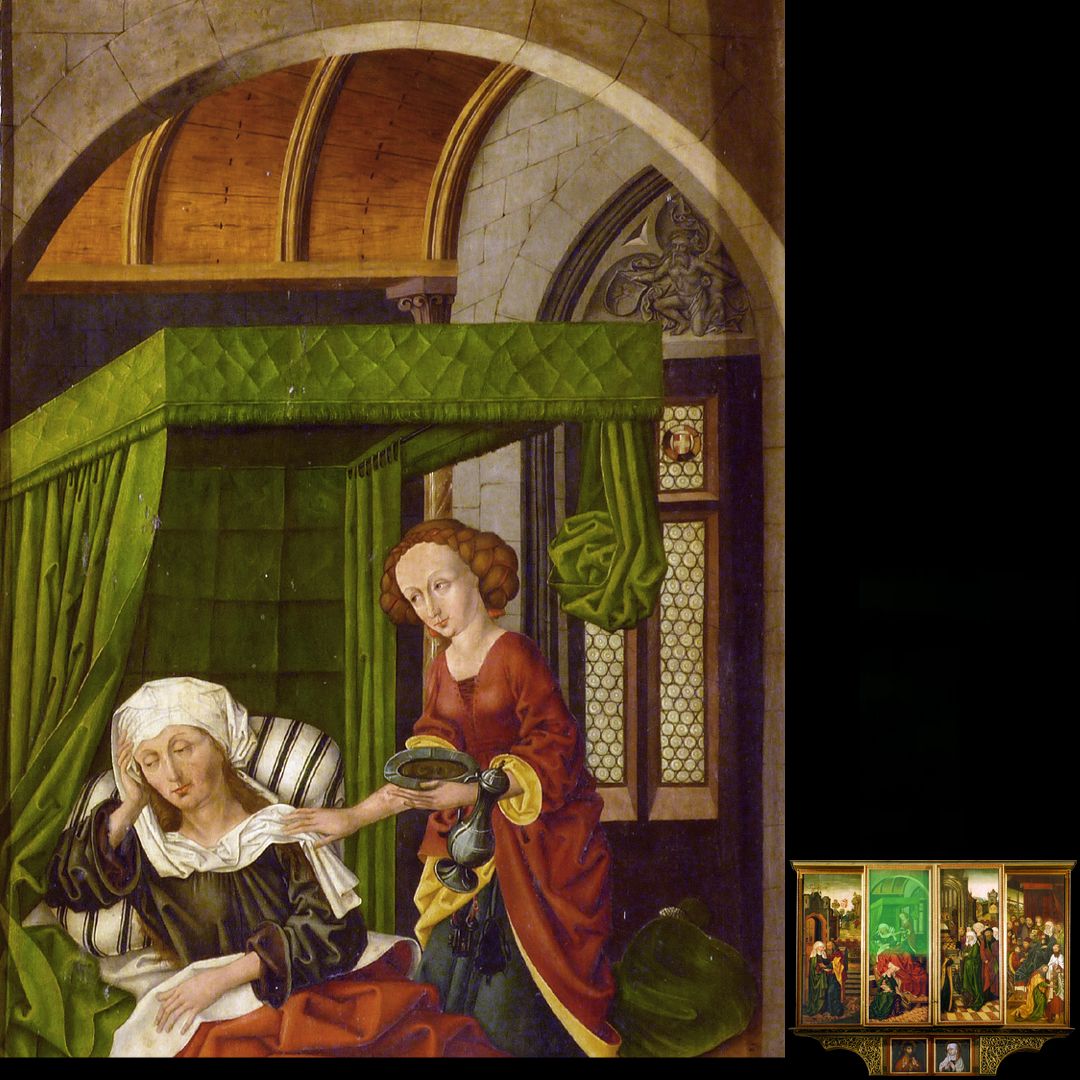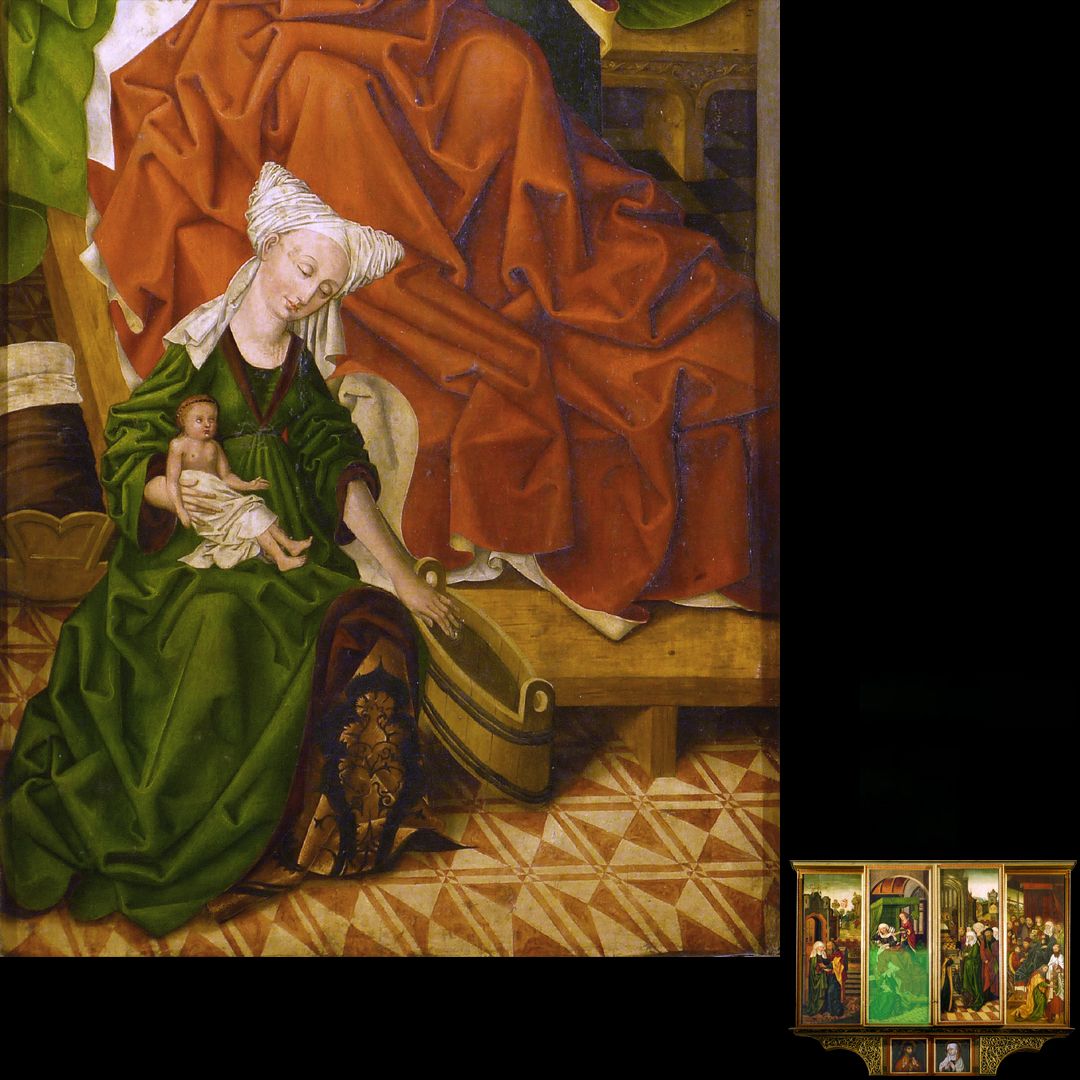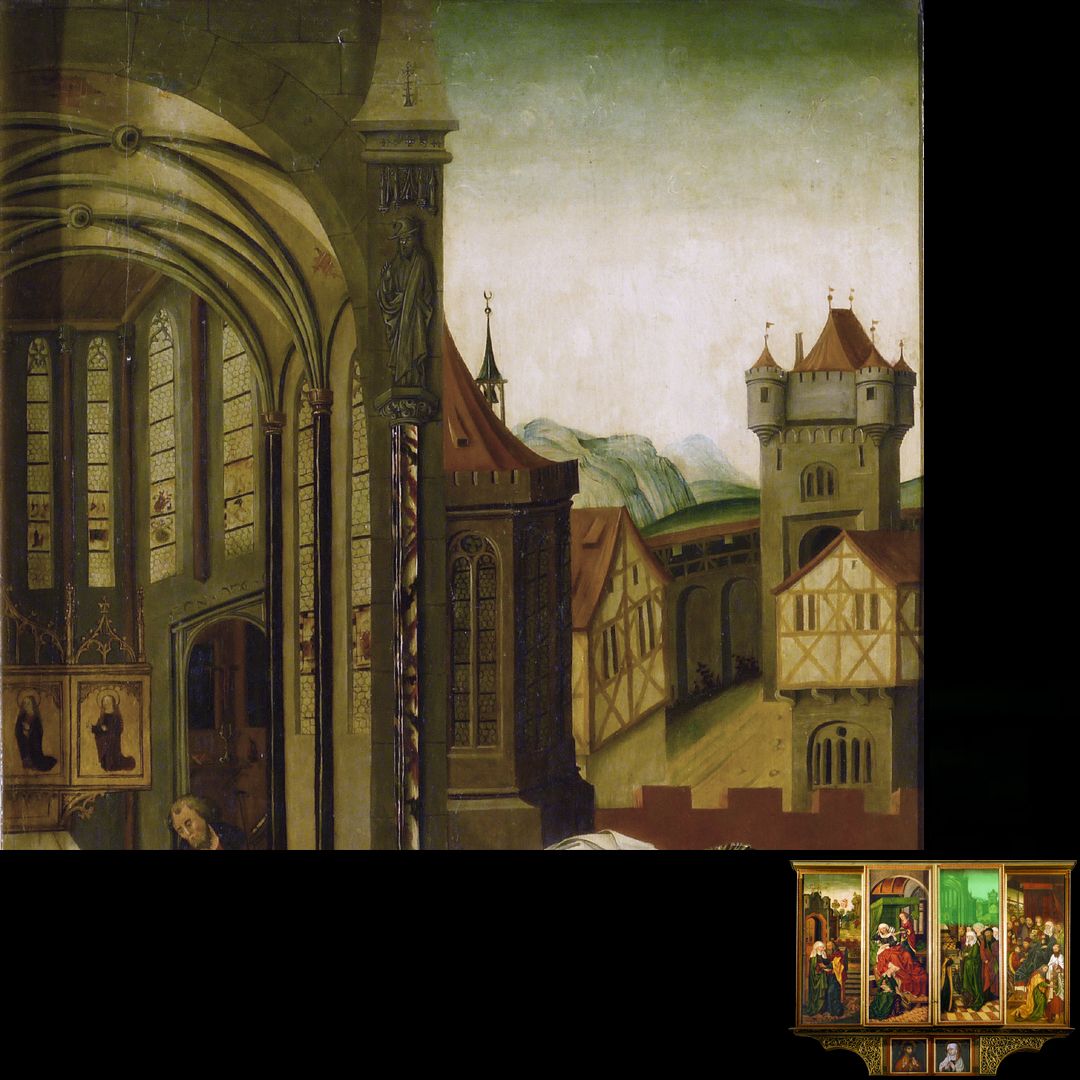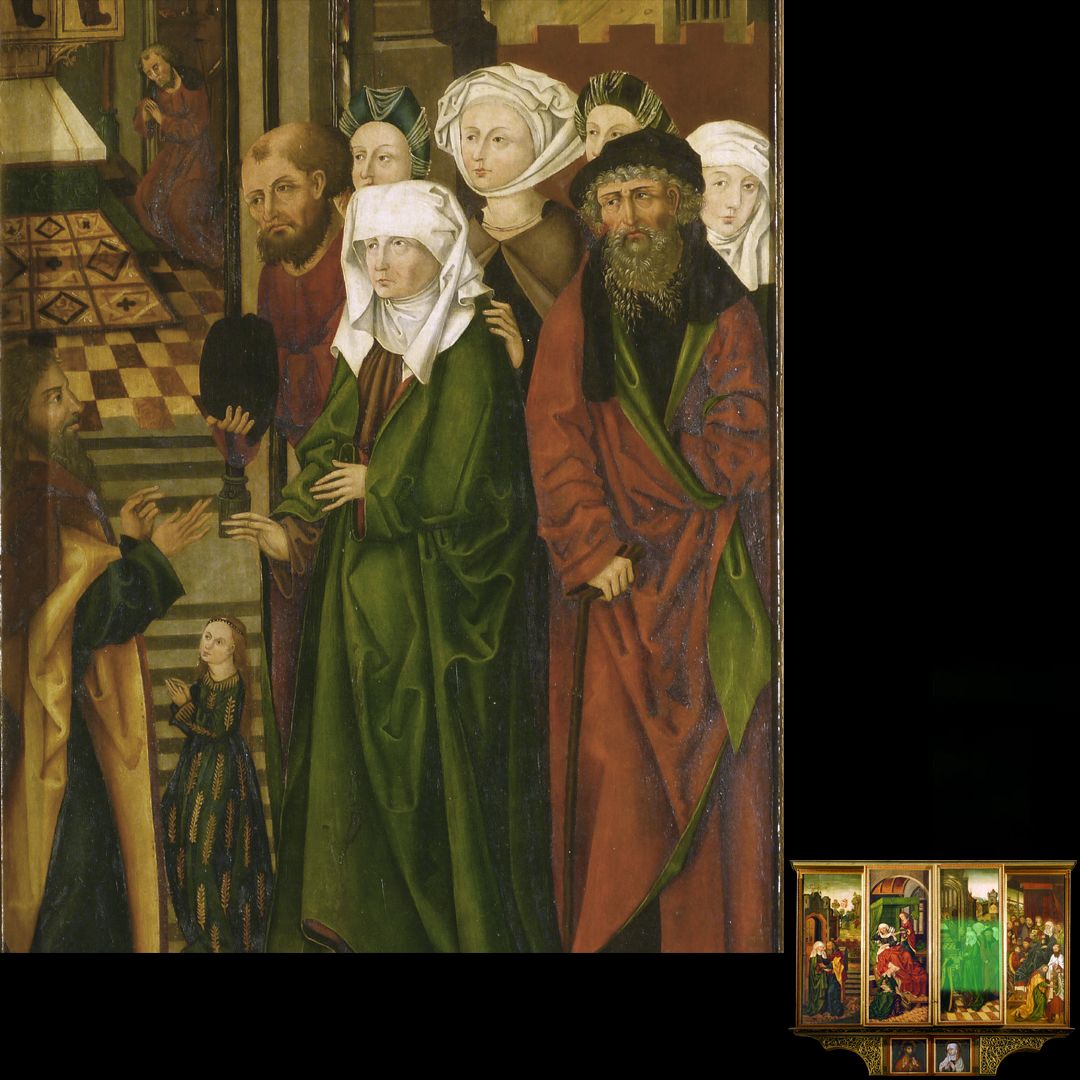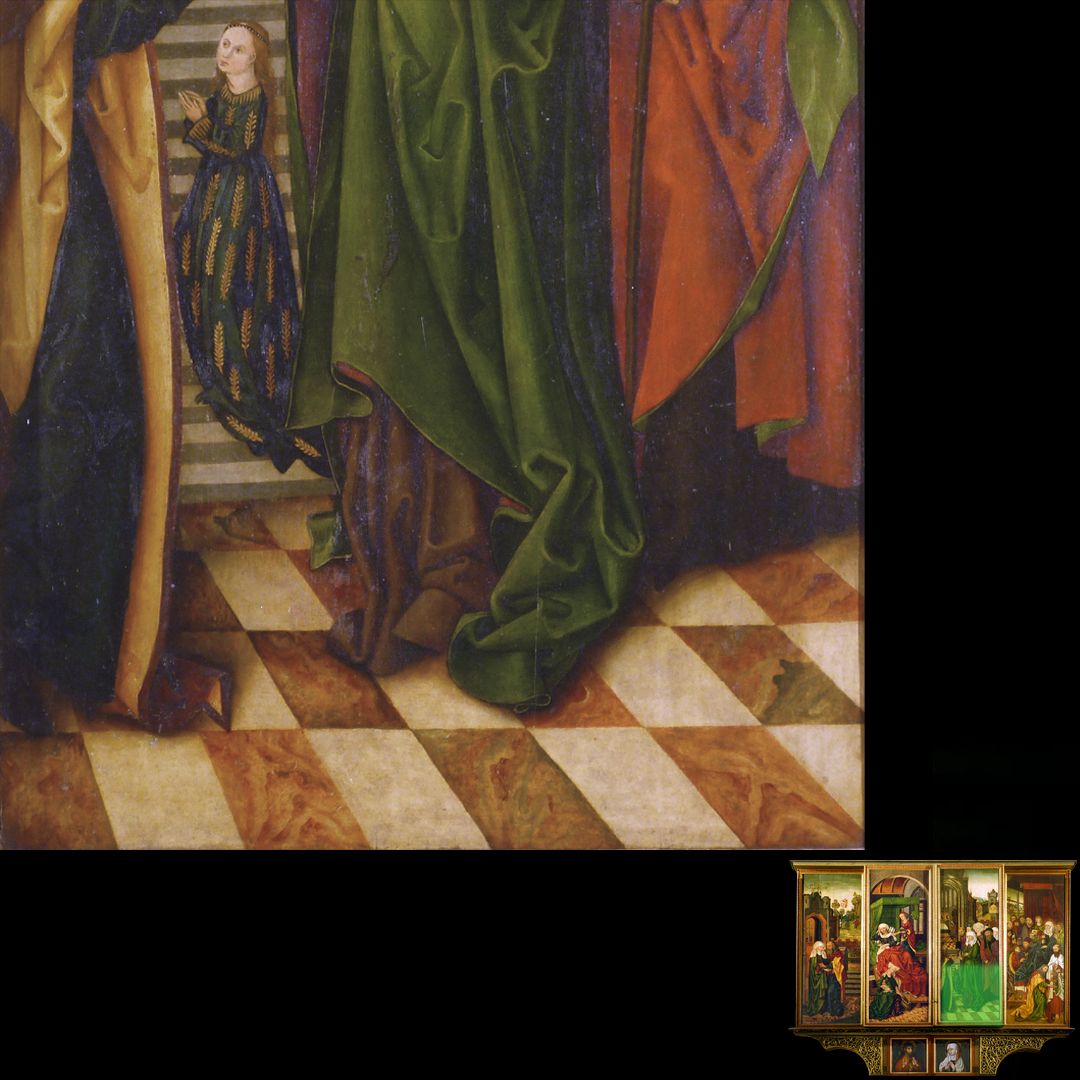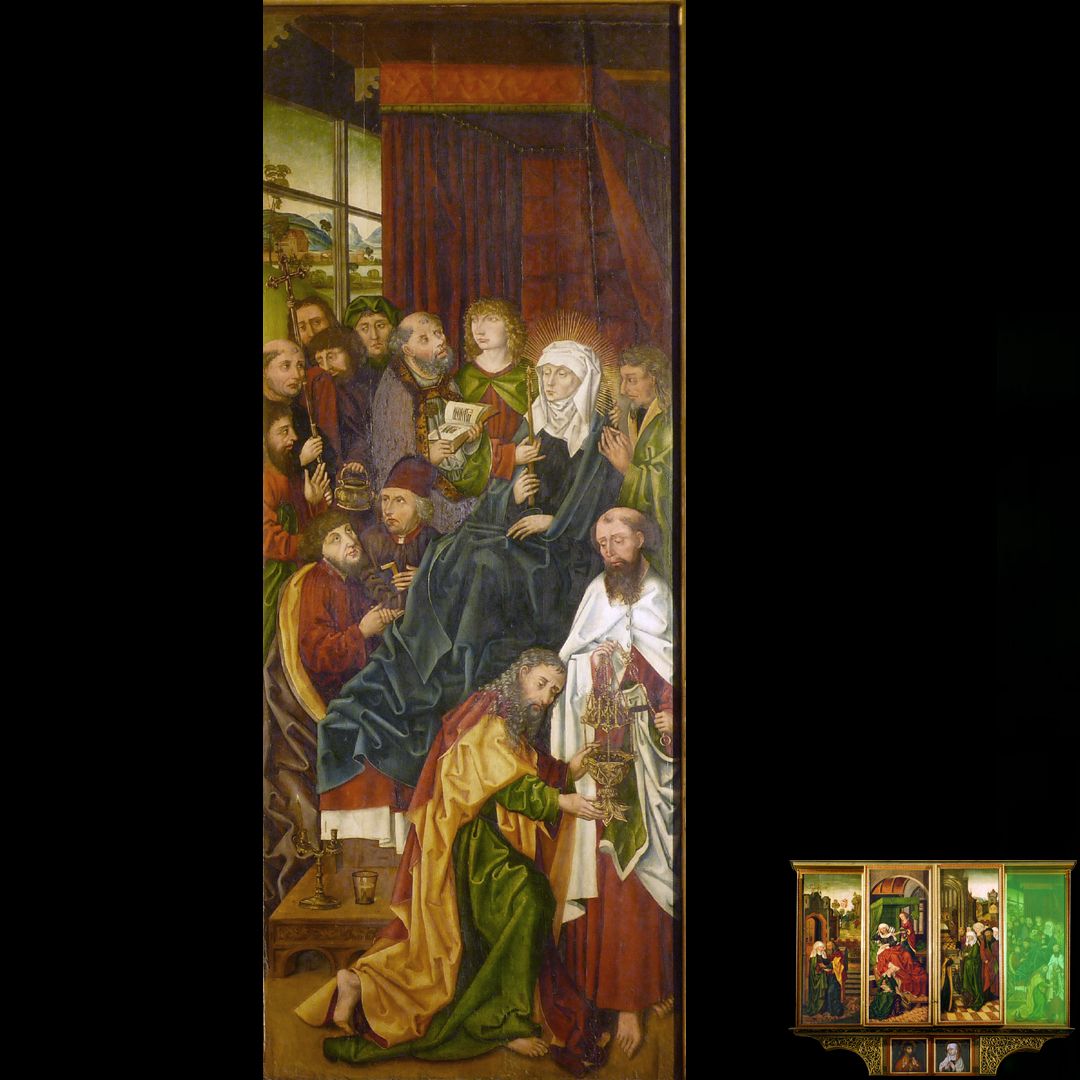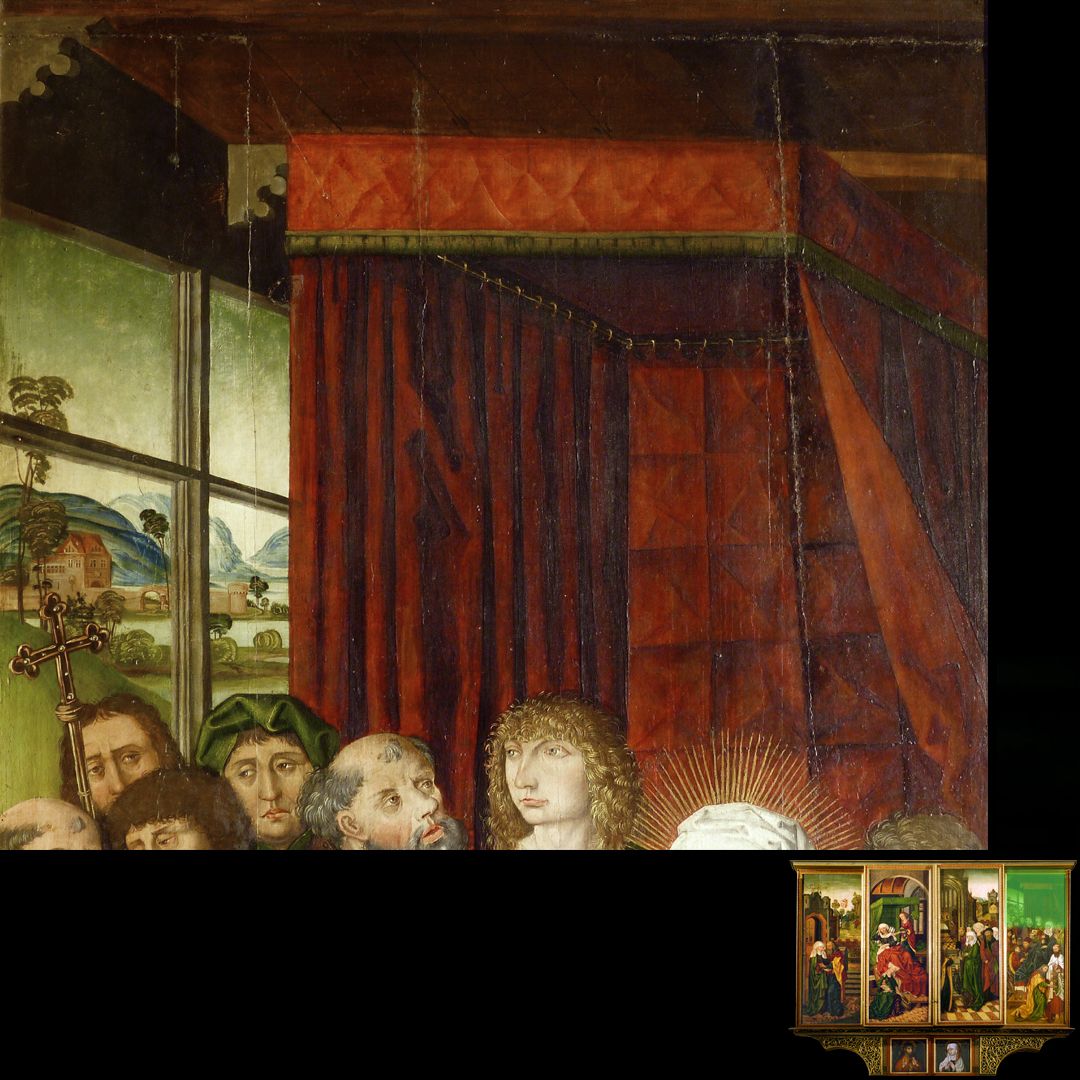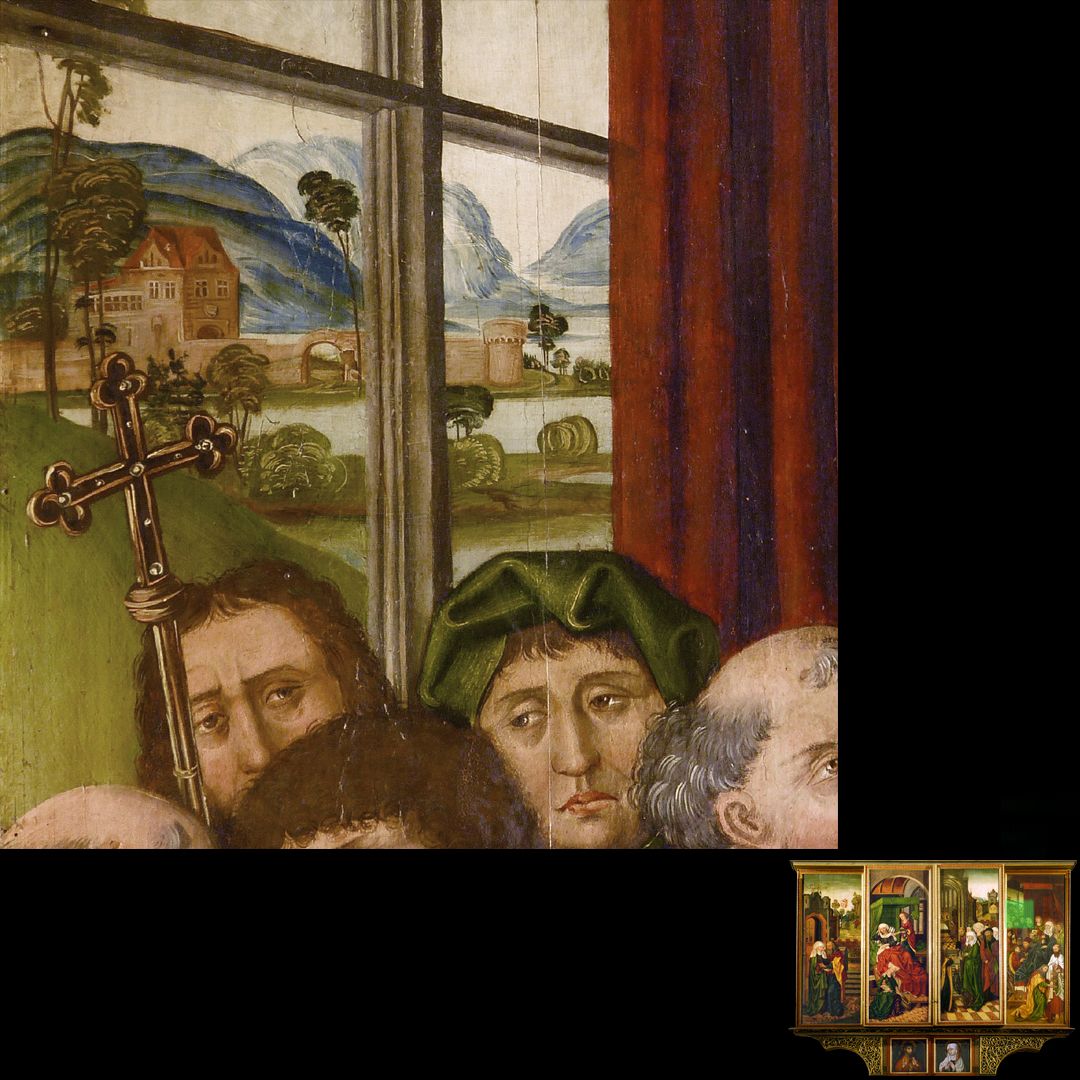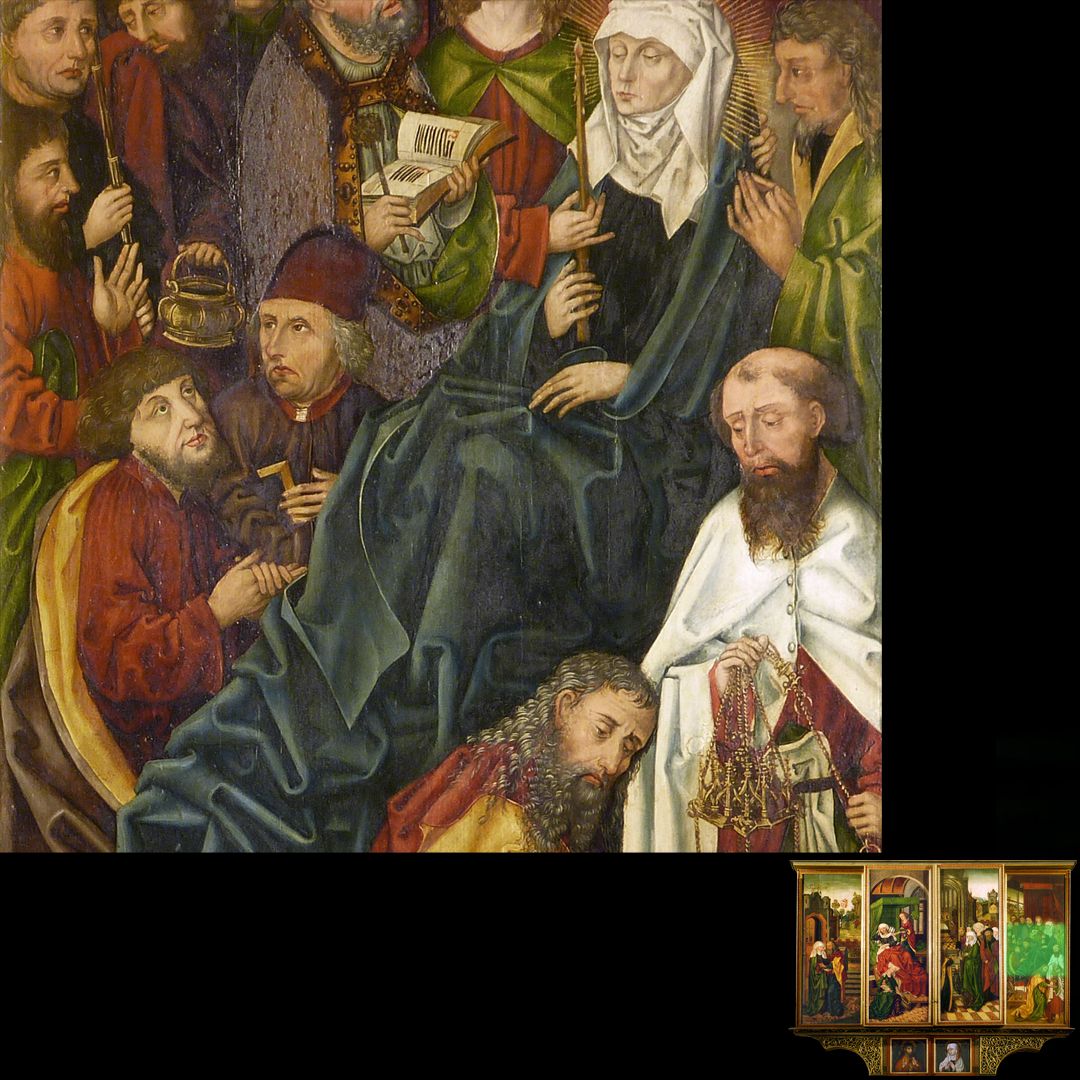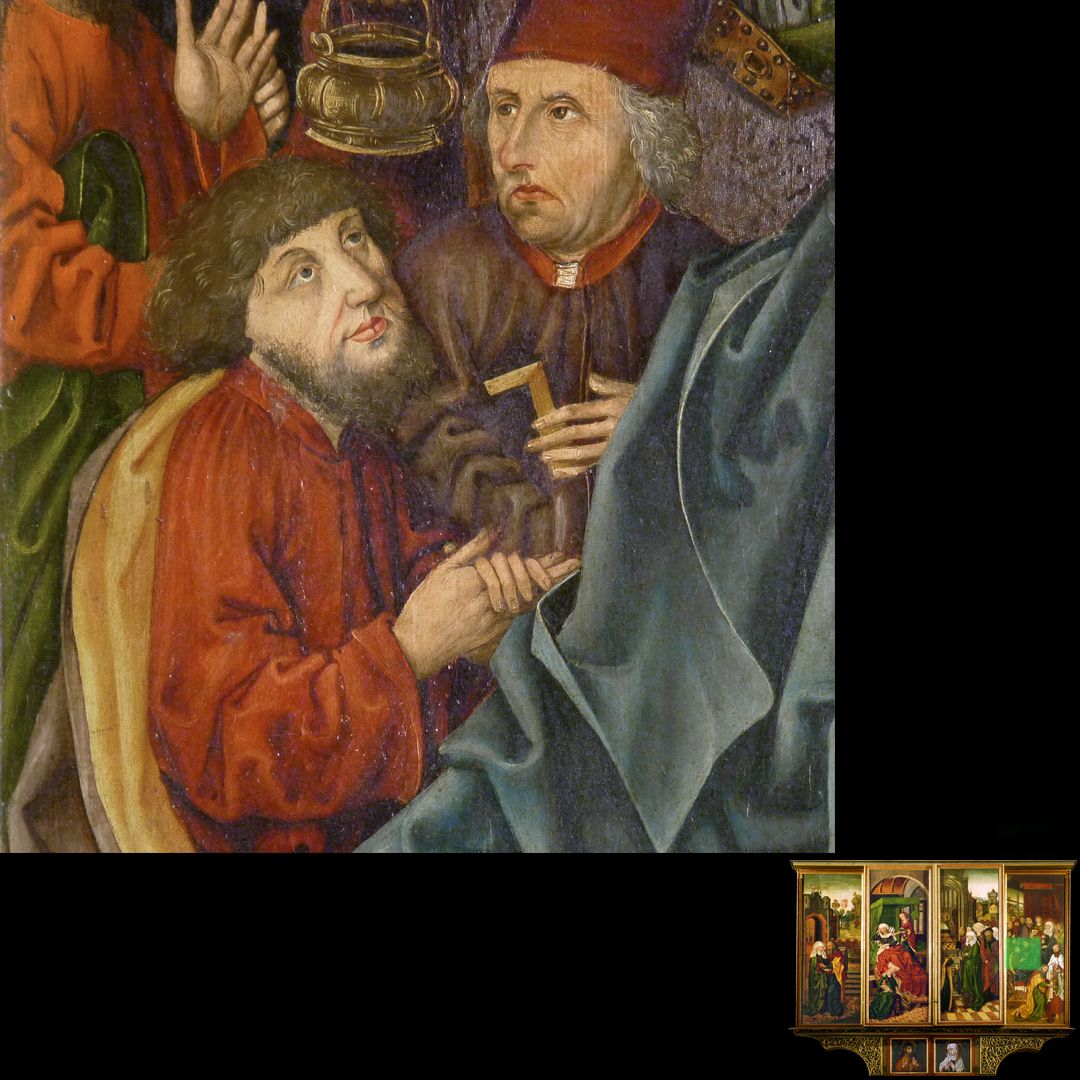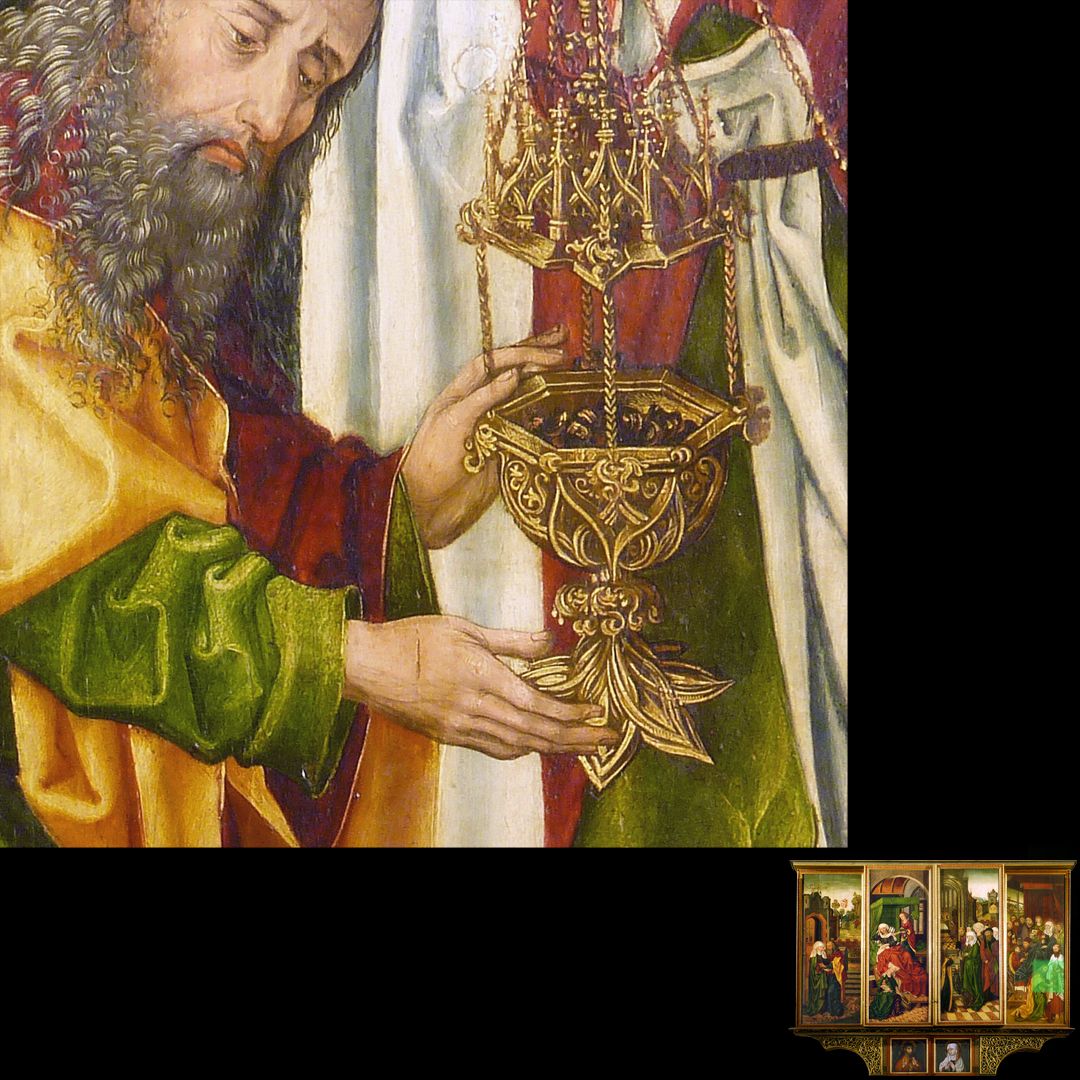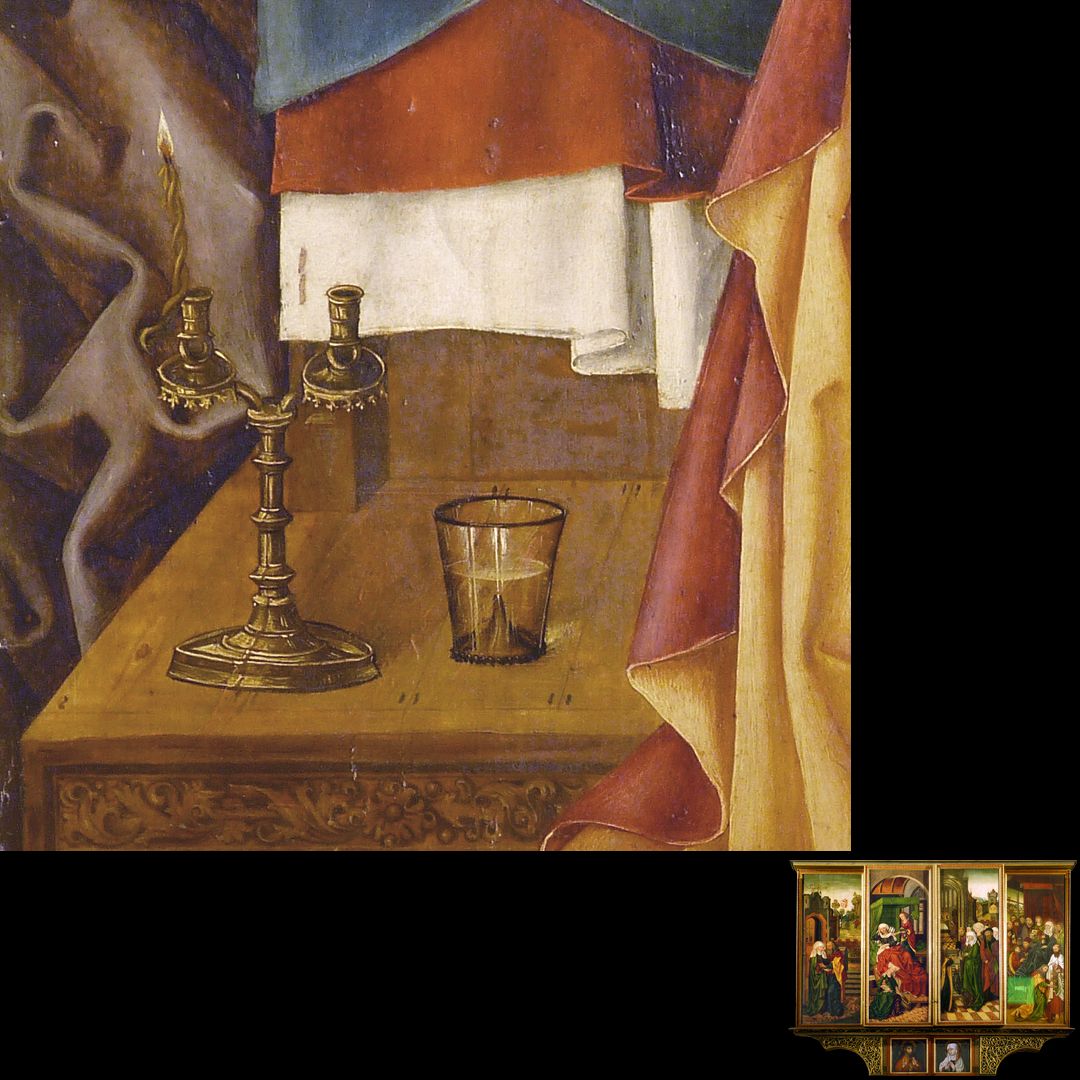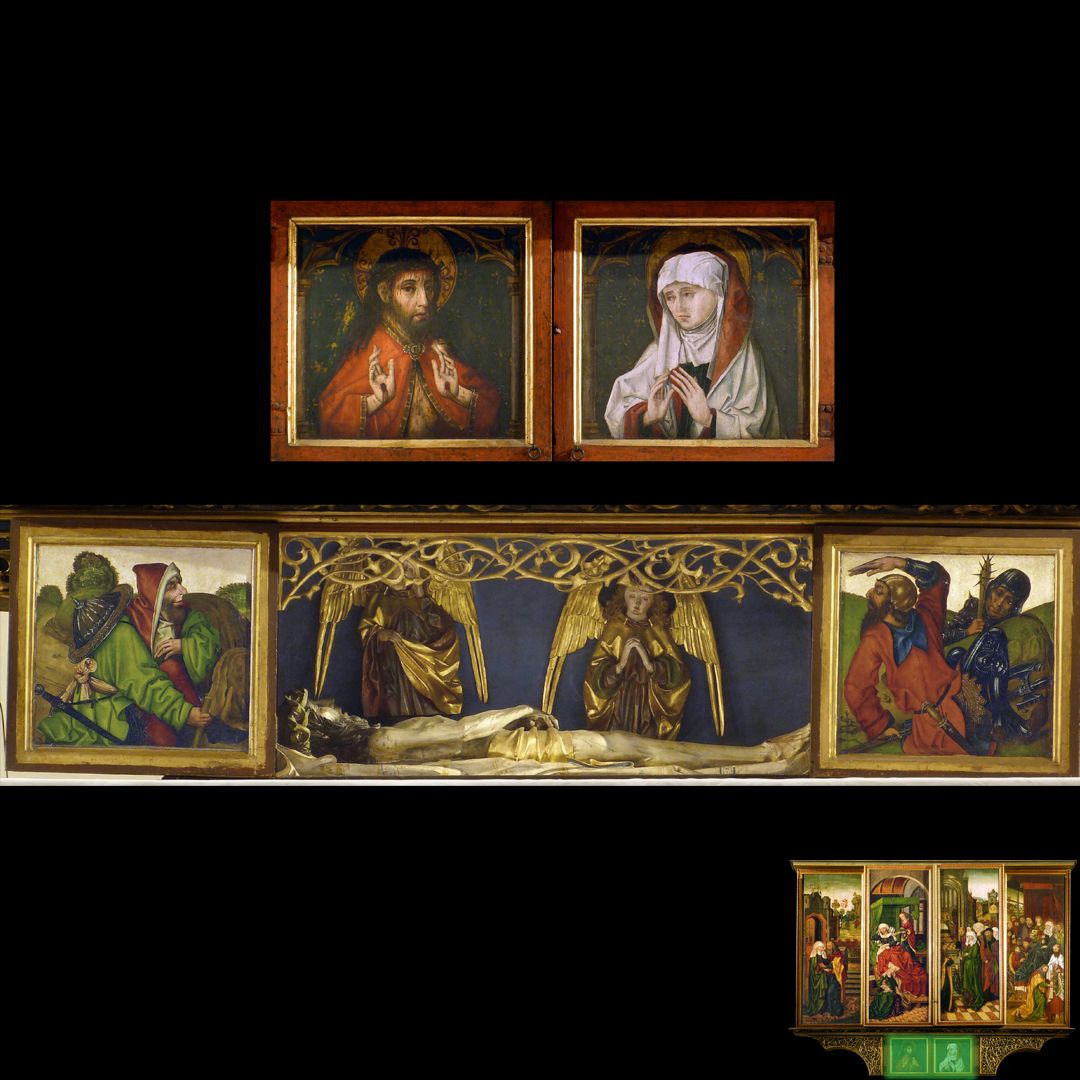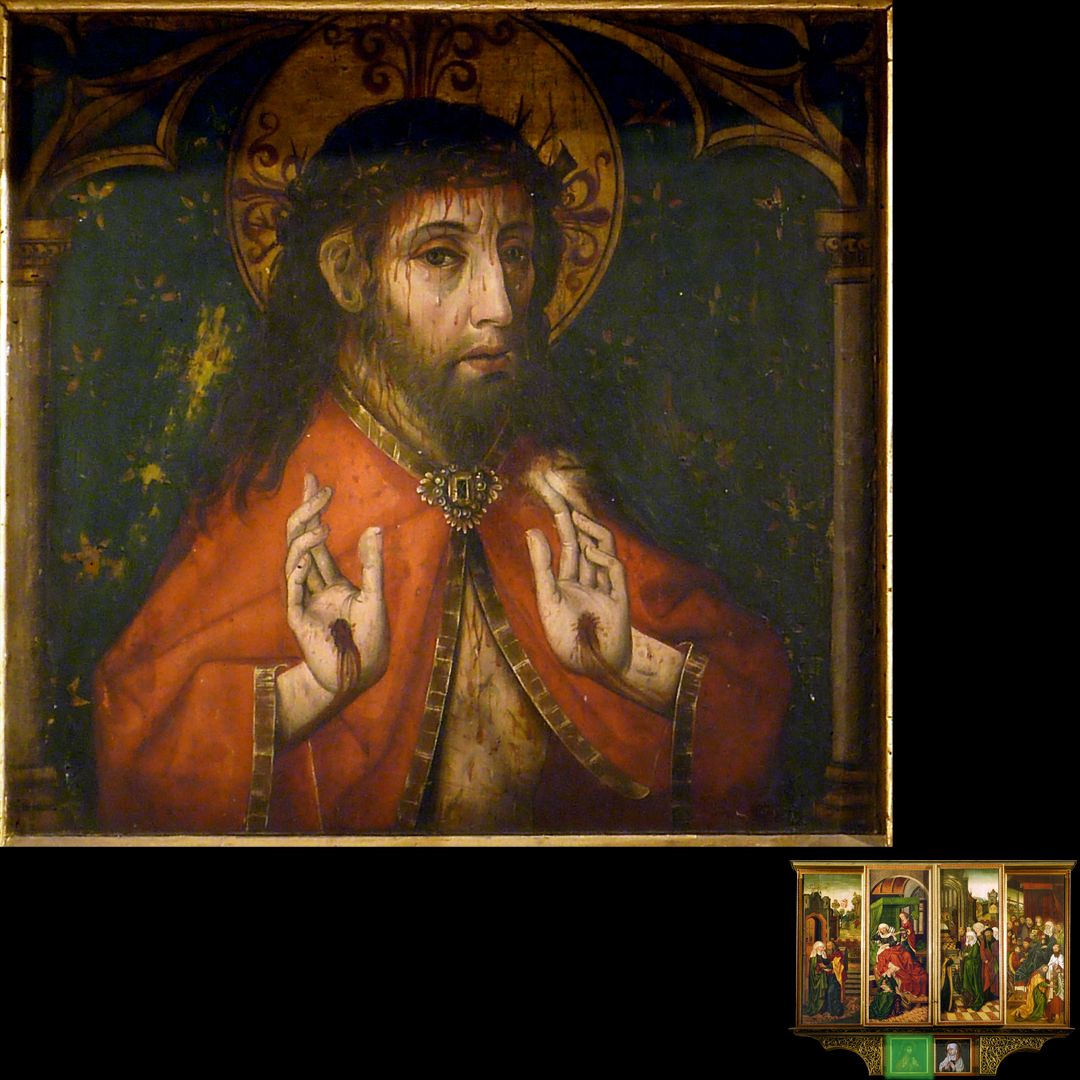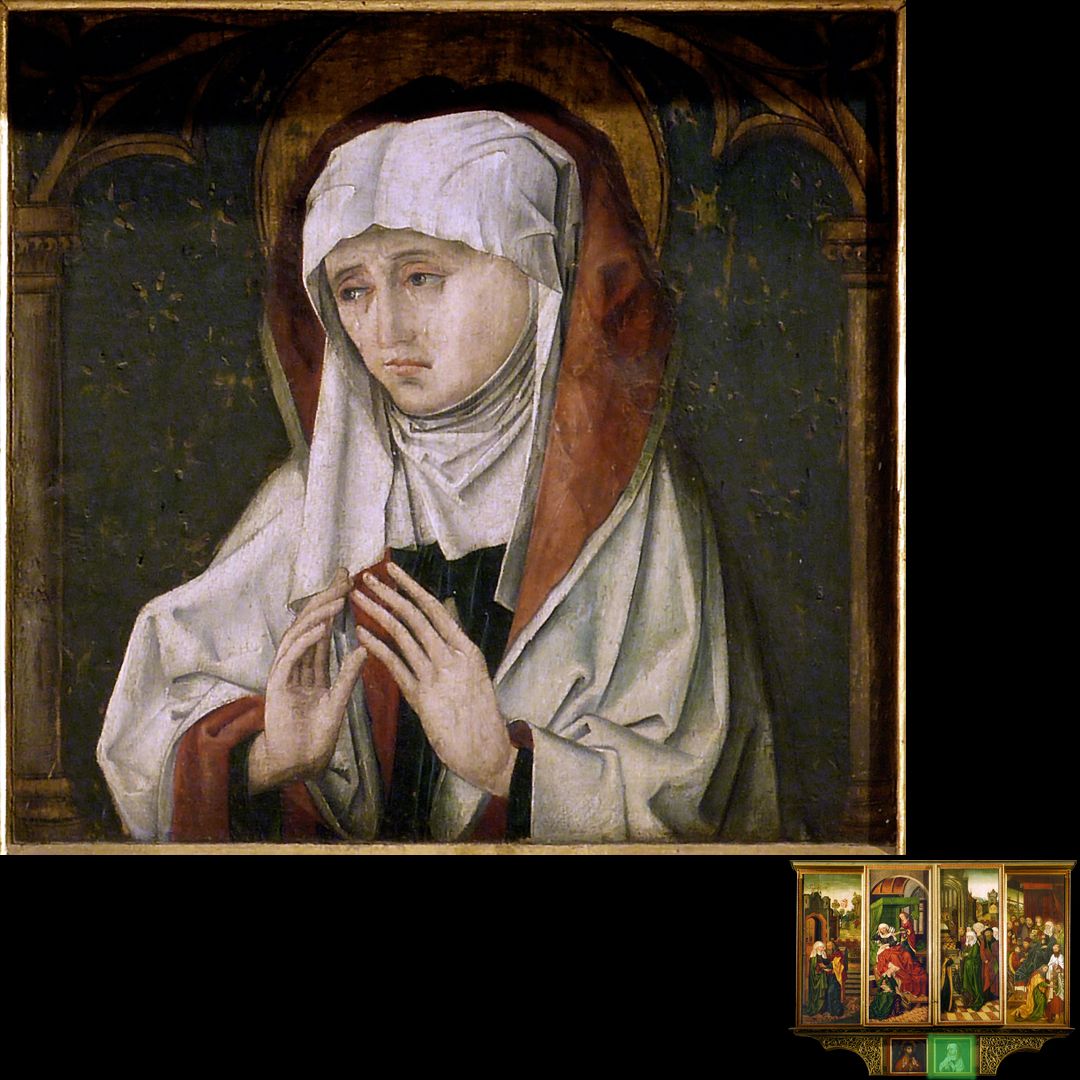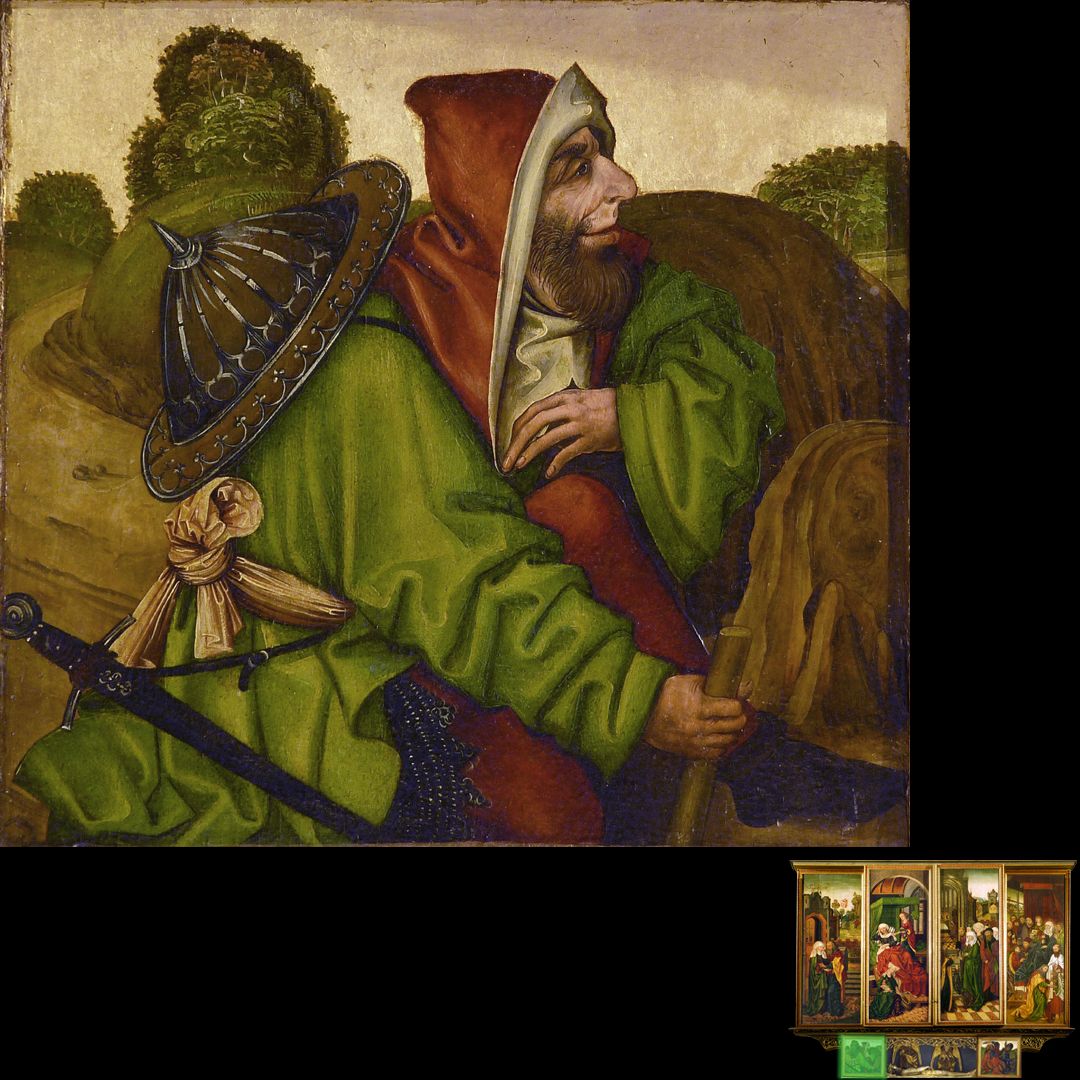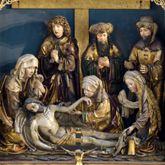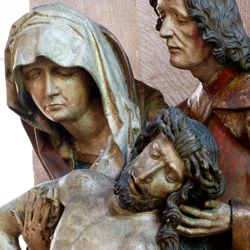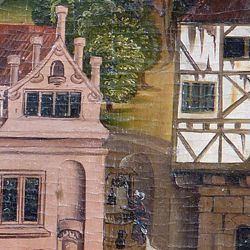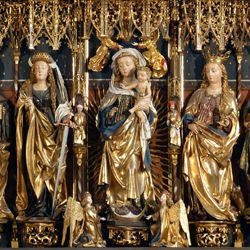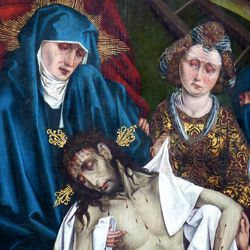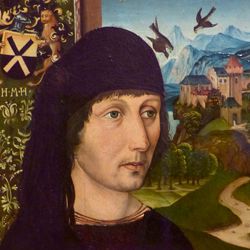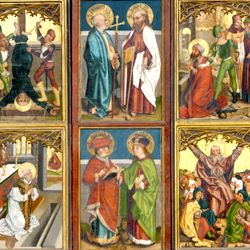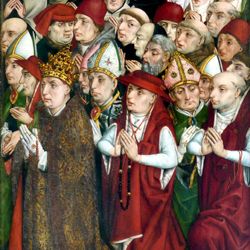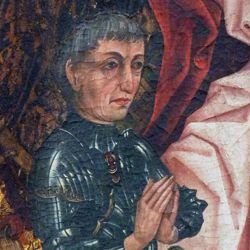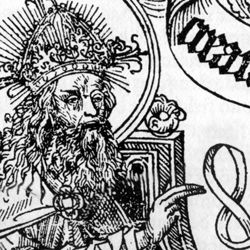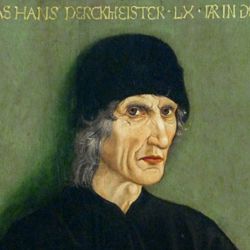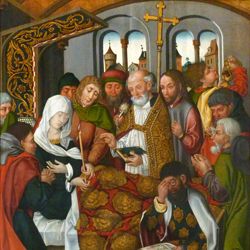Peringsdörffer Retable
Peringsdörffer Retable
around 1486
Retable in the church choir
The altarpiece was originally donated by Sebald Peringsdörffer and his wife Katharina, née Harsdörffer, for the Salvator Chapel, which was newly consecrated in 1486 and was located on the north side of the nave of the Augustinian Church. It was moved to the Heiligkreuzkirche in 1564 and, after the destruction of this church, has stood in the choir of the Friedenskirche in Nuremberg St. Johannis since 1952.
_______________
The retable, which can be transformed twice, houses the group of figures of the Lamentation under the Cross in the shrine, which is flanked by the panels of the Carrying of the Cross (with the coat of arms of the Peringsdörffer family) and the Resurrection (with the coat of arms of the Harsdörffer family). The first wall shows stations of the story of Christ's childhood (Annunciation, Nativity, Adoration and Presentation). When closed, scenes from the life of Mary can be seen (Anna and Joachim at the Golden Gate, Nativity with alliance coat of arms of the founding couple, Temple Walk and Death of Mary). The Man of Sorrows and the Mother of Sorrows are depicted on the outer sides of the predella wings, the guards at the tomb on the inner sides of the wings. The carved figure of Christ's body in the tomb lies in the case, accompanied by two angels. The altar structure is completed by a sprinkling with a crucifixion group and the Virgin of the Protective Mantle.(...)
Sarah Fetzer
_________________
So far, no name has been found in the local tradition that could be linked to this outstanding group of works. Only when we look beyond a national perspective do we find what we are looking for. For a long time we have known of a carver from the imperial city who carried out several prominent commissions in Northern Italy that have survived to the present day. We are talking about Sisto (Sixtus) Frei, who in 1499/1500 was entrusted with the equestrian statue for the burial chapel of the condottiere Bartolomeo Colleoni in Bergamo, before he is attested in Trento in 1508-15, where he is credited with the crucifixion group of the Cappella del Crocifisso in the cathedral, which can be traced back to 1519 on the Peter and Paul altar (...).
Frei had already become a citizen of Nuremberg in 1472. If we assume that he must have left behind an oeuvre in his home town, parts of which may still be preserved, then the group of works around the Peringsdörffer retable comes into focus, in which, as Manuel Teget-Welz was the first to note, close stylistic references can be established.
Dr Benno Baumbauer
Location: Nuremberg, St. Johannis, Peace Church
Design: Wolgemut, Michael
Realization: Wolgemut, Werkstatt, Frei (Frey), Sixtus
photo 2014, Pablo de la Riestra
Peringsdörffer Retable
around 1486
Superstructure of the altarpiece: Crucified between Mary and John
photo 2014, Pablo de la Riestra
The altarpiece was originally donated by Sebald Peringsdörffer and his wife Katharina, née Harsdörffer, for the Salvator Chapel, which was newly consecrated in 1486 and was located on the north side of the nave of the Augustinian Church. It was moved to the Heiligkreuzkirche in 1564 and, after the destruction of this church, has stood in the choir of the Friedenskirche in Nuremberg St. Johannis since 1952.
_______________
The retable, which can be transformed twice, houses the group of figures of the Lamentation under the Cross in the shrine, which is flanked by the panels of the Carrying of the Cross (with the coat of arms of the Peringsdörffer family) and the Resurrection (with the coat of arms of the Harsdörffer family). The first wall shows stations of the story of Christ's childhood (Annunciation, Nativity, Adoration and Presentation). When closed, scenes from the life of Mary can be seen (Anna and Joachim at the Golden Gate, Nativity with alliance coat of arms of the founding couple, Temple Walk and Death of Mary). The Man of Sorrows and the Mother of Sorrows are depicted on the outer sides of the predella wings, the guards at the tomb on the inner sides of the wings. The carved figure of Christ's body in the tomb lies in the case, accompanied by two angels. The altar structure is completed by a sprinkling with a crucifixion group and the Virgin of the Protective Mantle.(...)
Sarah Fetzer
_________________
So far, no name has been found in the local tradition that could be linked to this outstanding group of works. Only when we look beyond a national perspective do we find what we are looking for. For a long time we have known of a carver from the imperial city who carried out several prominent commissions in Northern Italy that have survived to the present day. We are talking about Sisto (Sixtus) Frei, who in 1499/1500 was entrusted with the equestrian statue for the burial chapel of the condottiere Bartolomeo Colleoni in Bergamo, before he is attested in Trento in 1508-15, where he is credited with the crucifixion group of the Cappella del Crocifisso in the cathedral, which can be traced back to 1519 on the Peter and Paul altar (...).
Frei had already become a citizen of Nuremberg in 1472. If we assume that he must have left behind an oeuvre in his home town, parts of which may still be preserved, then the group of works around the Peringsdörffer retable comes into focus, in which, as Manuel Teget-Welz was the first to note, close stylistic references can be established.
Dr Benno Baumbauer
Location: Nuremberg, St. Johannis, Peace Church
Design: Wolgemut, Michael
Realization: Wolgemut, Werkstatt, Frei (Frey), Sixtus
Peringsdörffer Retable
around 1486
Superstructure of the altarpiece: Virgin of the Protective Mantle
The altarpiece was originally donated by Sebald Peringsdörffer and his wife Katharina, née Harsdörffer, for the Salvator Chapel, which was newly consecrated in 1486 and was located on the north side of the nave of the Augustinian Church. It was moved to the Heiligkreuzkirche in 1564 and, after the destruction of this church, has stood in the choir of the Friedenskirche in Nuremberg St. Johannis since 1952.
_______________
The retable, which can be transformed twice, houses the group of figures of the Lamentation under the Cross in the shrine, which is flanked by the panels of the Carrying of the Cross (with the coat of arms of the Peringsdörffer family) and the Resurrection (with the coat of arms of the Harsdörffer family). The first wall shows stations of the story of Christ's childhood (Annunciation, Nativity, Adoration and Presentation). When closed, scenes from the life of Mary can be seen (Anna and Joachim at the Golden Gate, Nativity with alliance coat of arms of the founding couple, Temple Walk and Death of Mary). The Man of Sorrows and the Mother of Sorrows are depicted on the outer sides of the predella wings, the guards at the tomb on the inner sides of the wings. The carved figure of Christ's body in the tomb lies in the case, accompanied by two angels. The altar structure is completed by a sprinkling with a crucifixion group and the Virgin of the Protective Mantle.(...)
Sarah Fetzer
_________________
So far, no name has been found in the local tradition that could be linked to this outstanding group of works. Only when we look beyond a national perspective do we find what we are looking for. For a long time we have known of a carver from the imperial city who carried out several prominent commissions in Northern Italy that have survived to the present day. We are talking about Sisto (Sixtus) Frei, who in 1499/1500 was entrusted with the equestrian statue for the burial chapel of the condottiere Bartolomeo Colleoni in Bergamo, before he is attested in Trento in 1508-15, where he is credited with the crucifixion group of the Cappella del Crocifisso in the cathedral, which can be traced back to 1519 on the Peter and Paul altar (...).
Frei had already become a citizen of Nuremberg in 1472. If we assume that he must have left behind an oeuvre in his home town, parts of which may still be preserved, then the group of works around the Peringsdörffer retable comes into focus, in which, as Manuel Teget-Welz was the first to note, close stylistic references can be established.
Dr Benno Baumbauer
Location: Nuremberg, St. Johannis, Peace Church
Design: Wolgemut, Michael
Realization: Wolgemut, Werkstatt, Frei (Frey), Sixtus
photo 2014, Pablo de la Riestra
Peringsdörffer Retable
around 1486
Retable in open state
The altarpiece was originally donated by Sebald Peringsdörffer and his wife Katharina, née Harsdörffer, for the Salvator Chapel, which was newly consecrated in 1486 and was located on the north side of the nave of the Augustinian Church. It was moved to the Heiligkreuzkirche in 1564 and, after the destruction of this church, has stood in the choir of the Friedenskirche in Nuremberg St. Johannis since 1952.
_______________
The retable, which can be transformed twice, houses the group of figures of the Lamentation under the Cross in the shrine, which is flanked by the panels of the Carrying of the Cross (with the coat of arms of the Peringsdörffer family) and the Resurrection (with the coat of arms of the Harsdörffer family). The first wall shows stations of the story of Christ's childhood (Annunciation, Nativity, Adoration and Presentation). When closed, scenes from the life of Mary can be seen (Anna and Joachim at the Golden Gate, Nativity with alliance coat of arms of the founding couple, Temple Walk and Death of Mary). The Man of Sorrows and the Mother of Sorrows are depicted on the outer sides of the predella wings, the guards at the tomb on the inner sides of the wings. The carved figure of Christ's body in the tomb lies in the case, accompanied by two angels. The altar structure is completed by a sprinkling with a crucifixion group and the Virgin of the Protective Mantle.(...)
Sarah Fetzer
_________________
So far, no name has been found in the local tradition that could be linked to this outstanding group of works. Only when we look beyond a national perspective do we find what we are looking for. For a long time we have known of a carver from the imperial city who carried out several prominent commissions in Northern Italy that have survived to the present day. We are talking about Sisto (Sixtus) Frei, who in 1499/1500 was entrusted with the equestrian statue for the burial chapel of the condottiere Bartolomeo Colleoni in Bergamo, before he is attested in Trento in 1508-15, where he is credited with the crucifixion group of the Cappella del Crocifisso in the cathedral, which can be traced back to 1519 on the Peter and Paul altar (...).
Frei had already become a citizen of Nuremberg in 1472. If we assume that he must have left behind an oeuvre in his home town, parts of which may still be preserved, then the group of works around the Peringsdörffer retable comes into focus, in which, as Manuel Teget-Welz was the first to note, close stylistic references can be established.
Dr Benno Baumbauer
Location: Nuremberg, St. Johannis, Peace Church
Design: Wolgemut, Michael
Realization: Wolgemut, Werkstatt, Frei (Frey), Sixtus
photo 2019, Theo Noll
Peringsdörffer Retable
around 1486
Retable in open state, left wing: Carrying of the Cross
The altarpiece was originally donated by Sebald Peringsdörffer and his wife Katharina, née Harsdörffer, for the Salvator Chapel, which was newly consecrated in 1486 and was located on the north side of the nave of the Augustinian Church. It was moved to the Heiligkreuzkirche in 1564 and, after the destruction of this church, has stood in the choir of the Friedenskirche in Nuremberg St. Johannis since 1952.
_______________
The retable, which can be transformed twice, houses the group of figures of the Lamentation under the Cross in the shrine, which is flanked by the panels of the Carrying of the Cross (with the coat of arms of the Peringsdörffer family) and the Resurrection (with the coat of arms of the Harsdörffer family). The first wall shows stations of the story of Christ's childhood (Annunciation, Nativity, Adoration and Presentation). When closed, scenes from the life of Mary can be seen (Anna and Joachim at the Golden Gate, Nativity with alliance coat of arms of the founding couple, Temple Walk and Death of Mary). The Man of Sorrows and the Mother of Sorrows are depicted on the outer sides of the predella wings, the guards at the tomb on the inner sides of the wings. The carved figure of Christ's body in the tomb lies in the case, accompanied by two angels. The altar structure is completed by a sprinkling with a crucifixion group and the Virgin of the Protective Mantle.(...)
Sarah Fetzer
_________________
So far, no name has been found in the local tradition that could be linked to this outstanding group of works. Only when we look beyond a national perspective do we find what we are looking for. For a long time we have known of a carver from the imperial city who carried out several prominent commissions in Northern Italy that have survived to the present day. We are talking about Sisto (Sixtus) Frei, who in 1499/1500 was entrusted with the equestrian statue for the burial chapel of the condottiere Bartolomeo Colleoni in Bergamo, before he is attested in Trento in 1508-15, where he is credited with the crucifixion group of the Cappella del Crocifisso in the cathedral, which can be traced back to 1519 on the Peter and Paul altar (...).
Frei had already become a citizen of Nuremberg in 1472. If we assume that he must have left behind an oeuvre in his home town, parts of which may still be preserved, then the group of works around the Peringsdörffer retable comes into focus, in which, as Manuel Teget-Welz was the first to note, close stylistic references can be established.
Dr Benno Baumbauer
Location: Nuremberg, St. Johannis, Peace Church
Design: Wolgemut, Michael
Realization: Wolgemut, Werkstatt, Frei (Frey), Sixtus
photo 2019, Theo Noll
Peringsdörffer Retable
around 1486
Retable in open state, left wing: Carrying of the Cross, detail
The altarpiece was originally donated by Sebald Peringsdörffer and his wife Katharina, née Harsdörffer, for the Salvator Chapel, which was newly consecrated in 1486 and was located on the north side of the nave of the Augustinian Church. It was moved to the Heiligkreuzkirche in 1564 and, after the destruction of this church, has stood in the choir of the Friedenskirche in Nuremberg St. Johannis since 1952.
_______________
The retable, which can be transformed twice, houses the group of figures of the Lamentation under the Cross in the shrine, which is flanked by the panels of the Carrying of the Cross (with the coat of arms of the Peringsdörffer family) and the Resurrection (with the coat of arms of the Harsdörffer family). The first wall shows stations of the story of Christ's childhood (Annunciation, Nativity, Adoration and Presentation). When closed, scenes from the life of Mary can be seen (Anna and Joachim at the Golden Gate, Nativity with alliance coat of arms of the founding couple, Temple Walk and Death of Mary). The Man of Sorrows and the Mother of Sorrows are depicted on the outer sides of the predella wings, the guards at the tomb on the inner sides of the wings. The carved figure of Christ's body in the tomb lies in the case, accompanied by two angels. The altar structure is completed by a sprinkling with a crucifixion group and the Virgin of the Protective Mantle.(...)
Sarah Fetzer
_________________
So far, no name has been found in the local tradition that could be linked to this outstanding group of works. Only when we look beyond a national perspective do we find what we are looking for. For a long time we have known of a carver from the imperial city who carried out several prominent commissions in Northern Italy that have survived to the present day. We are talking about Sisto (Sixtus) Frei, who in 1499/1500 was entrusted with the equestrian statue for the burial chapel of the condottiere Bartolomeo Colleoni in Bergamo, before he is attested in Trento in 1508-15, where he is credited with the crucifixion group of the Cappella del Crocifisso in the cathedral, which can be traced back to 1519 on the Peter and Paul altar (...).
Frei had already become a citizen of Nuremberg in 1472. If we assume that he must have left behind an oeuvre in his home town, parts of which may still be preserved, then the group of works around the Peringsdörffer retable comes into focus, in which, as Manuel Teget-Welz was the first to note, close stylistic references can be established.
Dr Benno Baumbauer
Location: Nuremberg, St. Johannis, Peace Church
Design: Wolgemut, Michael
Realization: Wolgemut, Werkstatt, Frei (Frey), Sixtus
photo 2019, Theo Noll
Peringsdörffer Retable
around 1486
Retable in open state, left wing: Carrying of the Cross, detail
The altarpiece was originally donated by Sebald Peringsdörffer and his wife Katharina, née Harsdörffer, for the Salvator Chapel, which was newly consecrated in 1486 and was located on the north side of the nave of the Augustinian Church. It was moved to the Heiligkreuzkirche in 1564 and, after the destruction of this church, has stood in the choir of the Friedenskirche in Nuremberg St. Johannis since 1952.
_______________
The retable, which can be transformed twice, houses the group of figures of the Lamentation under the Cross in the shrine, which is flanked by the panels of the Carrying of the Cross (with the coat of arms of the Peringsdörffer family) and the Resurrection (with the coat of arms of the Harsdörffer family). The first wall shows stations of the story of Christ's childhood (Annunciation, Nativity, Adoration and Presentation). When closed, scenes from the life of Mary can be seen (Anna and Joachim at the Golden Gate, Nativity with alliance coat of arms of the founding couple, Temple Walk and Death of Mary). The Man of Sorrows and the Mother of Sorrows are depicted on the outer sides of the predella wings, the guards at the tomb on the inner sides of the wings. The carved figure of Christ's body in the tomb lies in the case, accompanied by two angels. The altar structure is completed by a sprinkling with a crucifixion group and the Virgin of the Protective Mantle.(...)
Sarah Fetzer
_________________
So far, no name has been found in the local tradition that could be linked to this outstanding group of works. Only when we look beyond a national perspective do we find what we are looking for. For a long time we have known of a carver from the imperial city who carried out several prominent commissions in Northern Italy that have survived to the present day. We are talking about Sisto (Sixtus) Frei, who in 1499/1500 was entrusted with the equestrian statue for the burial chapel of the condottiere Bartolomeo Colleoni in Bergamo, before he is attested in Trento in 1508-15, where he is credited with the crucifixion group of the Cappella del Crocifisso in the cathedral, which can be traced back to 1519 on the Peter and Paul altar (...).
Frei had already become a citizen of Nuremberg in 1472. If we assume that he must have left behind an oeuvre in his home town, parts of which may still be preserved, then the group of works around the Peringsdörffer retable comes into focus, in which, as Manuel Teget-Welz was the first to note, close stylistic references can be established.
Dr Benno Baumbauer
Location: Nuremberg, St. Johannis, Peace Church
Design: Wolgemut, Michael
Realization: Wolgemut, Werkstatt, Frei (Frey), Sixtus
photo 2019, Theo Noll
Peringsdörffer Retable
around 1486
Retable in open state, left wing: Carrying of the Cross, detail
The altarpiece was originally donated by Sebald Peringsdörffer and his wife Katharina, née Harsdörffer, for the Salvator Chapel, which was newly consecrated in 1486 and was located on the north side of the nave of the Augustinian Church. It was moved to the Heiligkreuzkirche in 1564 and, after the destruction of this church, has stood in the choir of the Friedenskirche in Nuremberg St. Johannis since 1952.
_______________
The retable, which can be transformed twice, houses the group of figures of the Lamentation under the Cross in the shrine, which is flanked by the panels of the Carrying of the Cross (with the coat of arms of the Peringsdörffer family) and the Resurrection (with the coat of arms of the Harsdörffer family). The first wall shows stations of the story of Christ's childhood (Annunciation, Nativity, Adoration and Presentation). When closed, scenes from the life of Mary can be seen (Anna and Joachim at the Golden Gate, Nativity with alliance coat of arms of the founding couple, Temple Walk and Death of Mary). The Man of Sorrows and the Mother of Sorrows are depicted on the outer sides of the predella wings, the guards at the tomb on the inner sides of the wings. The carved figure of Christ's body in the tomb lies in the case, accompanied by two angels. The altar structure is completed by a sprinkling with a crucifixion group and the Virgin of the Protective Mantle.(...)
Sarah Fetzer
_________________
So far, no name has been found in the local tradition that could be linked to this outstanding group of works. Only when we look beyond a national perspective do we find what we are looking for. For a long time we have known of a carver from the imperial city who carried out several prominent commissions in Northern Italy that have survived to the present day. We are talking about Sisto (Sixtus) Frei, who in 1499/1500 was entrusted with the equestrian statue for the burial chapel of the condottiere Bartolomeo Colleoni in Bergamo, before he is attested in Trento in 1508-15, where he is credited with the crucifixion group of the Cappella del Crocifisso in the cathedral, which can be traced back to 1519 on the Peter and Paul altar (...).
Frei had already become a citizen of Nuremberg in 1472. If we assume that he must have left behind an oeuvre in his home town, parts of which may still be preserved, then the group of works around the Peringsdörffer retable comes into focus, in which, as Manuel Teget-Welz was the first to note, close stylistic references can be established.
Dr Benno Baumbauer
Location: Nuremberg, St. Johannis, Peace Church
Design: Wolgemut, Michael
Realization: Wolgemut, Werkstatt, Frei (Frey), Sixtus
photo 2019, Theo Noll
Peringsdörffer Retable
around 1486
Retable in open state, left wing: Carrying of the Cross, detail
The altarpiece was originally donated by Sebald Peringsdörffer and his wife Katharina, née Harsdörffer, for the Salvator Chapel, which was newly consecrated in 1486 and was located on the north side of the nave of the Augustinian Church. It was moved to the Heiligkreuzkirche in 1564 and, after the destruction of this church, has stood in the choir of the Friedenskirche in Nuremberg St. Johannis since 1952.
_______________
The retable, which can be transformed twice, houses the group of figures of the Lamentation under the Cross in the shrine, which is flanked by the panels of the Carrying of the Cross (with the coat of arms of the Peringsdörffer family) and the Resurrection (with the coat of arms of the Harsdörffer family). The first wall shows stations of the story of Christ's childhood (Annunciation, Nativity, Adoration and Presentation). When closed, scenes from the life of Mary can be seen (Anna and Joachim at the Golden Gate, Nativity with alliance coat of arms of the founding couple, Temple Walk and Death of Mary). The Man of Sorrows and the Mother of Sorrows are depicted on the outer sides of the predella wings, the guards at the tomb on the inner sides of the wings. The carved figure of Christ's body in the tomb lies in the case, accompanied by two angels. The altar structure is completed by a sprinkling with a crucifixion group and the Virgin of the Protective Mantle.(...)
Sarah Fetzer
_________________
So far, no name has been found in the local tradition that could be linked to this outstanding group of works. Only when we look beyond a national perspective do we find what we are looking for. For a long time we have known of a carver from the imperial city who carried out several prominent commissions in Northern Italy that have survived to the present day. We are talking about Sisto (Sixtus) Frei, who in 1499/1500 was entrusted with the equestrian statue for the burial chapel of the condottiere Bartolomeo Colleoni in Bergamo, before he is attested in Trento in 1508-15, where he is credited with the crucifixion group of the Cappella del Crocifisso in the cathedral, which can be traced back to 1519 on the Peter and Paul altar (...).
Frei had already become a citizen of Nuremberg in 1472. If we assume that he must have left behind an oeuvre in his home town, parts of which may still be preserved, then the group of works around the Peringsdörffer retable comes into focus, in which, as Manuel Teget-Welz was the first to note, close stylistic references can be established.
Dr Benno Baumbauer
Location: Nuremberg, St. Johannis, Peace Church
Design: Wolgemut, Michael
Realization: Wolgemut, Werkstatt, Frei (Frey), Sixtus
photo 2019, Theo Noll
Peringsdörffer Retable
around 1486
Retable in open state, left wing: Carrying of the Cross, detail, at the bottom left coat of arms of the family Peringsdörffer
The altarpiece was originally donated by Sebald Peringsdörffer and his wife Katharina, née Harsdörffer, for the Salvator Chapel, which was newly consecrated in 1486 and was located on the north side of the nave of the Augustinian Church. It was moved to the Heiligkreuzkirche in 1564 and, after the destruction of this church, has stood in the choir of the Friedenskirche in Nuremberg St. Johannis since 1952.
_______________
The retable, which can be transformed twice, houses the group of figures of the Lamentation under the Cross in the shrine, which is flanked by the panels of the Carrying of the Cross (with the coat of arms of the Peringsdörffer family) and the Resurrection (with the coat of arms of the Harsdörffer family). The first wall shows stations of the story of Christ's childhood (Annunciation, Nativity, Adoration and Presentation). When closed, scenes from the life of Mary can be seen (Anna and Joachim at the Golden Gate, Nativity with alliance coat of arms of the founding couple, Temple Walk and Death of Mary). The Man of Sorrows and the Mother of Sorrows are depicted on the outer sides of the predella wings, the guards at the tomb on the inner sides of the wings. The carved figure of Christ's body in the tomb lies in the case, accompanied by two angels. The altar structure is completed by a sprinkling with a crucifixion group and the Virgin of the Protective Mantle.(...)
Sarah Fetzer
_________________
So far, no name has been found in the local tradition that could be linked to this outstanding group of works. Only when we look beyond a national perspective do we find what we are looking for. For a long time we have known of a carver from the imperial city who carried out several prominent commissions in Northern Italy that have survived to the present day. We are talking about Sisto (Sixtus) Frei, who in 1499/1500 was entrusted with the equestrian statue for the burial chapel of the condottiere Bartolomeo Colleoni in Bergamo, before he is attested in Trento in 1508-15, where he is credited with the crucifixion group of the Cappella del Crocifisso in the cathedral, which can be traced back to 1519 on the Peter and Paul altar (...).
Frei had already become a citizen of Nuremberg in 1472. If we assume that he must have left behind an oeuvre in his home town, parts of which may still be preserved, then the group of works around the Peringsdörffer retable comes into focus, in which, as Manuel Teget-Welz was the first to note, close stylistic references can be established.
Dr Benno Baumbauer
Location: Nuremberg, St. Johannis, Peace Church
Design: Wolgemut, Michael
Realization: Wolgemut, Werkstatt, Frei (Frey), Sixtus
photo 2019, Theo Noll
Peringsdörffer Retable
around 1486
Retable, central shrine
The altarpiece was originally donated by Sebald Peringsdörffer and his wife Katharina, née Harsdörffer, for the Salvator Chapel, which was newly consecrated in 1486 and was located on the north side of the nave of the Augustinian Church. It was moved to the Heiligkreuzkirche in 1564 and, after the destruction of this church, has stood in the choir of the Friedenskirche in Nuremberg St. Johannis since 1952.
_______________
The retable, which can be transformed twice, houses the group of figures of the Lamentation under the Cross in the shrine, which is flanked by the panels of the Carrying of the Cross (with the coat of arms of the Peringsdörffer family) and the Resurrection (with the coat of arms of the Harsdörffer family). The first wall shows stations of the story of Christ's childhood (Annunciation, Nativity, Adoration and Presentation). When closed, scenes from the life of Mary can be seen (Anna and Joachim at the Golden Gate, Nativity with alliance coat of arms of the founding couple, Temple Walk and Death of Mary). The Man of Sorrows and the Mother of Sorrows are depicted on the outer sides of the predella wings, the guards at the tomb on the inner sides of the wings. The carved figure of Christ's body in the tomb lies in the case, accompanied by two angels. The altar structure is completed by a sprinkling with a crucifixion group and the Virgin of the Protective Mantle.(...)
Sarah Fetzer
_________________
So far, no name has been found in the local tradition that could be linked to this outstanding group of works. Only when we look beyond a national perspective do we find what we are looking for. For a long time we have known of a carver from the imperial city who carried out several prominent commissions in Northern Italy that have survived to the present day. We are talking about Sisto (Sixtus) Frei, who in 1499/1500 was entrusted with the equestrian statue for the burial chapel of the condottiere Bartolomeo Colleoni in Bergamo, before he is attested in Trento in 1508-15, where he is credited with the crucifixion group of the Cappella del Crocifisso in the cathedral, which can be traced back to 1519 on the Peter and Paul altar (...).
Frei had already become a citizen of Nuremberg in 1472. If we assume that he must have left behind an oeuvre in his home town, parts of which may still be preserved, then the group of works around the Peringsdörffer retable comes into focus, in which, as Manuel Teget-Welz was the first to note, close stylistic references can be established.
Dr Benno Baumbauer
Location: Nuremberg, St. Johannis, Peace Church
Design: Wolgemut, Michael
Realization: Wolgemut, Werkstatt, Frei (Frey), Sixtus
photo 2014, Pablo de la Riestra
Peringsdörffer Retable
around 1486
Centre shrine: Lamentation of Christ with the three Marys, from l. to r.: Virgin Mary, Mary Cleophas and Mary Magdalene
photo 2014, Pablo de la Riestra
The altarpiece was originally donated by Sebald Peringsdörffer and his wife Katharina, née Harsdörffer, for the Salvator Chapel, which was newly consecrated in 1486 and was located on the north side of the nave of the Augustinian Church. It was moved to the Heiligkreuzkirche in 1564 and, after the destruction of this church, has stood in the choir of the Friedenskirche in Nuremberg St. Johannis since 1952.
_______________
The retable, which can be transformed twice, houses the group of figures of the Lamentation under the Cross in the shrine, which is flanked by the panels of the Carrying of the Cross (with the coat of arms of the Peringsdörffer family) and the Resurrection (with the coat of arms of the Harsdörffer family). The first wall shows stations of the story of Christ's childhood (Annunciation, Nativity, Adoration and Presentation). When closed, scenes from the life of Mary can be seen (Anna and Joachim at the Golden Gate, Nativity with alliance coat of arms of the founding couple, Temple Walk and Death of Mary). The Man of Sorrows and the Mother of Sorrows are depicted on the outer sides of the predella wings, the guards at the tomb on the inner sides of the wings. The carved figure of Christ's body in the tomb lies in the case, accompanied by two angels. The altar structure is completed by a sprinkling with a crucifixion group and the Virgin of the Protective Mantle.(...)
Sarah Fetzer
_________________
So far, no name has been found in the local tradition that could be linked to this outstanding group of works. Only when we look beyond a national perspective do we find what we are looking for. For a long time we have known of a carver from the imperial city who carried out several prominent commissions in Northern Italy that have survived to the present day. We are talking about Sisto (Sixtus) Frei, who in 1499/1500 was entrusted with the equestrian statue for the burial chapel of the condottiere Bartolomeo Colleoni in Bergamo, before he is attested in Trento in 1508-15, where he is credited with the crucifixion group of the Cappella del Crocifisso in the cathedral, which can be traced back to 1519 on the Peter and Paul altar (...).
Frei had already become a citizen of Nuremberg in 1472. If we assume that he must have left behind an oeuvre in his home town, parts of which may still be preserved, then the group of works around the Peringsdörffer retable comes into focus, in which, as Manuel Teget-Welz was the first to note, close stylistic references can be established.
Dr Benno Baumbauer
Location: Nuremberg, St. Johannis, Peace Church
Design: Wolgemut, Michael
Realization: Wolgemut, Werkstatt, Frei (Frey), Sixtus
Peringsdörffer Retable
around 1486
Centre shrine: Lamentation of Christ with the three men, from l. to r.: John, Joseph of Arimathea and Nicodemus
photo 2014, Pablo de la Riestra
The altarpiece was originally donated by Sebald Peringsdörffer and his wife Katharina, née Harsdörffer, for the Salvator Chapel, which was newly consecrated in 1486 and was located on the north side of the nave of the Augustinian Church. It was moved to the Heiligkreuzkirche in 1564 and, after the destruction of this church, has stood in the choir of the Friedenskirche in Nuremberg St. Johannis since 1952.
_______________
The retable, which can be transformed twice, houses the group of figures of the Lamentation under the Cross in the shrine, which is flanked by the panels of the Carrying of the Cross (with the coat of arms of the Peringsdörffer family) and the Resurrection (with the coat of arms of the Harsdörffer family). The first wall shows stations of the story of Christ's childhood (Annunciation, Nativity, Adoration and Presentation). When closed, scenes from the life of Mary can be seen (Anna and Joachim at the Golden Gate, Nativity with alliance coat of arms of the founding couple, Temple Walk and Death of Mary). The Man of Sorrows and the Mother of Sorrows are depicted on the outer sides of the predella wings, the guards at the tomb on the inner sides of the wings. The carved figure of Christ's body in the tomb lies in the case, accompanied by two angels. The altar structure is completed by a sprinkling with a crucifixion group and the Virgin of the Protective Mantle.(...)
Sarah Fetzer
_________________
So far, no name has been found in the local tradition that could be linked to this outstanding group of works. Only when we look beyond a national perspective do we find what we are looking for. For a long time we have known of a carver from the imperial city who carried out several prominent commissions in Northern Italy that have survived to the present day. We are talking about Sisto (Sixtus) Frei, who in 1499/1500 was entrusted with the equestrian statue for the burial chapel of the condottiere Bartolomeo Colleoni in Bergamo, before he is attested in Trento in 1508-15, where he is credited with the crucifixion group of the Cappella del Crocifisso in the cathedral, which can be traced back to 1519 on the Peter and Paul altar (...).
Frei had already become a citizen of Nuremberg in 1472. If we assume that he must have left behind an oeuvre in his home town, parts of which may still be preserved, then the group of works around the Peringsdörffer retable comes into focus, in which, as Manuel Teget-Welz was the first to note, close stylistic references can be established.
Dr Benno Baumbauer
Location: Nuremberg, St. Johannis, Peace Church
Design: Wolgemut, Michael
Realization: Wolgemut, Werkstatt, Frei (Frey), Sixtus
Peringsdörffer Retable
around 1486
Centre shrine: Lamentation of Christ, detail with two men and two women
The altarpiece was originally donated by Sebald Peringsdörffer and his wife Katharina, née Harsdörffer, for the Salvator Chapel, which was newly consecrated in 1486 and was located on the north side of the nave of the Augustinian Church. It was moved to the Heiligkreuzkirche in 1564 and, after the destruction of this church, has stood in the choir of the Friedenskirche in Nuremberg St. Johannis since 1952.
_______________
The retable, which can be transformed twice, houses the group of figures of the Lamentation under the Cross in the shrine, which is flanked by the panels of the Carrying of the Cross (with the coat of arms of the Peringsdörffer family) and the Resurrection (with the coat of arms of the Harsdörffer family). The first wall shows stations of the story of Christ's childhood (Annunciation, Nativity, Adoration and Presentation). When closed, scenes from the life of Mary can be seen (Anna and Joachim at the Golden Gate, Nativity with alliance coat of arms of the founding couple, Temple Walk and Death of Mary). The Man of Sorrows and the Mother of Sorrows are depicted on the outer sides of the predella wings, the guards at the tomb on the inner sides of the wings. The carved figure of Christ's body in the tomb lies in the case, accompanied by two angels. The altar structure is completed by a sprinkling with a crucifixion group and the Virgin of the Protective Mantle.(...)
Sarah Fetzer
_________________
So far, no name has been found in the local tradition that could be linked to this outstanding group of works. Only when we look beyond a national perspective do we find what we are looking for. For a long time we have known of a carver from the imperial city who carried out several prominent commissions in Northern Italy that have survived to the present day. We are talking about Sisto (Sixtus) Frei, who in 1499/1500 was entrusted with the equestrian statue for the burial chapel of the condottiere Bartolomeo Colleoni in Bergamo, before he is attested in Trento in 1508-15, where he is credited with the crucifixion group of the Cappella del Crocifisso in the cathedral, which can be traced back to 1519 on the Peter and Paul altar (...).
Frei had already become a citizen of Nuremberg in 1472. If we assume that he must have left behind an oeuvre in his home town, parts of which may still be preserved, then the group of works around the Peringsdörffer retable comes into focus, in which, as Manuel Teget-Welz was the first to note, close stylistic references can be established.
Dr Benno Baumbauer
Location: Nuremberg, St. Johannis, Peace Church
Design: Wolgemut, Michael
Realization: Wolgemut, Werkstatt, Frei (Frey), Sixtus
photo 2014, Pablo de la Riestra
Peringsdörffer Retable
around 1486
Centre shrine: Lamentation of Christ, detail: l.: Joseph of Arimathea and r.: Nicodemus
photo 2014, Pablo de la Riestra
The altarpiece was originally donated by Sebald Peringsdörffer and his wife Katharina, née Harsdörffer, for the Salvator Chapel, which was newly consecrated in 1486 and was located on the north side of the nave of the Augustinian Church. It was moved to the Heiligkreuzkirche in 1564 and, after the destruction of this church, has stood in the choir of the Friedenskirche in Nuremberg St. Johannis since 1952.
_______________
The retable, which can be transformed twice, houses the group of figures of the Lamentation under the Cross in the shrine, which is flanked by the panels of the Carrying of the Cross (with the coat of arms of the Peringsdörffer family) and the Resurrection (with the coat of arms of the Harsdörffer family). The first wall shows stations of the story of Christ's childhood (Annunciation, Nativity, Adoration and Presentation). When closed, scenes from the life of Mary can be seen (Anna and Joachim at the Golden Gate, Nativity with alliance coat of arms of the founding couple, Temple Walk and Death of Mary). The Man of Sorrows and the Mother of Sorrows are depicted on the outer sides of the predella wings, the guards at the tomb on the inner sides of the wings. The carved figure of Christ's body in the tomb lies in the case, accompanied by two angels. The altar structure is completed by a sprinkling with a crucifixion group and the Virgin of the Protective Mantle.(...)
Sarah Fetzer
_________________
So far, no name has been found in the local tradition that could be linked to this outstanding group of works. Only when we look beyond a national perspective do we find what we are looking for. For a long time we have known of a carver from the imperial city who carried out several prominent commissions in Northern Italy that have survived to the present day. We are talking about Sisto (Sixtus) Frei, who in 1499/1500 was entrusted with the equestrian statue for the burial chapel of the condottiere Bartolomeo Colleoni in Bergamo, before he is attested in Trento in 1508-15, where he is credited with the crucifixion group of the Cappella del Crocifisso in the cathedral, which can be traced back to 1519 on the Peter and Paul altar (...).
Frei had already become a citizen of Nuremberg in 1472. If we assume that he must have left behind an oeuvre in his home town, parts of which may still be preserved, then the group of works around the Peringsdörffer retable comes into focus, in which, as Manuel Teget-Welz was the first to note, close stylistic references can be established.
Dr Benno Baumbauer
Location: Nuremberg, St. Johannis, Peace Church
Design: Wolgemut, Michael
Realization: Wolgemut, Werkstatt, Frei (Frey), Sixtus
Peringsdörffer Retable
around 1486
Joseph of Arimathea
photo 2014, Pablo de la Riestra
The altarpiece was originally donated by Sebald Peringsdörffer and his wife Katharina, née Harsdörffer, for the Salvator Chapel, which was newly consecrated in 1486 and was located on the north side of the nave of the Augustinian Church. It was moved to the Heiligkreuzkirche in 1564 and, after the destruction of this church, has stood in the choir of the Friedenskirche in Nuremberg St. Johannis since 1952.
_______________
The retable, which can be transformed twice, houses the group of figures of the Lamentation under the Cross in the shrine, which is flanked by the panels of the Carrying of the Cross (with the coat of arms of the Peringsdörffer family) and the Resurrection (with the coat of arms of the Harsdörffer family). The first wall shows stations of the story of Christ's childhood (Annunciation, Nativity, Adoration and Presentation). When closed, scenes from the life of Mary can be seen (Anna and Joachim at the Golden Gate, Nativity with alliance coat of arms of the founding couple, Temple Walk and Death of Mary). The Man of Sorrows and the Mother of Sorrows are depicted on the outer sides of the predella wings, the guards at the tomb on the inner sides of the wings. The carved figure of Christ's body in the tomb lies in the case, accompanied by two angels. The altar structure is completed by a sprinkling with a crucifixion group and the Virgin of the Protective Mantle.(...)
Sarah Fetzer
_________________
So far, no name has been found in the local tradition that could be linked to this outstanding group of works. Only when we look beyond a national perspective do we find what we are looking for. For a long time we have known of a carver from the imperial city who carried out several prominent commissions in Northern Italy that have survived to the present day. We are talking about Sisto (Sixtus) Frei, who in 1499/1500 was entrusted with the equestrian statue for the burial chapel of the condottiere Bartolomeo Colleoni in Bergamo, before he is attested in Trento in 1508-15, where he is credited with the crucifixion group of the Cappella del Crocifisso in the cathedral, which can be traced back to 1519 on the Peter and Paul altar (...).
Frei had already become a citizen of Nuremberg in 1472. If we assume that he must have left behind an oeuvre in his home town, parts of which may still be preserved, then the group of works around the Peringsdörffer retable comes into focus, in which, as Manuel Teget-Welz was the first to note, close stylistic references can be established.
Dr Benno Baumbauer
Location: Nuremberg, St. Johannis, Peace Church
Design: Wolgemut, Michael
Realization: Wolgemut, Werkstatt, Frei (Frey), Sixtus
Peringsdörffer Retable
around 1486
Retable in open state, right wing: Risen Christ
The altarpiece was originally donated by Sebald Peringsdörffer and his wife Katharina, née Harsdörffer, for the Salvator Chapel, which was newly consecrated in 1486 and was located on the north side of the nave of the Augustinian Church. It was moved to the Heiligkreuzkirche in 1564 and, after the destruction of this church, has stood in the choir of the Friedenskirche in Nuremberg St. Johannis since 1952.
_______________
The retable, which can be transformed twice, houses the group of figures of the Lamentation under the Cross in the shrine, which is flanked by the panels of the Carrying of the Cross (with the coat of arms of the Peringsdörffer family) and the Resurrection (with the coat of arms of the Harsdörffer family). The first wall shows stations of the story of Christ's childhood (Annunciation, Nativity, Adoration and Presentation). When closed, scenes from the life of Mary can be seen (Anna and Joachim at the Golden Gate, Nativity with alliance coat of arms of the founding couple, Temple Walk and Death of Mary). The Man of Sorrows and the Mother of Sorrows are depicted on the outer sides of the predella wings, the guards at the tomb on the inner sides of the wings. The carved figure of Christ's body in the tomb lies in the case, accompanied by two angels. The altar structure is completed by a sprinkling with a crucifixion group and the Virgin of the Protective Mantle.(...)
Sarah Fetzer
_________________
So far, no name has been found in the local tradition that could be linked to this outstanding group of works. Only when we look beyond a national perspective do we find what we are looking for. For a long time we have known of a carver from the imperial city who carried out several prominent commissions in Northern Italy that have survived to the present day. We are talking about Sisto (Sixtus) Frei, who in 1499/1500 was entrusted with the equestrian statue for the burial chapel of the condottiere Bartolomeo Colleoni in Bergamo, before he is attested in Trento in 1508-15, where he is credited with the crucifixion group of the Cappella del Crocifisso in the cathedral, which can be traced back to 1519 on the Peter and Paul altar (...).
Frei had already become a citizen of Nuremberg in 1472. If we assume that he must have left behind an oeuvre in his home town, parts of which may still be preserved, then the group of works around the Peringsdörffer retable comes into focus, in which, as Manuel Teget-Welz was the first to note, close stylistic references can be established.
Dr Benno Baumbauer
Location: Nuremberg, St. Johannis, Peace Church
Design: Wolgemut, Michael
Realization: Wolgemut, Werkstatt, Frei (Frey), Sixtus
photo 2019, Theo Noll
Peringsdörffer Retable
around 1486
Retable in open state, right wing: Risen Christ, detail
The altarpiece was originally donated by Sebald Peringsdörffer and his wife Katharina, née Harsdörffer, for the Salvator Chapel, which was newly consecrated in 1486 and was located on the north side of the nave of the Augustinian Church. It was moved to the Heiligkreuzkirche in 1564 and, after the destruction of this church, has stood in the choir of the Friedenskirche in Nuremberg St. Johannis since 1952.
_______________
The retable, which can be transformed twice, houses the group of figures of the Lamentation under the Cross in the shrine, which is flanked by the panels of the Carrying of the Cross (with the coat of arms of the Peringsdörffer family) and the Resurrection (with the coat of arms of the Harsdörffer family). The first wall shows stations of the story of Christ's childhood (Annunciation, Nativity, Adoration and Presentation). When closed, scenes from the life of Mary can be seen (Anna and Joachim at the Golden Gate, Nativity with alliance coat of arms of the founding couple, Temple Walk and Death of Mary). The Man of Sorrows and the Mother of Sorrows are depicted on the outer sides of the predella wings, the guards at the tomb on the inner sides of the wings. The carved figure of Christ's body in the tomb lies in the case, accompanied by two angels. The altar structure is completed by a sprinkling with a crucifixion group and the Virgin of the Protective Mantle.(...)
Sarah Fetzer
_________________
So far, no name has been found in the local tradition that could be linked to this outstanding group of works. Only when we look beyond a national perspective do we find what we are looking for. For a long time we have known of a carver from the imperial city who carried out several prominent commissions in Northern Italy that have survived to the present day. We are talking about Sisto (Sixtus) Frei, who in 1499/1500 was entrusted with the equestrian statue for the burial chapel of the condottiere Bartolomeo Colleoni in Bergamo, before he is attested in Trento in 1508-15, where he is credited with the crucifixion group of the Cappella del Crocifisso in the cathedral, which can be traced back to 1519 on the Peter and Paul altar (...).
Frei had already become a citizen of Nuremberg in 1472. If we assume that he must have left behind an oeuvre in his home town, parts of which may still be preserved, then the group of works around the Peringsdörffer retable comes into focus, in which, as Manuel Teget-Welz was the first to note, close stylistic references can be established.
Dr Benno Baumbauer
Location: Nuremberg, St. Johannis, Peace Church
Design: Wolgemut, Michael
Realization: Wolgemut, Werkstatt, Frei (Frey), Sixtus
photo 2019, Theo Noll
Peringsdörffer Retable
around 1486
Retable in open state, right wing: Risen Christ, detail
The altarpiece was originally donated by Sebald Peringsdörffer and his wife Katharina, née Harsdörffer, for the Salvator Chapel, which was newly consecrated in 1486 and was located on the north side of the nave of the Augustinian Church. It was moved to the Heiligkreuzkirche in 1564 and, after the destruction of this church, has stood in the choir of the Friedenskirche in Nuremberg St. Johannis since 1952.
_______________
The retable, which can be transformed twice, houses the group of figures of the Lamentation under the Cross in the shrine, which is flanked by the panels of the Carrying of the Cross (with the coat of arms of the Peringsdörffer family) and the Resurrection (with the coat of arms of the Harsdörffer family). The first wall shows stations of the story of Christ's childhood (Annunciation, Nativity, Adoration and Presentation). When closed, scenes from the life of Mary can be seen (Anna and Joachim at the Golden Gate, Nativity with alliance coat of arms of the founding couple, Temple Walk and Death of Mary). The Man of Sorrows and the Mother of Sorrows are depicted on the outer sides of the predella wings, the guards at the tomb on the inner sides of the wings. The carved figure of Christ's body in the tomb lies in the case, accompanied by two angels. The altar structure is completed by a sprinkling with a crucifixion group and the Virgin of the Protective Mantle.(...)
Sarah Fetzer
_________________
So far, no name has been found in the local tradition that could be linked to this outstanding group of works. Only when we look beyond a national perspective do we find what we are looking for. For a long time we have known of a carver from the imperial city who carried out several prominent commissions in Northern Italy that have survived to the present day. We are talking about Sisto (Sixtus) Frei, who in 1499/1500 was entrusted with the equestrian statue for the burial chapel of the condottiere Bartolomeo Colleoni in Bergamo, before he is attested in Trento in 1508-15, where he is credited with the crucifixion group of the Cappella del Crocifisso in the cathedral, which can be traced back to 1519 on the Peter and Paul altar (...).
Frei had already become a citizen of Nuremberg in 1472. If we assume that he must have left behind an oeuvre in his home town, parts of which may still be preserved, then the group of works around the Peringsdörffer retable comes into focus, in which, as Manuel Teget-Welz was the first to note, close stylistic references can be established.
Dr Benno Baumbauer
Location: Nuremberg, St. Johannis, Peace Church
Design: Wolgemut, Michael
Realization: Wolgemut, Werkstatt, Frei (Frey), Sixtus
photo 2019, Theo Noll
Peringsdörffer Retable
around 1486
Retable in open state, right wing: Risen Christ, detail
The altarpiece was originally donated by Sebald Peringsdörffer and his wife Katharina, née Harsdörffer, for the Salvator Chapel, which was newly consecrated in 1486 and was located on the north side of the nave of the Augustinian Church. It was moved to the Heiligkreuzkirche in 1564 and, after the destruction of this church, has stood in the choir of the Friedenskirche in Nuremberg St. Johannis since 1952.
_______________
The retable, which can be transformed twice, houses the group of figures of the Lamentation under the Cross in the shrine, which is flanked by the panels of the Carrying of the Cross (with the coat of arms of the Peringsdörffer family) and the Resurrection (with the coat of arms of the Harsdörffer family). The first wall shows stations of the story of Christ's childhood (Annunciation, Nativity, Adoration and Presentation). When closed, scenes from the life of Mary can be seen (Anna and Joachim at the Golden Gate, Nativity with alliance coat of arms of the founding couple, Temple Walk and Death of Mary). The Man of Sorrows and the Mother of Sorrows are depicted on the outer sides of the predella wings, the guards at the tomb on the inner sides of the wings. The carved figure of Christ's body in the tomb lies in the case, accompanied by two angels. The altar structure is completed by a sprinkling with a crucifixion group and the Virgin of the Protective Mantle.(...)
Sarah Fetzer
_________________
So far, no name has been found in the local tradition that could be linked to this outstanding group of works. Only when we look beyond a national perspective do we find what we are looking for. For a long time we have known of a carver from the imperial city who carried out several prominent commissions in Northern Italy that have survived to the present day. We are talking about Sisto (Sixtus) Frei, who in 1499/1500 was entrusted with the equestrian statue for the burial chapel of the condottiere Bartolomeo Colleoni in Bergamo, before he is attested in Trento in 1508-15, where he is credited with the crucifixion group of the Cappella del Crocifisso in the cathedral, which can be traced back to 1519 on the Peter and Paul altar (...).
Frei had already become a citizen of Nuremberg in 1472. If we assume that he must have left behind an oeuvre in his home town, parts of which may still be preserved, then the group of works around the Peringsdörffer retable comes into focus, in which, as Manuel Teget-Welz was the first to note, close stylistic references can be established.
Dr Benno Baumbauer
Location: Nuremberg, St. Johannis, Peace Church
Design: Wolgemut, Michael
Realization: Wolgemut, Werkstatt, Frei (Frey), Sixtus
photo 2019, Theo Noll
Peringsdörffer Retable
around 1486
Retable in open state, right wing: Risen Christ, detail
The altarpiece was originally donated by Sebald Peringsdörffer and his wife Katharina, née Harsdörffer, for the Salvator Chapel, which was newly consecrated in 1486 and was located on the north side of the nave of the Augustinian Church. It was moved to the Heiligkreuzkirche in 1564 and, after the destruction of this church, has stood in the choir of the Friedenskirche in Nuremberg St. Johannis since 1952.
_______________
The retable, which can be transformed twice, houses the group of figures of the Lamentation under the Cross in the shrine, which is flanked by the panels of the Carrying of the Cross (with the coat of arms of the Peringsdörffer family) and the Resurrection (with the coat of arms of the Harsdörffer family). The first wall shows stations of the story of Christ's childhood (Annunciation, Nativity, Adoration and Presentation). When closed, scenes from the life of Mary can be seen (Anna and Joachim at the Golden Gate, Nativity with alliance coat of arms of the founding couple, Temple Walk and Death of Mary). The Man of Sorrows and the Mother of Sorrows are depicted on the outer sides of the predella wings, the guards at the tomb on the inner sides of the wings. The carved figure of Christ's body in the tomb lies in the case, accompanied by two angels. The altar structure is completed by a sprinkling with a crucifixion group and the Virgin of the Protective Mantle.(...)
Sarah Fetzer
_________________
So far, no name has been found in the local tradition that could be linked to this outstanding group of works. Only when we look beyond a national perspective do we find what we are looking for. For a long time we have known of a carver from the imperial city who carried out several prominent commissions in Northern Italy that have survived to the present day. We are talking about Sisto (Sixtus) Frei, who in 1499/1500 was entrusted with the equestrian statue for the burial chapel of the condottiere Bartolomeo Colleoni in Bergamo, before he is attested in Trento in 1508-15, where he is credited with the crucifixion group of the Cappella del Crocifisso in the cathedral, which can be traced back to 1519 on the Peter and Paul altar (...).
Frei had already become a citizen of Nuremberg in 1472. If we assume that he must have left behind an oeuvre in his home town, parts of which may still be preserved, then the group of works around the Peringsdörffer retable comes into focus, in which, as Manuel Teget-Welz was the first to note, close stylistic references can be established.
Dr Benno Baumbauer
Location: Nuremberg, St. Johannis, Peace Church
Design: Wolgemut, Michael
Realization: Wolgemut, Werkstatt, Frei (Frey), Sixtus
photo 2019, Theo Noll
Peringsdörffer Retable
around 1486
Retable in open state, right wing: Risen Christ, at the bottom right coat of arms of the family Harsdörffer
The altarpiece was originally donated by Sebald Peringsdörffer and his wife Katharina, née Harsdörffer, for the Salvator Chapel, which was newly consecrated in 1486 and was located on the north side of the nave of the Augustinian Church. It was moved to the Heiligkreuzkirche in 1564 and, after the destruction of this church, has stood in the choir of the Friedenskirche in Nuremberg St. Johannis since 1952.
_______________
The retable, which can be transformed twice, houses the group of figures of the Lamentation under the Cross in the shrine, which is flanked by the panels of the Carrying of the Cross (with the coat of arms of the Peringsdörffer family) and the Resurrection (with the coat of arms of the Harsdörffer family). The first wall shows stations of the story of Christ's childhood (Annunciation, Nativity, Adoration and Presentation). When closed, scenes from the life of Mary can be seen (Anna and Joachim at the Golden Gate, Nativity with alliance coat of arms of the founding couple, Temple Walk and Death of Mary). The Man of Sorrows and the Mother of Sorrows are depicted on the outer sides of the predella wings, the guards at the tomb on the inner sides of the wings. The carved figure of Christ's body in the tomb lies in the case, accompanied by two angels. The altar structure is completed by a sprinkling with a crucifixion group and the Virgin of the Protective Mantle.(...)
Sarah Fetzer
_________________
So far, no name has been found in the local tradition that could be linked to this outstanding group of works. Only when we look beyond a national perspective do we find what we are looking for. For a long time we have known of a carver from the imperial city who carried out several prominent commissions in Northern Italy that have survived to the present day. We are talking about Sisto (Sixtus) Frei, who in 1499/1500 was entrusted with the equestrian statue for the burial chapel of the condottiere Bartolomeo Colleoni in Bergamo, before he is attested in Trento in 1508-15, where he is credited with the crucifixion group of the Cappella del Crocifisso in the cathedral, which can be traced back to 1519 on the Peter and Paul altar (...).
Frei had already become a citizen of Nuremberg in 1472. If we assume that he must have left behind an oeuvre in his home town, parts of which may still be preserved, then the group of works around the Peringsdörffer retable comes into focus, in which, as Manuel Teget-Welz was the first to note, close stylistic references can be established.
Dr Benno Baumbauer
Location: Nuremberg, St. Johannis, Peace Church
Design: Wolgemut, Michael
Realization: Wolgemut, Werkstatt, Frei (Frey), Sixtus
photo 2019, Theo Noll
Peringsdörffer Retable
around 1486
Retable in open state, right wing: Risen Christ, detail
The altarpiece was originally donated by Sebald Peringsdörffer and his wife Katharina, née Harsdörffer, for the Salvator Chapel, which was newly consecrated in 1486 and was located on the north side of the nave of the Augustinian Church. It was moved to the Heiligkreuzkirche in 1564 and, after the destruction of this church, has stood in the choir of the Friedenskirche in Nuremberg St. Johannis since 1952.
_______________
The retable, which can be transformed twice, houses the group of figures of the Lamentation under the Cross in the shrine, which is flanked by the panels of the Carrying of the Cross (with the coat of arms of the Peringsdörffer family) and the Resurrection (with the coat of arms of the Harsdörffer family). The first wall shows stations of the story of Christ's childhood (Annunciation, Nativity, Adoration and Presentation). When closed, scenes from the life of Mary can be seen (Anna and Joachim at the Golden Gate, Nativity with alliance coat of arms of the founding couple, Temple Walk and Death of Mary). The Man of Sorrows and the Mother of Sorrows are depicted on the outer sides of the predella wings, the guards at the tomb on the inner sides of the wings. The carved figure of Christ's body in the tomb lies in the case, accompanied by two angels. The altar structure is completed by a sprinkling with a crucifixion group and the Virgin of the Protective Mantle.(...)
Sarah Fetzer
_________________
So far, no name has been found in the local tradition that could be linked to this outstanding group of works. Only when we look beyond a national perspective do we find what we are looking for. For a long time we have known of a carver from the imperial city who carried out several prominent commissions in Northern Italy that have survived to the present day. We are talking about Sisto (Sixtus) Frei, who in 1499/1500 was entrusted with the equestrian statue for the burial chapel of the condottiere Bartolomeo Colleoni in Bergamo, before he is attested in Trento in 1508-15, where he is credited with the crucifixion group of the Cappella del Crocifisso in the cathedral, which can be traced back to 1519 on the Peter and Paul altar (...).
Frei had already become a citizen of Nuremberg in 1472. If we assume that he must have left behind an oeuvre in his home town, parts of which may still be preserved, then the group of works around the Peringsdörffer retable comes into focus, in which, as Manuel Teget-Welz was the first to note, close stylistic references can be established.
Dr Benno Baumbauer
Location: Nuremberg, St. Johannis, Peace Church
Design: Wolgemut, Michael
Realization: Wolgemut, Werkstatt, Frei (Frey), Sixtus
photo 2019, Theo Noll
Peringsdörffer Retable
around 1486
First transformation
The altarpiece was originally donated by Sebald Peringsdörffer and his wife Katharina, née Harsdörffer, for the Salvator Chapel, which was newly consecrated in 1486 and was located on the north side of the nave of the Augustinian Church. It was moved to the Heiligkreuzkirche in 1564 and, after the destruction of this church, has stood in the choir of the Friedenskirche in Nuremberg St. Johannis since 1952.
_______________
The retable, which can be transformed twice, houses the group of figures of the Lamentation under the Cross in the shrine, which is flanked by the panels of the Carrying of the Cross (with the coat of arms of the Peringsdörffer family) and the Resurrection (with the coat of arms of the Harsdörffer family). The first wall shows stations of the story of Christ's childhood (Annunciation, Nativity, Adoration and Presentation). When closed, scenes from the life of Mary can be seen (Anna and Joachim at the Golden Gate, Nativity with alliance coat of arms of the founding couple, Temple Walk and Death of Mary). The Man of Sorrows and the Mother of Sorrows are depicted on the outer sides of the predella wings, the guards at the tomb on the inner sides of the wings. The carved figure of Christ's body in the tomb lies in the case, accompanied by two angels. The altar structure is completed by a sprinkling with a crucifixion group and the Virgin of the Protective Mantle.(...)
Sarah Fetzer
_________________
So far, no name has been found in the local tradition that could be linked to this outstanding group of works. Only when we look beyond a national perspective do we find what we are looking for. For a long time we have known of a carver from the imperial city who carried out several prominent commissions in Northern Italy that have survived to the present day. We are talking about Sisto (Sixtus) Frei, who in 1499/1500 was entrusted with the equestrian statue for the burial chapel of the condottiere Bartolomeo Colleoni in Bergamo, before he is attested in Trento in 1508-15, where he is credited with the crucifixion group of the Cappella del Crocifisso in the cathedral, which can be traced back to 1519 on the Peter and Paul altar (...).
Frei had already become a citizen of Nuremberg in 1472. If we assume that he must have left behind an oeuvre in his home town, parts of which may still be preserved, then the group of works around the Peringsdörffer retable comes into focus, in which, as Manuel Teget-Welz was the first to note, close stylistic references can be established.
Dr Benno Baumbauer
Location: Nuremberg, St. Johannis, Peace Church
Design: Wolgemut, Michael
Realization: Wolgemut, Werkstatt, Frei (Frey), Sixtus
photo 2019, Theo Noll
Peringsdörffer Retable
around 1486
First transformation, annunciation
The altarpiece was originally donated by Sebald Peringsdörffer and his wife Katharina, née Harsdörffer, for the Salvator Chapel, which was newly consecrated in 1486 and was located on the north side of the nave of the Augustinian Church. It was moved to the Heiligkreuzkirche in 1564 and, after the destruction of this church, has stood in the choir of the Friedenskirche in Nuremberg St. Johannis since 1952.
_______________
The retable, which can be transformed twice, houses the group of figures of the Lamentation under the Cross in the shrine, which is flanked by the panels of the Carrying of the Cross (with the coat of arms of the Peringsdörffer family) and the Resurrection (with the coat of arms of the Harsdörffer family). The first wall shows stations of the story of Christ's childhood (Annunciation, Nativity, Adoration and Presentation). When closed, scenes from the life of Mary can be seen (Anna and Joachim at the Golden Gate, Nativity with alliance coat of arms of the founding couple, Temple Walk and Death of Mary). The Man of Sorrows and the Mother of Sorrows are depicted on the outer sides of the predella wings, the guards at the tomb on the inner sides of the wings. The carved figure of Christ's body in the tomb lies in the case, accompanied by two angels. The altar structure is completed by a sprinkling with a crucifixion group and the Virgin of the Protective Mantle.(...)
Sarah Fetzer
_________________
So far, no name has been found in the local tradition that could be linked to this outstanding group of works. Only when we look beyond a national perspective do we find what we are looking for. For a long time we have known of a carver from the imperial city who carried out several prominent commissions in Northern Italy that have survived to the present day. We are talking about Sisto (Sixtus) Frei, who in 1499/1500 was entrusted with the equestrian statue for the burial chapel of the condottiere Bartolomeo Colleoni in Bergamo, before he is attested in Trento in 1508-15, where he is credited with the crucifixion group of the Cappella del Crocifisso in the cathedral, which can be traced back to 1519 on the Peter and Paul altar (...).
Frei had already become a citizen of Nuremberg in 1472. If we assume that he must have left behind an oeuvre in his home town, parts of which may still be preserved, then the group of works around the Peringsdörffer retable comes into focus, in which, as Manuel Teget-Welz was the first to note, close stylistic references can be established.
Dr Benno Baumbauer
Location: Nuremberg, St. Johannis, Peace Church
Design: Wolgemut, Michael
Realization: Wolgemut, Werkstatt, Frei (Frey), Sixtus
photo 2019, Theo Noll
Peringsdörffer Retable
around 1486
1st transformation, Annunciation and Annunciation Angel in St. Lawrence (see board and Annunciation Angel)
The altarpiece was originally donated by Sebald Peringsdörffer and his wife Katharina, née Harsdörffer, for the Salvator Chapel, which was newly consecrated in 1486 and was located on the north side of the nave of the Augustinian Church. It was moved to the Heiligkreuzkirche in 1564 and, after the destruction of this church, has stood in the choir of the Friedenskirche in Nuremberg St. Johannis since 1952.
_______________
The retable, which can be transformed twice, houses the group of figures of the Lamentation under the Cross in the shrine, which is flanked by the panels of the Carrying of the Cross (with the coat of arms of the Peringsdörffer family) and the Resurrection (with the coat of arms of the Harsdörffer family). The first wall shows stations of the story of Christ's childhood (Annunciation, Nativity, Adoration and Presentation). When closed, scenes from the life of Mary can be seen (Anna and Joachim at the Golden Gate, Nativity with alliance coat of arms of the founding couple, Temple Walk and Death of Mary). The Man of Sorrows and the Mother of Sorrows are depicted on the outer sides of the predella wings, the guards at the tomb on the inner sides of the wings. The carved figure of Christ's body in the tomb lies in the case, accompanied by two angels. The altar structure is completed by a sprinkling with a crucifixion group and the Virgin of the Protective Mantle.(...)
Sarah Fetzer
_________________
So far, no name has been found in the local tradition that could be linked to this outstanding group of works. Only when we look beyond a national perspective do we find what we are looking for. For a long time we have known of a carver from the imperial city who carried out several prominent commissions in Northern Italy that have survived to the present day. We are talking about Sisto (Sixtus) Frei, who in 1499/1500 was entrusted with the equestrian statue for the burial chapel of the condottiere Bartolomeo Colleoni in Bergamo, before he is attested in Trento in 1508-15, where he is credited with the crucifixion group of the Cappella del Crocifisso in the cathedral, which can be traced back to 1519 on the Peter and Paul altar (...).
Frei had already become a citizen of Nuremberg in 1472. If we assume that he must have left behind an oeuvre in his home town, parts of which may still be preserved, then the group of works around the Peringsdörffer retable comes into focus, in which, as Manuel Teget-Welz was the first to note, close stylistic references can be established.
Dr Benno Baumbauer
Location: Nuremberg, St. Johannis, Peace Church
Design: Wolgemut, Michael
Realization: Wolgemut, Werkstatt, Frei (Frey), Sixtus
photo 2019, Theo Noll
Peringsdörffer Retable
around 1486
First transformation, annunciation, detail
The altarpiece was originally donated by Sebald Peringsdörffer and his wife Katharina, née Harsdörffer, for the Salvator Chapel, which was newly consecrated in 1486 and was located on the north side of the nave of the Augustinian Church. It was moved to the Heiligkreuzkirche in 1564 and, after the destruction of this church, has stood in the choir of the Friedenskirche in Nuremberg St. Johannis since 1952.
_______________
The retable, which can be transformed twice, houses the group of figures of the Lamentation under the Cross in the shrine, which is flanked by the panels of the Carrying of the Cross (with the coat of arms of the Peringsdörffer family) and the Resurrection (with the coat of arms of the Harsdörffer family). The first wall shows stations of the story of Christ's childhood (Annunciation, Nativity, Adoration and Presentation). When closed, scenes from the life of Mary can be seen (Anna and Joachim at the Golden Gate, Nativity with alliance coat of arms of the founding couple, Temple Walk and Death of Mary). The Man of Sorrows and the Mother of Sorrows are depicted on the outer sides of the predella wings, the guards at the tomb on the inner sides of the wings. The carved figure of Christ's body in the tomb lies in the case, accompanied by two angels. The altar structure is completed by a sprinkling with a crucifixion group and the Virgin of the Protective Mantle.(...)
Sarah Fetzer
_________________
So far, no name has been found in the local tradition that could be linked to this outstanding group of works. Only when we look beyond a national perspective do we find what we are looking for. For a long time we have known of a carver from the imperial city who carried out several prominent commissions in Northern Italy that have survived to the present day. We are talking about Sisto (Sixtus) Frei, who in 1499/1500 was entrusted with the equestrian statue for the burial chapel of the condottiere Bartolomeo Colleoni in Bergamo, before he is attested in Trento in 1508-15, where he is credited with the crucifixion group of the Cappella del Crocifisso in the cathedral, which can be traced back to 1519 on the Peter and Paul altar (...).
Frei had already become a citizen of Nuremberg in 1472. If we assume that he must have left behind an oeuvre in his home town, parts of which may still be preserved, then the group of works around the Peringsdörffer retable comes into focus, in which, as Manuel Teget-Welz was the first to note, close stylistic references can be established.
Dr Benno Baumbauer
Location: Nuremberg, St. Johannis, Peace Church
Design: Wolgemut, Michael
Realization: Wolgemut, Werkstatt, Frei (Frey), Sixtus
photo 2019, Theo Noll
Peringsdörffer Retable
around 1486
First transformation, annunciation, detail
The altarpiece was originally donated by Sebald Peringsdörffer and his wife Katharina, née Harsdörffer, for the Salvator Chapel, which was newly consecrated in 1486 and was located on the north side of the nave of the Augustinian Church. It was moved to the Heiligkreuzkirche in 1564 and, after the destruction of this church, has stood in the choir of the Friedenskirche in Nuremberg St. Johannis since 1952.
_______________
The retable, which can be transformed twice, houses the group of figures of the Lamentation under the Cross in the shrine, which is flanked by the panels of the Carrying of the Cross (with the coat of arms of the Peringsdörffer family) and the Resurrection (with the coat of arms of the Harsdörffer family). The first wall shows stations of the story of Christ's childhood (Annunciation, Nativity, Adoration and Presentation). When closed, scenes from the life of Mary can be seen (Anna and Joachim at the Golden Gate, Nativity with alliance coat of arms of the founding couple, Temple Walk and Death of Mary). The Man of Sorrows and the Mother of Sorrows are depicted on the outer sides of the predella wings, the guards at the tomb on the inner sides of the wings. The carved figure of Christ's body in the tomb lies in the case, accompanied by two angels. The altar structure is completed by a sprinkling with a crucifixion group and the Virgin of the Protective Mantle.(...)
Sarah Fetzer
_________________
So far, no name has been found in the local tradition that could be linked to this outstanding group of works. Only when we look beyond a national perspective do we find what we are looking for. For a long time we have known of a carver from the imperial city who carried out several prominent commissions in Northern Italy that have survived to the present day. We are talking about Sisto (Sixtus) Frei, who in 1499/1500 was entrusted with the equestrian statue for the burial chapel of the condottiere Bartolomeo Colleoni in Bergamo, before he is attested in Trento in 1508-15, where he is credited with the crucifixion group of the Cappella del Crocifisso in the cathedral, which can be traced back to 1519 on the Peter and Paul altar (...).
Frei had already become a citizen of Nuremberg in 1472. If we assume that he must have left behind an oeuvre in his home town, parts of which may still be preserved, then the group of works around the Peringsdörffer retable comes into focus, in which, as Manuel Teget-Welz was the first to note, close stylistic references can be established.
Dr Benno Baumbauer
Location: Nuremberg, St. Johannis, Peace Church
Design: Wolgemut, Michael
Realization: Wolgemut, Werkstatt, Frei (Frey), Sixtus
photo 2019, Theo Noll
Peringsdörffer Retable
around 1486
First transformation, annunciation, detail
The altarpiece was originally donated by Sebald Peringsdörffer and his wife Katharina, née Harsdörffer, for the Salvator Chapel, which was newly consecrated in 1486 and was located on the north side of the nave of the Augustinian Church. It was moved to the Heiligkreuzkirche in 1564 and, after the destruction of this church, has stood in the choir of the Friedenskirche in Nuremberg St. Johannis since 1952.
_______________
The retable, which can be transformed twice, houses the group of figures of the Lamentation under the Cross in the shrine, which is flanked by the panels of the Carrying of the Cross (with the coat of arms of the Peringsdörffer family) and the Resurrection (with the coat of arms of the Harsdörffer family). The first wall shows stations of the story of Christ's childhood (Annunciation, Nativity, Adoration and Presentation). When closed, scenes from the life of Mary can be seen (Anna and Joachim at the Golden Gate, Nativity with alliance coat of arms of the founding couple, Temple Walk and Death of Mary). The Man of Sorrows and the Mother of Sorrows are depicted on the outer sides of the predella wings, the guards at the tomb on the inner sides of the wings. The carved figure of Christ's body in the tomb lies in the case, accompanied by two angels. The altar structure is completed by a sprinkling with a crucifixion group and the Virgin of the Protective Mantle.(...)
Sarah Fetzer
_________________
So far, no name has been found in the local tradition that could be linked to this outstanding group of works. Only when we look beyond a national perspective do we find what we are looking for. For a long time we have known of a carver from the imperial city who carried out several prominent commissions in Northern Italy that have survived to the present day. We are talking about Sisto (Sixtus) Frei, who in 1499/1500 was entrusted with the equestrian statue for the burial chapel of the condottiere Bartolomeo Colleoni in Bergamo, before he is attested in Trento in 1508-15, where he is credited with the crucifixion group of the Cappella del Crocifisso in the cathedral, which can be traced back to 1519 on the Peter and Paul altar (...).
Frei had already become a citizen of Nuremberg in 1472. If we assume that he must have left behind an oeuvre in his home town, parts of which may still be preserved, then the group of works around the Peringsdörffer retable comes into focus, in which, as Manuel Teget-Welz was the first to note, close stylistic references can be established.
Dr Benno Baumbauer
Location: Nuremberg, St. Johannis, Peace Church
Design: Wolgemut, Michael
Realization: Wolgemut, Werkstatt, Frei (Frey), Sixtus
photo 2019, Theo Noll
Peringsdörffer Retable
around 1486
First transformation, annunciation, detail
The altarpiece was originally donated by Sebald Peringsdörffer and his wife Katharina, née Harsdörffer, for the Salvator Chapel, which was newly consecrated in 1486 and was located on the north side of the nave of the Augustinian Church. It was moved to the Heiligkreuzkirche in 1564 and, after the destruction of this church, has stood in the choir of the Friedenskirche in Nuremberg St. Johannis since 1952.
_______________
The retable, which can be transformed twice, houses the group of figures of the Lamentation under the Cross in the shrine, which is flanked by the panels of the Carrying of the Cross (with the coat of arms of the Peringsdörffer family) and the Resurrection (with the coat of arms of the Harsdörffer family). The first wall shows stations of the story of Christ's childhood (Annunciation, Nativity, Adoration and Presentation). When closed, scenes from the life of Mary can be seen (Anna and Joachim at the Golden Gate, Nativity with alliance coat of arms of the founding couple, Temple Walk and Death of Mary). The Man of Sorrows and the Mother of Sorrows are depicted on the outer sides of the predella wings, the guards at the tomb on the inner sides of the wings. The carved figure of Christ's body in the tomb lies in the case, accompanied by two angels. The altar structure is completed by a sprinkling with a crucifixion group and the Virgin of the Protective Mantle.(...)
Sarah Fetzer
_________________
So far, no name has been found in the local tradition that could be linked to this outstanding group of works. Only when we look beyond a national perspective do we find what we are looking for. For a long time we have known of a carver from the imperial city who carried out several prominent commissions in Northern Italy that have survived to the present day. We are talking about Sisto (Sixtus) Frei, who in 1499/1500 was entrusted with the equestrian statue for the burial chapel of the condottiere Bartolomeo Colleoni in Bergamo, before he is attested in Trento in 1508-15, where he is credited with the crucifixion group of the Cappella del Crocifisso in the cathedral, which can be traced back to 1519 on the Peter and Paul altar (...).
Frei had already become a citizen of Nuremberg in 1472. If we assume that he must have left behind an oeuvre in his home town, parts of which may still be preserved, then the group of works around the Peringsdörffer retable comes into focus, in which, as Manuel Teget-Welz was the first to note, close stylistic references can be established.
Dr Benno Baumbauer
Location: Nuremberg, St. Johannis, Peace Church
Design: Wolgemut, Michael
Realization: Wolgemut, Werkstatt, Frei (Frey), Sixtus
photo 2019, Theo Noll
Peringsdörffer Retable
around 1486
1st transformation, Birth of Christ
The altarpiece was originally donated by Sebald Peringsdörffer and his wife Katharina, née Harsdörffer, for the Salvator Chapel, which was newly consecrated in 1486 and was located on the north side of the nave of the Augustinian Church. It was moved to the Heiligkreuzkirche in 1564 and, after the destruction of this church, has stood in the choir of the Friedenskirche in Nuremberg St. Johannis since 1952.
_______________
The retable, which can be transformed twice, houses the group of figures of the Lamentation under the Cross in the shrine, which is flanked by the panels of the Carrying of the Cross (with the coat of arms of the Peringsdörffer family) and the Resurrection (with the coat of arms of the Harsdörffer family). The first wall shows stations of the story of Christ's childhood (Annunciation, Nativity, Adoration and Presentation). When closed, scenes from the life of Mary can be seen (Anna and Joachim at the Golden Gate, Nativity with alliance coat of arms of the founding couple, Temple Walk and Death of Mary). The Man of Sorrows and the Mother of Sorrows are depicted on the outer sides of the predella wings, the guards at the tomb on the inner sides of the wings. The carved figure of Christ's body in the tomb lies in the case, accompanied by two angels. The altar structure is completed by a sprinkling with a crucifixion group and the Virgin of the Protective Mantle.(...)
Sarah Fetzer
_________________
So far, no name has been found in the local tradition that could be linked to this outstanding group of works. Only when we look beyond a national perspective do we find what we are looking for. For a long time we have known of a carver from the imperial city who carried out several prominent commissions in Northern Italy that have survived to the present day. We are talking about Sisto (Sixtus) Frei, who in 1499/1500 was entrusted with the equestrian statue for the burial chapel of the condottiere Bartolomeo Colleoni in Bergamo, before he is attested in Trento in 1508-15, where he is credited with the crucifixion group of the Cappella del Crocifisso in the cathedral, which can be traced back to 1519 on the Peter and Paul altar (...).
Frei had already become a citizen of Nuremberg in 1472. If we assume that he must have left behind an oeuvre in his home town, parts of which may still be preserved, then the group of works around the Peringsdörffer retable comes into focus, in which, as Manuel Teget-Welz was the first to note, close stylistic references can be established.
Dr Benno Baumbauer
Location: Nuremberg, St. Johannis, Peace Church
Design: Wolgemut, Michael
Realization: Wolgemut, Werkstatt, Frei (Frey), Sixtus
photo 2019, Theo Noll
Peringsdörffer Retable
around 1486
1st transformation, Birth of Christ, detail
The altarpiece was originally donated by Sebald Peringsdörffer and his wife Katharina, née Harsdörffer, for the Salvator Chapel, which was newly consecrated in 1486 and was located on the north side of the nave of the Augustinian Church. It was moved to the Heiligkreuzkirche in 1564 and, after the destruction of this church, has stood in the choir of the Friedenskirche in Nuremberg St. Johannis since 1952.
_______________
The retable, which can be transformed twice, houses the group of figures of the Lamentation under the Cross in the shrine, which is flanked by the panels of the Carrying of the Cross (with the coat of arms of the Peringsdörffer family) and the Resurrection (with the coat of arms of the Harsdörffer family). The first wall shows stations of the story of Christ's childhood (Annunciation, Nativity, Adoration and Presentation). When closed, scenes from the life of Mary can be seen (Anna and Joachim at the Golden Gate, Nativity with alliance coat of arms of the founding couple, Temple Walk and Death of Mary). The Man of Sorrows and the Mother of Sorrows are depicted on the outer sides of the predella wings, the guards at the tomb on the inner sides of the wings. The carved figure of Christ's body in the tomb lies in the case, accompanied by two angels. The altar structure is completed by a sprinkling with a crucifixion group and the Virgin of the Protective Mantle.(...)
Sarah Fetzer
_________________
So far, no name has been found in the local tradition that could be linked to this outstanding group of works. Only when we look beyond a national perspective do we find what we are looking for. For a long time we have known of a carver from the imperial city who carried out several prominent commissions in Northern Italy that have survived to the present day. We are talking about Sisto (Sixtus) Frei, who in 1499/1500 was entrusted with the equestrian statue for the burial chapel of the condottiere Bartolomeo Colleoni in Bergamo, before he is attested in Trento in 1508-15, where he is credited with the crucifixion group of the Cappella del Crocifisso in the cathedral, which can be traced back to 1519 on the Peter and Paul altar (...).
Frei had already become a citizen of Nuremberg in 1472. If we assume that he must have left behind an oeuvre in his home town, parts of which may still be preserved, then the group of works around the Peringsdörffer retable comes into focus, in which, as Manuel Teget-Welz was the first to note, close stylistic references can be established.
Dr Benno Baumbauer
Location: Nuremberg, St. Johannis, Peace Church
Design: Wolgemut, Michael
Realization: Wolgemut, Werkstatt, Frei (Frey), Sixtus
photo 2019, Theo Noll
Peringsdörffer Retable
around 1486
1st transformation, Birth of Christ, detail
The altarpiece was originally donated by Sebald Peringsdörffer and his wife Katharina, née Harsdörffer, for the Salvator Chapel, which was newly consecrated in 1486 and was located on the north side of the nave of the Augustinian Church. It was moved to the Heiligkreuzkirche in 1564 and, after the destruction of this church, has stood in the choir of the Friedenskirche in Nuremberg St. Johannis since 1952.
_______________
The retable, which can be transformed twice, houses the group of figures of the Lamentation under the Cross in the shrine, which is flanked by the panels of the Carrying of the Cross (with the coat of arms of the Peringsdörffer family) and the Resurrection (with the coat of arms of the Harsdörffer family). The first wall shows stations of the story of Christ's childhood (Annunciation, Nativity, Adoration and Presentation). When closed, scenes from the life of Mary can be seen (Anna and Joachim at the Golden Gate, Nativity with alliance coat of arms of the founding couple, Temple Walk and Death of Mary). The Man of Sorrows and the Mother of Sorrows are depicted on the outer sides of the predella wings, the guards at the tomb on the inner sides of the wings. The carved figure of Christ's body in the tomb lies in the case, accompanied by two angels. The altar structure is completed by a sprinkling with a crucifixion group and the Virgin of the Protective Mantle.(...)
Sarah Fetzer
_________________
So far, no name has been found in the local tradition that could be linked to this outstanding group of works. Only when we look beyond a national perspective do we find what we are looking for. For a long time we have known of a carver from the imperial city who carried out several prominent commissions in Northern Italy that have survived to the present day. We are talking about Sisto (Sixtus) Frei, who in 1499/1500 was entrusted with the equestrian statue for the burial chapel of the condottiere Bartolomeo Colleoni in Bergamo, before he is attested in Trento in 1508-15, where he is credited with the crucifixion group of the Cappella del Crocifisso in the cathedral, which can be traced back to 1519 on the Peter and Paul altar (...).
Frei had already become a citizen of Nuremberg in 1472. If we assume that he must have left behind an oeuvre in his home town, parts of which may still be preserved, then the group of works around the Peringsdörffer retable comes into focus, in which, as Manuel Teget-Welz was the first to note, close stylistic references can be established.
Dr Benno Baumbauer
Location: Nuremberg, St. Johannis, Peace Church
Design: Wolgemut, Michael
Realization: Wolgemut, Werkstatt, Frei (Frey), Sixtus
photo 2019, Theo Noll
Peringsdörffer Retable
around 1486
1st transformation, Birth of Christ, detail
The altarpiece was originally donated by Sebald Peringsdörffer and his wife Katharina, née Harsdörffer, for the Salvator Chapel, which was newly consecrated in 1486 and was located on the north side of the nave of the Augustinian Church. It was moved to the Heiligkreuzkirche in 1564 and, after the destruction of this church, has stood in the choir of the Friedenskirche in Nuremberg St. Johannis since 1952.
_______________
The retable, which can be transformed twice, houses the group of figures of the Lamentation under the Cross in the shrine, which is flanked by the panels of the Carrying of the Cross (with the coat of arms of the Peringsdörffer family) and the Resurrection (with the coat of arms of the Harsdörffer family). The first wall shows stations of the story of Christ's childhood (Annunciation, Nativity, Adoration and Presentation). When closed, scenes from the life of Mary can be seen (Anna and Joachim at the Golden Gate, Nativity with alliance coat of arms of the founding couple, Temple Walk and Death of Mary). The Man of Sorrows and the Mother of Sorrows are depicted on the outer sides of the predella wings, the guards at the tomb on the inner sides of the wings. The carved figure of Christ's body in the tomb lies in the case, accompanied by two angels. The altar structure is completed by a sprinkling with a crucifixion group and the Virgin of the Protective Mantle.(...)
Sarah Fetzer
_________________
So far, no name has been found in the local tradition that could be linked to this outstanding group of works. Only when we look beyond a national perspective do we find what we are looking for. For a long time we have known of a carver from the imperial city who carried out several prominent commissions in Northern Italy that have survived to the present day. We are talking about Sisto (Sixtus) Frei, who in 1499/1500 was entrusted with the equestrian statue for the burial chapel of the condottiere Bartolomeo Colleoni in Bergamo, before he is attested in Trento in 1508-15, where he is credited with the crucifixion group of the Cappella del Crocifisso in the cathedral, which can be traced back to 1519 on the Peter and Paul altar (...).
Frei had already become a citizen of Nuremberg in 1472. If we assume that he must have left behind an oeuvre in his home town, parts of which may still be preserved, then the group of works around the Peringsdörffer retable comes into focus, in which, as Manuel Teget-Welz was the first to note, close stylistic references can be established.
Dr Benno Baumbauer
Location: Nuremberg, St. Johannis, Peace Church
Design: Wolgemut, Michael
Realization: Wolgemut, Werkstatt, Frei (Frey), Sixtus
photo 2019, Theo Noll
Peringsdörffer Retable
around 1486
1st transformation, Birth of Christ, detail
The altarpiece was originally donated by Sebald Peringsdörffer and his wife Katharina, née Harsdörffer, for the Salvator Chapel, which was newly consecrated in 1486 and was located on the north side of the nave of the Augustinian Church. It was moved to the Heiligkreuzkirche in 1564 and, after the destruction of this church, has stood in the choir of the Friedenskirche in Nuremberg St. Johannis since 1952.
_______________
The retable, which can be transformed twice, houses the group of figures of the Lamentation under the Cross in the shrine, which is flanked by the panels of the Carrying of the Cross (with the coat of arms of the Peringsdörffer family) and the Resurrection (with the coat of arms of the Harsdörffer family). The first wall shows stations of the story of Christ's childhood (Annunciation, Nativity, Adoration and Presentation). When closed, scenes from the life of Mary can be seen (Anna and Joachim at the Golden Gate, Nativity with alliance coat of arms of the founding couple, Temple Walk and Death of Mary). The Man of Sorrows and the Mother of Sorrows are depicted on the outer sides of the predella wings, the guards at the tomb on the inner sides of the wings. The carved figure of Christ's body in the tomb lies in the case, accompanied by two angels. The altar structure is completed by a sprinkling with a crucifixion group and the Virgin of the Protective Mantle.(...)
Sarah Fetzer
_________________
So far, no name has been found in the local tradition that could be linked to this outstanding group of works. Only when we look beyond a national perspective do we find what we are looking for. For a long time we have known of a carver from the imperial city who carried out several prominent commissions in Northern Italy that have survived to the present day. We are talking about Sisto (Sixtus) Frei, who in 1499/1500 was entrusted with the equestrian statue for the burial chapel of the condottiere Bartolomeo Colleoni in Bergamo, before he is attested in Trento in 1508-15, where he is credited with the crucifixion group of the Cappella del Crocifisso in the cathedral, which can be traced back to 1519 on the Peter and Paul altar (...).
Frei had already become a citizen of Nuremberg in 1472. If we assume that he must have left behind an oeuvre in his home town, parts of which may still be preserved, then the group of works around the Peringsdörffer retable comes into focus, in which, as Manuel Teget-Welz was the first to note, close stylistic references can be established.
Dr Benno Baumbauer
Location: Nuremberg, St. Johannis, Peace Church
Design: Wolgemut, Michael
Realization: Wolgemut, Werkstatt, Frei (Frey), Sixtus
photo 2019, Theo Noll
Peringsdörffer Retable
around 1486
1st transformation, Adoration of the Magi
The altarpiece was originally donated by Sebald Peringsdörffer and his wife Katharina, née Harsdörffer, for the Salvator Chapel, which was newly consecrated in 1486 and was located on the north side of the nave of the Augustinian Church. It was moved to the Heiligkreuzkirche in 1564 and, after the destruction of this church, has stood in the choir of the Friedenskirche in Nuremberg St. Johannis since 1952.
_______________
The retable, which can be transformed twice, houses the group of figures of the Lamentation under the Cross in the shrine, which is flanked by the panels of the Carrying of the Cross (with the coat of arms of the Peringsdörffer family) and the Resurrection (with the coat of arms of the Harsdörffer family). The first wall shows stations of the story of Christ's childhood (Annunciation, Nativity, Adoration and Presentation). When closed, scenes from the life of Mary can be seen (Anna and Joachim at the Golden Gate, Nativity with alliance coat of arms of the founding couple, Temple Walk and Death of Mary). The Man of Sorrows and the Mother of Sorrows are depicted on the outer sides of the predella wings, the guards at the tomb on the inner sides of the wings. The carved figure of Christ's body in the tomb lies in the case, accompanied by two angels. The altar structure is completed by a sprinkling with a crucifixion group and the Virgin of the Protective Mantle.(...)
Sarah Fetzer
_________________
So far, no name has been found in the local tradition that could be linked to this outstanding group of works. Only when we look beyond a national perspective do we find what we are looking for. For a long time we have known of a carver from the imperial city who carried out several prominent commissions in Northern Italy that have survived to the present day. We are talking about Sisto (Sixtus) Frei, who in 1499/1500 was entrusted with the equestrian statue for the burial chapel of the condottiere Bartolomeo Colleoni in Bergamo, before he is attested in Trento in 1508-15, where he is credited with the crucifixion group of the Cappella del Crocifisso in the cathedral, which can be traced back to 1519 on the Peter and Paul altar (...).
Frei had already become a citizen of Nuremberg in 1472. If we assume that he must have left behind an oeuvre in his home town, parts of which may still be preserved, then the group of works around the Peringsdörffer retable comes into focus, in which, as Manuel Teget-Welz was the first to note, close stylistic references can be established.
Dr Benno Baumbauer
Location: Nuremberg, St. Johannis, Peace Church
Design: Wolgemut, Michael
Realization: Wolgemut, Werkstatt, Frei (Frey), Sixtus
photo 2019, Theo Noll
Peringsdörffer Retable
around 1486
1st transformation, Adoration of the Magi, detail
The altarpiece was originally donated by Sebald Peringsdörffer and his wife Katharina, née Harsdörffer, for the Salvator Chapel, which was newly consecrated in 1486 and was located on the north side of the nave of the Augustinian Church. It was moved to the Heiligkreuzkirche in 1564 and, after the destruction of this church, has stood in the choir of the Friedenskirche in Nuremberg St. Johannis since 1952.
_______________
The retable, which can be transformed twice, houses the group of figures of the Lamentation under the Cross in the shrine, which is flanked by the panels of the Carrying of the Cross (with the coat of arms of the Peringsdörffer family) and the Resurrection (with the coat of arms of the Harsdörffer family). The first wall shows stations of the story of Christ's childhood (Annunciation, Nativity, Adoration and Presentation). When closed, scenes from the life of Mary can be seen (Anna and Joachim at the Golden Gate, Nativity with alliance coat of arms of the founding couple, Temple Walk and Death of Mary). The Man of Sorrows and the Mother of Sorrows are depicted on the outer sides of the predella wings, the guards at the tomb on the inner sides of the wings. The carved figure of Christ's body in the tomb lies in the case, accompanied by two angels. The altar structure is completed by a sprinkling with a crucifixion group and the Virgin of the Protective Mantle.(...)
Sarah Fetzer
_________________
So far, no name has been found in the local tradition that could be linked to this outstanding group of works. Only when we look beyond a national perspective do we find what we are looking for. For a long time we have known of a carver from the imperial city who carried out several prominent commissions in Northern Italy that have survived to the present day. We are talking about Sisto (Sixtus) Frei, who in 1499/1500 was entrusted with the equestrian statue for the burial chapel of the condottiere Bartolomeo Colleoni in Bergamo, before he is attested in Trento in 1508-15, where he is credited with the crucifixion group of the Cappella del Crocifisso in the cathedral, which can be traced back to 1519 on the Peter and Paul altar (...).
Frei had already become a citizen of Nuremberg in 1472. If we assume that he must have left behind an oeuvre in his home town, parts of which may still be preserved, then the group of works around the Peringsdörffer retable comes into focus, in which, as Manuel Teget-Welz was the first to note, close stylistic references can be established.
Dr Benno Baumbauer
Location: Nuremberg, St. Johannis, Peace Church
Design: Wolgemut, Michael
Realization: Wolgemut, Werkstatt, Frei (Frey), Sixtus
photo 2019, Theo Noll
Peringsdörffer Retable
around 1486
1st transformation, Adoration of the Magi, detail
The altarpiece was originally donated by Sebald Peringsdörffer and his wife Katharina, née Harsdörffer, for the Salvator Chapel, which was newly consecrated in 1486 and was located on the north side of the nave of the Augustinian Church. It was moved to the Heiligkreuzkirche in 1564 and, after the destruction of this church, has stood in the choir of the Friedenskirche in Nuremberg St. Johannis since 1952.
_______________
The retable, which can be transformed twice, houses the group of figures of the Lamentation under the Cross in the shrine, which is flanked by the panels of the Carrying of the Cross (with the coat of arms of the Peringsdörffer family) and the Resurrection (with the coat of arms of the Harsdörffer family). The first wall shows stations of the story of Christ's childhood (Annunciation, Nativity, Adoration and Presentation). When closed, scenes from the life of Mary can be seen (Anna and Joachim at the Golden Gate, Nativity with alliance coat of arms of the founding couple, Temple Walk and Death of Mary). The Man of Sorrows and the Mother of Sorrows are depicted on the outer sides of the predella wings, the guards at the tomb on the inner sides of the wings. The carved figure of Christ's body in the tomb lies in the case, accompanied by two angels. The altar structure is completed by a sprinkling with a crucifixion group and the Virgin of the Protective Mantle.(...)
Sarah Fetzer
_________________
So far, no name has been found in the local tradition that could be linked to this outstanding group of works. Only when we look beyond a national perspective do we find what we are looking for. For a long time we have known of a carver from the imperial city who carried out several prominent commissions in Northern Italy that have survived to the present day. We are talking about Sisto (Sixtus) Frei, who in 1499/1500 was entrusted with the equestrian statue for the burial chapel of the condottiere Bartolomeo Colleoni in Bergamo, before he is attested in Trento in 1508-15, where he is credited with the crucifixion group of the Cappella del Crocifisso in the cathedral, which can be traced back to 1519 on the Peter and Paul altar (...).
Frei had already become a citizen of Nuremberg in 1472. If we assume that he must have left behind an oeuvre in his home town, parts of which may still be preserved, then the group of works around the Peringsdörffer retable comes into focus, in which, as Manuel Teget-Welz was the first to note, close stylistic references can be established.
Dr Benno Baumbauer
Location: Nuremberg, St. Johannis, Peace Church
Design: Wolgemut, Michael
Realization: Wolgemut, Werkstatt, Frei (Frey), Sixtus
photo 2019, Theo Noll
Peringsdörffer Retable
around 1486
1st transformation, Adoration of the Magi, detail
The altarpiece was originally donated by Sebald Peringsdörffer and his wife Katharina, née Harsdörffer, for the Salvator Chapel, which was newly consecrated in 1486 and was located on the north side of the nave of the Augustinian Church. It was moved to the Heiligkreuzkirche in 1564 and, after the destruction of this church, has stood in the choir of the Friedenskirche in Nuremberg St. Johannis since 1952.
_______________
The retable, which can be transformed twice, houses the group of figures of the Lamentation under the Cross in the shrine, which is flanked by the panels of the Carrying of the Cross (with the coat of arms of the Peringsdörffer family) and the Resurrection (with the coat of arms of the Harsdörffer family). The first wall shows stations of the story of Christ's childhood (Annunciation, Nativity, Adoration and Presentation). When closed, scenes from the life of Mary can be seen (Anna and Joachim at the Golden Gate, Nativity with alliance coat of arms of the founding couple, Temple Walk and Death of Mary). The Man of Sorrows and the Mother of Sorrows are depicted on the outer sides of the predella wings, the guards at the tomb on the inner sides of the wings. The carved figure of Christ's body in the tomb lies in the case, accompanied by two angels. The altar structure is completed by a sprinkling with a crucifixion group and the Virgin of the Protective Mantle.(...)
Sarah Fetzer
_________________
So far, no name has been found in the local tradition that could be linked to this outstanding group of works. Only when we look beyond a national perspective do we find what we are looking for. For a long time we have known of a carver from the imperial city who carried out several prominent commissions in Northern Italy that have survived to the present day. We are talking about Sisto (Sixtus) Frei, who in 1499/1500 was entrusted with the equestrian statue for the burial chapel of the condottiere Bartolomeo Colleoni in Bergamo, before he is attested in Trento in 1508-15, where he is credited with the crucifixion group of the Cappella del Crocifisso in the cathedral, which can be traced back to 1519 on the Peter and Paul altar (...).
Frei had already become a citizen of Nuremberg in 1472. If we assume that he must have left behind an oeuvre in his home town, parts of which may still be preserved, then the group of works around the Peringsdörffer retable comes into focus, in which, as Manuel Teget-Welz was the first to note, close stylistic references can be established.
Dr Benno Baumbauer
Location: Nuremberg, St. Johannis, Peace Church
Design: Wolgemut, Michael
Realization: Wolgemut, Werkstatt, Frei (Frey), Sixtus
photo 2019, Theo Noll
Peringsdörffer Retable
around 1486
1st transformation, Adoration of the Magi, detail
The altarpiece was originally donated by Sebald Peringsdörffer and his wife Katharina, née Harsdörffer, for the Salvator Chapel, which was newly consecrated in 1486 and was located on the north side of the nave of the Augustinian Church. It was moved to the Heiligkreuzkirche in 1564 and, after the destruction of this church, has stood in the choir of the Friedenskirche in Nuremberg St. Johannis since 1952.
_______________
The retable, which can be transformed twice, houses the group of figures of the Lamentation under the Cross in the shrine, which is flanked by the panels of the Carrying of the Cross (with the coat of arms of the Peringsdörffer family) and the Resurrection (with the coat of arms of the Harsdörffer family). The first wall shows stations of the story of Christ's childhood (Annunciation, Nativity, Adoration and Presentation). When closed, scenes from the life of Mary can be seen (Anna and Joachim at the Golden Gate, Nativity with alliance coat of arms of the founding couple, Temple Walk and Death of Mary). The Man of Sorrows and the Mother of Sorrows are depicted on the outer sides of the predella wings, the guards at the tomb on the inner sides of the wings. The carved figure of Christ's body in the tomb lies in the case, accompanied by two angels. The altar structure is completed by a sprinkling with a crucifixion group and the Virgin of the Protective Mantle.(...)
Sarah Fetzer
_________________
So far, no name has been found in the local tradition that could be linked to this outstanding group of works. Only when we look beyond a national perspective do we find what we are looking for. For a long time we have known of a carver from the imperial city who carried out several prominent commissions in Northern Italy that have survived to the present day. We are talking about Sisto (Sixtus) Frei, who in 1499/1500 was entrusted with the equestrian statue for the burial chapel of the condottiere Bartolomeo Colleoni in Bergamo, before he is attested in Trento in 1508-15, where he is credited with the crucifixion group of the Cappella del Crocifisso in the cathedral, which can be traced back to 1519 on the Peter and Paul altar (...).
Frei had already become a citizen of Nuremberg in 1472. If we assume that he must have left behind an oeuvre in his home town, parts of which may still be preserved, then the group of works around the Peringsdörffer retable comes into focus, in which, as Manuel Teget-Welz was the first to note, close stylistic references can be established.
Dr Benno Baumbauer
Location: Nuremberg, St. Johannis, Peace Church
Design: Wolgemut, Michael
Realization: Wolgemut, Werkstatt, Frei (Frey), Sixtus
photo 2019, Theo Noll
Peringsdörffer Retable
around 1486
1st transformation, offering in the temple
The altarpiece was originally donated by Sebald Peringsdörffer and his wife Katharina, née Harsdörffer, for the Salvator Chapel, which was newly consecrated in 1486 and was located on the north side of the nave of the Augustinian Church. It was moved to the Heiligkreuzkirche in 1564 and, after the destruction of this church, has stood in the choir of the Friedenskirche in Nuremberg St. Johannis since 1952.
_______________
The retable, which can be transformed twice, houses the group of figures of the Lamentation under the Cross in the shrine, which is flanked by the panels of the Carrying of the Cross (with the coat of arms of the Peringsdörffer family) and the Resurrection (with the coat of arms of the Harsdörffer family). The first wall shows stations of the story of Christ's childhood (Annunciation, Nativity, Adoration and Presentation). When closed, scenes from the life of Mary can be seen (Anna and Joachim at the Golden Gate, Nativity with alliance coat of arms of the founding couple, Temple Walk and Death of Mary). The Man of Sorrows and the Mother of Sorrows are depicted on the outer sides of the predella wings, the guards at the tomb on the inner sides of the wings. The carved figure of Christ's body in the tomb lies in the case, accompanied by two angels. The altar structure is completed by a sprinkling with a crucifixion group and the Virgin of the Protective Mantle.(...)
Sarah Fetzer
_________________
So far, no name has been found in the local tradition that could be linked to this outstanding group of works. Only when we look beyond a national perspective do we find what we are looking for. For a long time we have known of a carver from the imperial city who carried out several prominent commissions in Northern Italy that have survived to the present day. We are talking about Sisto (Sixtus) Frei, who in 1499/1500 was entrusted with the equestrian statue for the burial chapel of the condottiere Bartolomeo Colleoni in Bergamo, before he is attested in Trento in 1508-15, where he is credited with the crucifixion group of the Cappella del Crocifisso in the cathedral, which can be traced back to 1519 on the Peter and Paul altar (...).
Frei had already become a citizen of Nuremberg in 1472. If we assume that he must have left behind an oeuvre in his home town, parts of which may still be preserved, then the group of works around the Peringsdörffer retable comes into focus, in which, as Manuel Teget-Welz was the first to note, close stylistic references can be established.
Dr Benno Baumbauer
Location: Nuremberg, St. Johannis, Peace Church
Design: Wolgemut, Michael
Realization: Wolgemut, Werkstatt, Frei (Frey), Sixtus
photo 2019, Theo Noll
Peringsdörffer Retable
around 1486
1st transformation, offering in the temple, detail
The altarpiece was originally donated by Sebald Peringsdörffer and his wife Katharina, née Harsdörffer, for the Salvator Chapel, which was newly consecrated in 1486 and was located on the north side of the nave of the Augustinian Church. It was moved to the Heiligkreuzkirche in 1564 and, after the destruction of this church, has stood in the choir of the Friedenskirche in Nuremberg St. Johannis since 1952.
_______________
The retable, which can be transformed twice, houses the group of figures of the Lamentation under the Cross in the shrine, which is flanked by the panels of the Carrying of the Cross (with the coat of arms of the Peringsdörffer family) and the Resurrection (with the coat of arms of the Harsdörffer family). The first wall shows stations of the story of Christ's childhood (Annunciation, Nativity, Adoration and Presentation). When closed, scenes from the life of Mary can be seen (Anna and Joachim at the Golden Gate, Nativity with alliance coat of arms of the founding couple, Temple Walk and Death of Mary). The Man of Sorrows and the Mother of Sorrows are depicted on the outer sides of the predella wings, the guards at the tomb on the inner sides of the wings. The carved figure of Christ's body in the tomb lies in the case, accompanied by two angels. The altar structure is completed by a sprinkling with a crucifixion group and the Virgin of the Protective Mantle.(...)
Sarah Fetzer
_________________
So far, no name has been found in the local tradition that could be linked to this outstanding group of works. Only when we look beyond a national perspective do we find what we are looking for. For a long time we have known of a carver from the imperial city who carried out several prominent commissions in Northern Italy that have survived to the present day. We are talking about Sisto (Sixtus) Frei, who in 1499/1500 was entrusted with the equestrian statue for the burial chapel of the condottiere Bartolomeo Colleoni in Bergamo, before he is attested in Trento in 1508-15, where he is credited with the crucifixion group of the Cappella del Crocifisso in the cathedral, which can be traced back to 1519 on the Peter and Paul altar (...).
Frei had already become a citizen of Nuremberg in 1472. If we assume that he must have left behind an oeuvre in his home town, parts of which may still be preserved, then the group of works around the Peringsdörffer retable comes into focus, in which, as Manuel Teget-Welz was the first to note, close stylistic references can be established.
Dr Benno Baumbauer
Location: Nuremberg, St. Johannis, Peace Church
Design: Wolgemut, Michael
Realization: Wolgemut, Werkstatt, Frei (Frey), Sixtus
photo 2019, Theo Noll
Peringsdörffer Retable
around 1486
1st transformation, offering in the temple, detail
The altarpiece was originally donated by Sebald Peringsdörffer and his wife Katharina, née Harsdörffer, for the Salvator Chapel, which was newly consecrated in 1486 and was located on the north side of the nave of the Augustinian Church. It was moved to the Heiligkreuzkirche in 1564 and, after the destruction of this church, has stood in the choir of the Friedenskirche in Nuremberg St. Johannis since 1952.
_______________
The retable, which can be transformed twice, houses the group of figures of the Lamentation under the Cross in the shrine, which is flanked by the panels of the Carrying of the Cross (with the coat of arms of the Peringsdörffer family) and the Resurrection (with the coat of arms of the Harsdörffer family). The first wall shows stations of the story of Christ's childhood (Annunciation, Nativity, Adoration and Presentation). When closed, scenes from the life of Mary can be seen (Anna and Joachim at the Golden Gate, Nativity with alliance coat of arms of the founding couple, Temple Walk and Death of Mary). The Man of Sorrows and the Mother of Sorrows are depicted on the outer sides of the predella wings, the guards at the tomb on the inner sides of the wings. The carved figure of Christ's body in the tomb lies in the case, accompanied by two angels. The altar structure is completed by a sprinkling with a crucifixion group and the Virgin of the Protective Mantle.(...)
Sarah Fetzer
_________________
So far, no name has been found in the local tradition that could be linked to this outstanding group of works. Only when we look beyond a national perspective do we find what we are looking for. For a long time we have known of a carver from the imperial city who carried out several prominent commissions in Northern Italy that have survived to the present day. We are talking about Sisto (Sixtus) Frei, who in 1499/1500 was entrusted with the equestrian statue for the burial chapel of the condottiere Bartolomeo Colleoni in Bergamo, before he is attested in Trento in 1508-15, where he is credited with the crucifixion group of the Cappella del Crocifisso in the cathedral, which can be traced back to 1519 on the Peter and Paul altar (...).
Frei had already become a citizen of Nuremberg in 1472. If we assume that he must have left behind an oeuvre in his home town, parts of which may still be preserved, then the group of works around the Peringsdörffer retable comes into focus, in which, as Manuel Teget-Welz was the first to note, close stylistic references can be established.
Dr Benno Baumbauer
Location: Nuremberg, St. Johannis, Peace Church
Design: Wolgemut, Michael
Realization: Wolgemut, Werkstatt, Frei (Frey), Sixtus
photo 2019, Theo Noll
Peringsdörffer Retable
around 1486
1st transformation, offering in the temple, detail
The altarpiece was originally donated by Sebald Peringsdörffer and his wife Katharina, née Harsdörffer, for the Salvator Chapel, which was newly consecrated in 1486 and was located on the north side of the nave of the Augustinian Church. It was moved to the Heiligkreuzkirche in 1564 and, after the destruction of this church, has stood in the choir of the Friedenskirche in Nuremberg St. Johannis since 1952.
_______________
The retable, which can be transformed twice, houses the group of figures of the Lamentation under the Cross in the shrine, which is flanked by the panels of the Carrying of the Cross (with the coat of arms of the Peringsdörffer family) and the Resurrection (with the coat of arms of the Harsdörffer family). The first wall shows stations of the story of Christ's childhood (Annunciation, Nativity, Adoration and Presentation). When closed, scenes from the life of Mary can be seen (Anna and Joachim at the Golden Gate, Nativity with alliance coat of arms of the founding couple, Temple Walk and Death of Mary). The Man of Sorrows and the Mother of Sorrows are depicted on the outer sides of the predella wings, the guards at the tomb on the inner sides of the wings. The carved figure of Christ's body in the tomb lies in the case, accompanied by two angels. The altar structure is completed by a sprinkling with a crucifixion group and the Virgin of the Protective Mantle.(...)
Sarah Fetzer
_________________
So far, no name has been found in the local tradition that could be linked to this outstanding group of works. Only when we look beyond a national perspective do we find what we are looking for. For a long time we have known of a carver from the imperial city who carried out several prominent commissions in Northern Italy that have survived to the present day. We are talking about Sisto (Sixtus) Frei, who in 1499/1500 was entrusted with the equestrian statue for the burial chapel of the condottiere Bartolomeo Colleoni in Bergamo, before he is attested in Trento in 1508-15, where he is credited with the crucifixion group of the Cappella del Crocifisso in the cathedral, which can be traced back to 1519 on the Peter and Paul altar (...).
Frei had already become a citizen of Nuremberg in 1472. If we assume that he must have left behind an oeuvre in his home town, parts of which may still be preserved, then the group of works around the Peringsdörffer retable comes into focus, in which, as Manuel Teget-Welz was the first to note, close stylistic references can be established.
Dr Benno Baumbauer
Location: Nuremberg, St. Johannis, Peace Church
Design: Wolgemut, Michael
Realization: Wolgemut, Werkstatt, Frei (Frey), Sixtus
photo 2019, Theo Noll
Peringsdörffer Retable
around 1486
2nd transformation
The altarpiece was originally donated by Sebald Peringsdörffer and his wife Katharina, née Harsdörffer, for the Salvator Chapel, which was newly consecrated in 1486 and was located on the north side of the nave of the Augustinian Church. It was moved to the Heiligkreuzkirche in 1564 and, after the destruction of this church, has stood in the choir of the Friedenskirche in Nuremberg St. Johannis since 1952.
_______________
The retable, which can be transformed twice, houses the group of figures of the Lamentation under the Cross in the shrine, which is flanked by the panels of the Carrying of the Cross (with the coat of arms of the Peringsdörffer family) and the Resurrection (with the coat of arms of the Harsdörffer family). The first wall shows stations of the story of Christ's childhood (Annunciation, Nativity, Adoration and Presentation). When closed, scenes from the life of Mary can be seen (Anna and Joachim at the Golden Gate, Nativity with alliance coat of arms of the founding couple, Temple Walk and Death of Mary). The Man of Sorrows and the Mother of Sorrows are depicted on the outer sides of the predella wings, the guards at the tomb on the inner sides of the wings. The carved figure of Christ's body in the tomb lies in the case, accompanied by two angels. The altar structure is completed by a sprinkling with a crucifixion group and the Virgin of the Protective Mantle.(...)
Sarah Fetzer
_________________
So far, no name has been found in the local tradition that could be linked to this outstanding group of works. Only when we look beyond a national perspective do we find what we are looking for. For a long time we have known of a carver from the imperial city who carried out several prominent commissions in Northern Italy that have survived to the present day. We are talking about Sisto (Sixtus) Frei, who in 1499/1500 was entrusted with the equestrian statue for the burial chapel of the condottiere Bartolomeo Colleoni in Bergamo, before he is attested in Trento in 1508-15, where he is credited with the crucifixion group of the Cappella del Crocifisso in the cathedral, which can be traced back to 1519 on the Peter and Paul altar (...).
Frei had already become a citizen of Nuremberg in 1472. If we assume that he must have left behind an oeuvre in his home town, parts of which may still be preserved, then the group of works around the Peringsdörffer retable comes into focus, in which, as Manuel Teget-Welz was the first to note, close stylistic references can be established.
Dr Benno Baumbauer
Location: Nuremberg, St. Johannis, Peace Church
Design: Wolgemut, Michael
Realization: Wolgemut, Werkstatt, Frei (Frey), Sixtus
photo 2019, Theo Noll
Peringsdörffer Retable
around 1486
2nd Transformation, Anna and Joachim at the Golden Gate
The altarpiece was originally donated by Sebald Peringsdörffer and his wife Katharina, née Harsdörffer, for the Salvator Chapel, which was newly consecrated in 1486 and was located on the north side of the nave of the Augustinian Church. It was moved to the Heiligkreuzkirche in 1564 and, after the destruction of this church, has stood in the choir of the Friedenskirche in Nuremberg St. Johannis since 1952.
_______________
The retable, which can be transformed twice, houses the group of figures of the Lamentation under the Cross in the shrine, which is flanked by the panels of the Carrying of the Cross (with the coat of arms of the Peringsdörffer family) and the Resurrection (with the coat of arms of the Harsdörffer family). The first wall shows stations of the story of Christ's childhood (Annunciation, Nativity, Adoration and Presentation). When closed, scenes from the life of Mary can be seen (Anna and Joachim at the Golden Gate, Nativity with alliance coat of arms of the founding couple, Temple Walk and Death of Mary). The Man of Sorrows and the Mother of Sorrows are depicted on the outer sides of the predella wings, the guards at the tomb on the inner sides of the wings. The carved figure of Christ's body in the tomb lies in the case, accompanied by two angels. The altar structure is completed by a sprinkling with a crucifixion group and the Virgin of the Protective Mantle.(...)
Sarah Fetzer
_________________
So far, no name has been found in the local tradition that could be linked to this outstanding group of works. Only when we look beyond a national perspective do we find what we are looking for. For a long time we have known of a carver from the imperial city who carried out several prominent commissions in Northern Italy that have survived to the present day. We are talking about Sisto (Sixtus) Frei, who in 1499/1500 was entrusted with the equestrian statue for the burial chapel of the condottiere Bartolomeo Colleoni in Bergamo, before he is attested in Trento in 1508-15, where he is credited with the crucifixion group of the Cappella del Crocifisso in the cathedral, which can be traced back to 1519 on the Peter and Paul altar (...).
Frei had already become a citizen of Nuremberg in 1472. If we assume that he must have left behind an oeuvre in his home town, parts of which may still be preserved, then the group of works around the Peringsdörffer retable comes into focus, in which, as Manuel Teget-Welz was the first to note, close stylistic references can be established.
Dr Benno Baumbauer
Location: Nuremberg, St. Johannis, Peace Church
Design: Wolgemut, Michael
Realization: Wolgemut, Werkstatt, Frei (Frey), Sixtus
photo 2019, Theo Noll
Peringsdörffer Retable
around 1486
2nd Transformation, Anna and Joachim at the Golden Gate, detail
The altarpiece was originally donated by Sebald Peringsdörffer and his wife Katharina, née Harsdörffer, for the Salvator Chapel, which was newly consecrated in 1486 and was located on the north side of the nave of the Augustinian Church. It was moved to the Heiligkreuzkirche in 1564 and, after the destruction of this church, has stood in the choir of the Friedenskirche in Nuremberg St. Johannis since 1952.
_______________
The retable, which can be transformed twice, houses the group of figures of the Lamentation under the Cross in the shrine, which is flanked by the panels of the Carrying of the Cross (with the coat of arms of the Peringsdörffer family) and the Resurrection (with the coat of arms of the Harsdörffer family). The first wall shows stations of the story of Christ's childhood (Annunciation, Nativity, Adoration and Presentation). When closed, scenes from the life of Mary can be seen (Anna and Joachim at the Golden Gate, Nativity with alliance coat of arms of the founding couple, Temple Walk and Death of Mary). The Man of Sorrows and the Mother of Sorrows are depicted on the outer sides of the predella wings, the guards at the tomb on the inner sides of the wings. The carved figure of Christ's body in the tomb lies in the case, accompanied by two angels. The altar structure is completed by a sprinkling with a crucifixion group and the Virgin of the Protective Mantle.(...)
Sarah Fetzer
_________________
So far, no name has been found in the local tradition that could be linked to this outstanding group of works. Only when we look beyond a national perspective do we find what we are looking for. For a long time we have known of a carver from the imperial city who carried out several prominent commissions in Northern Italy that have survived to the present day. We are talking about Sisto (Sixtus) Frei, who in 1499/1500 was entrusted with the equestrian statue for the burial chapel of the condottiere Bartolomeo Colleoni in Bergamo, before he is attested in Trento in 1508-15, where he is credited with the crucifixion group of the Cappella del Crocifisso in the cathedral, which can be traced back to 1519 on the Peter and Paul altar (...).
Frei had already become a citizen of Nuremberg in 1472. If we assume that he must have left behind an oeuvre in his home town, parts of which may still be preserved, then the group of works around the Peringsdörffer retable comes into focus, in which, as Manuel Teget-Welz was the first to note, close stylistic references can be established.
Dr Benno Baumbauer
Location: Nuremberg, St. Johannis, Peace Church
Design: Wolgemut, Michael
Realization: Wolgemut, Werkstatt, Frei (Frey), Sixtus
photo 2019, Theo Noll
Peringsdörffer Retable
around 1486
2nd Transformation, Anna and Joachim at the Golden Gate, detail
The altarpiece was originally donated by Sebald Peringsdörffer and his wife Katharina, née Harsdörffer, for the Salvator Chapel, which was newly consecrated in 1486 and was located on the north side of the nave of the Augustinian Church. It was moved to the Heiligkreuzkirche in 1564 and, after the destruction of this church, has stood in the choir of the Friedenskirche in Nuremberg St. Johannis since 1952.
_______________
The retable, which can be transformed twice, houses the group of figures of the Lamentation under the Cross in the shrine, which is flanked by the panels of the Carrying of the Cross (with the coat of arms of the Peringsdörffer family) and the Resurrection (with the coat of arms of the Harsdörffer family). The first wall shows stations of the story of Christ's childhood (Annunciation, Nativity, Adoration and Presentation). When closed, scenes from the life of Mary can be seen (Anna and Joachim at the Golden Gate, Nativity with alliance coat of arms of the founding couple, Temple Walk and Death of Mary). The Man of Sorrows and the Mother of Sorrows are depicted on the outer sides of the predella wings, the guards at the tomb on the inner sides of the wings. The carved figure of Christ's body in the tomb lies in the case, accompanied by two angels. The altar structure is completed by a sprinkling with a crucifixion group and the Virgin of the Protective Mantle.(...)
Sarah Fetzer
_________________
So far, no name has been found in the local tradition that could be linked to this outstanding group of works. Only when we look beyond a national perspective do we find what we are looking for. For a long time we have known of a carver from the imperial city who carried out several prominent commissions in Northern Italy that have survived to the present day. We are talking about Sisto (Sixtus) Frei, who in 1499/1500 was entrusted with the equestrian statue for the burial chapel of the condottiere Bartolomeo Colleoni in Bergamo, before he is attested in Trento in 1508-15, where he is credited with the crucifixion group of the Cappella del Crocifisso in the cathedral, which can be traced back to 1519 on the Peter and Paul altar (...).
Frei had already become a citizen of Nuremberg in 1472. If we assume that he must have left behind an oeuvre in his home town, parts of which may still be preserved, then the group of works around the Peringsdörffer retable comes into focus, in which, as Manuel Teget-Welz was the first to note, close stylistic references can be established.
Dr Benno Baumbauer
Location: Nuremberg, St. Johannis, Peace Church
Design: Wolgemut, Michael
Realization: Wolgemut, Werkstatt, Frei (Frey), Sixtus
photo 2019, Theo Noll
Peringsdörffer Retable
around 1486
2nd Transformation, Anna and Joachim at the Golden Gate, detail
The altarpiece was originally donated by Sebald Peringsdörffer and his wife Katharina, née Harsdörffer, for the Salvator Chapel, which was newly consecrated in 1486 and was located on the north side of the nave of the Augustinian Church. It was moved to the Heiligkreuzkirche in 1564 and, after the destruction of this church, has stood in the choir of the Friedenskirche in Nuremberg St. Johannis since 1952.
_______________
The retable, which can be transformed twice, houses the group of figures of the Lamentation under the Cross in the shrine, which is flanked by the panels of the Carrying of the Cross (with the coat of arms of the Peringsdörffer family) and the Resurrection (with the coat of arms of the Harsdörffer family). The first wall shows stations of the story of Christ's childhood (Annunciation, Nativity, Adoration and Presentation). When closed, scenes from the life of Mary can be seen (Anna and Joachim at the Golden Gate, Nativity with alliance coat of arms of the founding couple, Temple Walk and Death of Mary). The Man of Sorrows and the Mother of Sorrows are depicted on the outer sides of the predella wings, the guards at the tomb on the inner sides of the wings. The carved figure of Christ's body in the tomb lies in the case, accompanied by two angels. The altar structure is completed by a sprinkling with a crucifixion group and the Virgin of the Protective Mantle.(...)
Sarah Fetzer
_________________
So far, no name has been found in the local tradition that could be linked to this outstanding group of works. Only when we look beyond a national perspective do we find what we are looking for. For a long time we have known of a carver from the imperial city who carried out several prominent commissions in Northern Italy that have survived to the present day. We are talking about Sisto (Sixtus) Frei, who in 1499/1500 was entrusted with the equestrian statue for the burial chapel of the condottiere Bartolomeo Colleoni in Bergamo, before he is attested in Trento in 1508-15, where he is credited with the crucifixion group of the Cappella del Crocifisso in the cathedral, which can be traced back to 1519 on the Peter and Paul altar (...).
Frei had already become a citizen of Nuremberg in 1472. If we assume that he must have left behind an oeuvre in his home town, parts of which may still be preserved, then the group of works around the Peringsdörffer retable comes into focus, in which, as Manuel Teget-Welz was the first to note, close stylistic references can be established.
Dr Benno Baumbauer
Location: Nuremberg, St. Johannis, Peace Church
Design: Wolgemut, Michael
Realization: Wolgemut, Werkstatt, Frei (Frey), Sixtus
photo 2019, Theo Noll
Peringsdörffer Retable
around 1486
2nd Transformation, Anna and Joachim at the Golden Gate, detail
The altarpiece was originally donated by Sebald Peringsdörffer and his wife Katharina, née Harsdörffer, for the Salvator Chapel, which was newly consecrated in 1486 and was located on the north side of the nave of the Augustinian Church. It was moved to the Heiligkreuzkirche in 1564 and, after the destruction of this church, has stood in the choir of the Friedenskirche in Nuremberg St. Johannis since 1952.
_______________
The retable, which can be transformed twice, houses the group of figures of the Lamentation under the Cross in the shrine, which is flanked by the panels of the Carrying of the Cross (with the coat of arms of the Peringsdörffer family) and the Resurrection (with the coat of arms of the Harsdörffer family). The first wall shows stations of the story of Christ's childhood (Annunciation, Nativity, Adoration and Presentation). When closed, scenes from the life of Mary can be seen (Anna and Joachim at the Golden Gate, Nativity with alliance coat of arms of the founding couple, Temple Walk and Death of Mary). The Man of Sorrows and the Mother of Sorrows are depicted on the outer sides of the predella wings, the guards at the tomb on the inner sides of the wings. The carved figure of Christ's body in the tomb lies in the case, accompanied by two angels. The altar structure is completed by a sprinkling with a crucifixion group and the Virgin of the Protective Mantle.(...)
Sarah Fetzer
_________________
So far, no name has been found in the local tradition that could be linked to this outstanding group of works. Only when we look beyond a national perspective do we find what we are looking for. For a long time we have known of a carver from the imperial city who carried out several prominent commissions in Northern Italy that have survived to the present day. We are talking about Sisto (Sixtus) Frei, who in 1499/1500 was entrusted with the equestrian statue for the burial chapel of the condottiere Bartolomeo Colleoni in Bergamo, before he is attested in Trento in 1508-15, where he is credited with the crucifixion group of the Cappella del Crocifisso in the cathedral, which can be traced back to 1519 on the Peter and Paul altar (...).
Frei had already become a citizen of Nuremberg in 1472. If we assume that he must have left behind an oeuvre in his home town, parts of which may still be preserved, then the group of works around the Peringsdörffer retable comes into focus, in which, as Manuel Teget-Welz was the first to note, close stylistic references can be established.
Dr Benno Baumbauer
Location: Nuremberg, St. Johannis, Peace Church
Design: Wolgemut, Michael
Realization: Wolgemut, Werkstatt, Frei (Frey), Sixtus
photo 2019, Theo Noll
Peringsdörffer Retable
around 1486
2nd Transformation, Birth of Mary
The altarpiece was originally donated by Sebald Peringsdörffer and his wife Katharina, née Harsdörffer, for the Salvator Chapel, which was newly consecrated in 1486 and was located on the north side of the nave of the Augustinian Church. It was moved to the Heiligkreuzkirche in 1564 and, after the destruction of this church, has stood in the choir of the Friedenskirche in Nuremberg St. Johannis since 1952.
_______________
The retable, which can be transformed twice, houses the group of figures of the Lamentation under the Cross in the shrine, which is flanked by the panels of the Carrying of the Cross (with the coat of arms of the Peringsdörffer family) and the Resurrection (with the coat of arms of the Harsdörffer family). The first wall shows stations of the story of Christ's childhood (Annunciation, Nativity, Adoration and Presentation). When closed, scenes from the life of Mary can be seen (Anna and Joachim at the Golden Gate, Nativity with alliance coat of arms of the founding couple, Temple Walk and Death of Mary). The Man of Sorrows and the Mother of Sorrows are depicted on the outer sides of the predella wings, the guards at the tomb on the inner sides of the wings. The carved figure of Christ's body in the tomb lies in the case, accompanied by two angels. The altar structure is completed by a sprinkling with a crucifixion group and the Virgin of the Protective Mantle.(...)
Sarah Fetzer
_________________
So far, no name has been found in the local tradition that could be linked to this outstanding group of works. Only when we look beyond a national perspective do we find what we are looking for. For a long time we have known of a carver from the imperial city who carried out several prominent commissions in Northern Italy that have survived to the present day. We are talking about Sisto (Sixtus) Frei, who in 1499/1500 was entrusted with the equestrian statue for the burial chapel of the condottiere Bartolomeo Colleoni in Bergamo, before he is attested in Trento in 1508-15, where he is credited with the crucifixion group of the Cappella del Crocifisso in the cathedral, which can be traced back to 1519 on the Peter and Paul altar (...).
Frei had already become a citizen of Nuremberg in 1472. If we assume that he must have left behind an oeuvre in his home town, parts of which may still be preserved, then the group of works around the Peringsdörffer retable comes into focus, in which, as Manuel Teget-Welz was the first to note, close stylistic references can be established.
Dr Benno Baumbauer
Location: Nuremberg, St. Johannis, Peace Church
Design: Wolgemut, Michael
Realization: Wolgemut, Werkstatt, Frei (Frey), Sixtus
photo 2019, Theo Noll
Peringsdörffer Retable
around 1486
2nd Transformation, Birth of Mary, at the top right Wild man with the coat of arms of the donator couple
The altarpiece was originally donated by Sebald Peringsdörffer and his wife Katharina, née Harsdörffer, for the Salvator Chapel, which was newly consecrated in 1486 and was located on the north side of the nave of the Augustinian Church. It was moved to the Heiligkreuzkirche in 1564 and, after the destruction of this church, has stood in the choir of the Friedenskirche in Nuremberg St. Johannis since 1952.
_______________
The retable, which can be transformed twice, houses the group of figures of the Lamentation under the Cross in the shrine, which is flanked by the panels of the Carrying of the Cross (with the coat of arms of the Peringsdörffer family) and the Resurrection (with the coat of arms of the Harsdörffer family). The first wall shows stations of the story of Christ's childhood (Annunciation, Nativity, Adoration and Presentation). When closed, scenes from the life of Mary can be seen (Anna and Joachim at the Golden Gate, Nativity with alliance coat of arms of the founding couple, Temple Walk and Death of Mary). The Man of Sorrows and the Mother of Sorrows are depicted on the outer sides of the predella wings, the guards at the tomb on the inner sides of the wings. The carved figure of Christ's body in the tomb lies in the case, accompanied by two angels. The altar structure is completed by a sprinkling with a crucifixion group and the Virgin of the Protective Mantle.(...)
Sarah Fetzer
_________________
So far, no name has been found in the local tradition that could be linked to this outstanding group of works. Only when we look beyond a national perspective do we find what we are looking for. For a long time we have known of a carver from the imperial city who carried out several prominent commissions in Northern Italy that have survived to the present day. We are talking about Sisto (Sixtus) Frei, who in 1499/1500 was entrusted with the equestrian statue for the burial chapel of the condottiere Bartolomeo Colleoni in Bergamo, before he is attested in Trento in 1508-15, where he is credited with the crucifixion group of the Cappella del Crocifisso in the cathedral, which can be traced back to 1519 on the Peter and Paul altar (...).
Frei had already become a citizen of Nuremberg in 1472. If we assume that he must have left behind an oeuvre in his home town, parts of which may still be preserved, then the group of works around the Peringsdörffer retable comes into focus, in which, as Manuel Teget-Welz was the first to note, close stylistic references can be established.
Dr Benno Baumbauer
Location: Nuremberg, St. Johannis, Peace Church
Design: Wolgemut, Michael
Realization: Wolgemut, Werkstatt, Frei (Frey), Sixtus
photo 2019, Theo Noll
Peringsdörffer Retable
around 1486
2nd Transformation, Birth of Mary, detail
The altarpiece was originally donated by Sebald Peringsdörffer and his wife Katharina, née Harsdörffer, for the Salvator Chapel, which was newly consecrated in 1486 and was located on the north side of the nave of the Augustinian Church. It was moved to the Heiligkreuzkirche in 1564 and, after the destruction of this church, has stood in the choir of the Friedenskirche in Nuremberg St. Johannis since 1952.
_______________
The retable, which can be transformed twice, houses the group of figures of the Lamentation under the Cross in the shrine, which is flanked by the panels of the Carrying of the Cross (with the coat of arms of the Peringsdörffer family) and the Resurrection (with the coat of arms of the Harsdörffer family). The first wall shows stations of the story of Christ's childhood (Annunciation, Nativity, Adoration and Presentation). When closed, scenes from the life of Mary can be seen (Anna and Joachim at the Golden Gate, Nativity with alliance coat of arms of the founding couple, Temple Walk and Death of Mary). The Man of Sorrows and the Mother of Sorrows are depicted on the outer sides of the predella wings, the guards at the tomb on the inner sides of the wings. The carved figure of Christ's body in the tomb lies in the case, accompanied by two angels. The altar structure is completed by a sprinkling with a crucifixion group and the Virgin of the Protective Mantle.(...)
Sarah Fetzer
_________________
So far, no name has been found in the local tradition that could be linked to this outstanding group of works. Only when we look beyond a national perspective do we find what we are looking for. For a long time we have known of a carver from the imperial city who carried out several prominent commissions in Northern Italy that have survived to the present day. We are talking about Sisto (Sixtus) Frei, who in 1499/1500 was entrusted with the equestrian statue for the burial chapel of the condottiere Bartolomeo Colleoni in Bergamo, before he is attested in Trento in 1508-15, where he is credited with the crucifixion group of the Cappella del Crocifisso in the cathedral, which can be traced back to 1519 on the Peter and Paul altar (...).
Frei had already become a citizen of Nuremberg in 1472. If we assume that he must have left behind an oeuvre in his home town, parts of which may still be preserved, then the group of works around the Peringsdörffer retable comes into focus, in which, as Manuel Teget-Welz was the first to note, close stylistic references can be established.
Dr Benno Baumbauer
Location: Nuremberg, St. Johannis, Peace Church
Design: Wolgemut, Michael
Realization: Wolgemut, Werkstatt, Frei (Frey), Sixtus
photo 2019, Theo Noll
Peringsdörffer Retable
around 1486
2nd Transformation, the Temple Walk of Mary
The altarpiece was originally donated by Sebald Peringsdörffer and his wife Katharina, née Harsdörffer, for the Salvator Chapel, which was newly consecrated in 1486 and was located on the north side of the nave of the Augustinian Church. It was moved to the Heiligkreuzkirche in 1564 and, after the destruction of this church, has stood in the choir of the Friedenskirche in Nuremberg St. Johannis since 1952.
_______________
The retable, which can be transformed twice, houses the group of figures of the Lamentation under the Cross in the shrine, which is flanked by the panels of the Carrying of the Cross (with the coat of arms of the Peringsdörffer family) and the Resurrection (with the coat of arms of the Harsdörffer family). The first wall shows stations of the story of Christ's childhood (Annunciation, Nativity, Adoration and Presentation). When closed, scenes from the life of Mary can be seen (Anna and Joachim at the Golden Gate, Nativity with alliance coat of arms of the founding couple, Temple Walk and Death of Mary). The Man of Sorrows and the Mother of Sorrows are depicted on the outer sides of the predella wings, the guards at the tomb on the inner sides of the wings. The carved figure of Christ's body in the tomb lies in the case, accompanied by two angels. The altar structure is completed by a sprinkling with a crucifixion group and the Virgin of the Protective Mantle.(...)
Sarah Fetzer
_________________
So far, no name has been found in the local tradition that could be linked to this outstanding group of works. Only when we look beyond a national perspective do we find what we are looking for. For a long time we have known of a carver from the imperial city who carried out several prominent commissions in Northern Italy that have survived to the present day. We are talking about Sisto (Sixtus) Frei, who in 1499/1500 was entrusted with the equestrian statue for the burial chapel of the condottiere Bartolomeo Colleoni in Bergamo, before he is attested in Trento in 1508-15, where he is credited with the crucifixion group of the Cappella del Crocifisso in the cathedral, which can be traced back to 1519 on the Peter and Paul altar (...).
Frei had already become a citizen of Nuremberg in 1472. If we assume that he must have left behind an oeuvre in his home town, parts of which may still be preserved, then the group of works around the Peringsdörffer retable comes into focus, in which, as Manuel Teget-Welz was the first to note, close stylistic references can be established.
Dr Benno Baumbauer
Location: Nuremberg, St. Johannis, Peace Church
Design: Wolgemut, Michael
Realization: Wolgemut, Werkstatt, Frei (Frey), Sixtus
photo 2019, Theo Noll
Peringsdörffer Retable
around 1486
2nd Transformation, the Temple Walk of Mary, detail
The altarpiece was originally donated by Sebald Peringsdörffer and his wife Katharina, née Harsdörffer, for the Salvator Chapel, which was newly consecrated in 1486 and was located on the north side of the nave of the Augustinian Church. It was moved to the Heiligkreuzkirche in 1564 and, after the destruction of this church, has stood in the choir of the Friedenskirche in Nuremberg St. Johannis since 1952.
_______________
The retable, which can be transformed twice, houses the group of figures of the Lamentation under the Cross in the shrine, which is flanked by the panels of the Carrying of the Cross (with the coat of arms of the Peringsdörffer family) and the Resurrection (with the coat of arms of the Harsdörffer family). The first wall shows stations of the story of Christ's childhood (Annunciation, Nativity, Adoration and Presentation). When closed, scenes from the life of Mary can be seen (Anna and Joachim at the Golden Gate, Nativity with alliance coat of arms of the founding couple, Temple Walk and Death of Mary). The Man of Sorrows and the Mother of Sorrows are depicted on the outer sides of the predella wings, the guards at the tomb on the inner sides of the wings. The carved figure of Christ's body in the tomb lies in the case, accompanied by two angels. The altar structure is completed by a sprinkling with a crucifixion group and the Virgin of the Protective Mantle.(...)
Sarah Fetzer
_________________
So far, no name has been found in the local tradition that could be linked to this outstanding group of works. Only when we look beyond a national perspective do we find what we are looking for. For a long time we have known of a carver from the imperial city who carried out several prominent commissions in Northern Italy that have survived to the present day. We are talking about Sisto (Sixtus) Frei, who in 1499/1500 was entrusted with the equestrian statue for the burial chapel of the condottiere Bartolomeo Colleoni in Bergamo, before he is attested in Trento in 1508-15, where he is credited with the crucifixion group of the Cappella del Crocifisso in the cathedral, which can be traced back to 1519 on the Peter and Paul altar (...).
Frei had already become a citizen of Nuremberg in 1472. If we assume that he must have left behind an oeuvre in his home town, parts of which may still be preserved, then the group of works around the Peringsdörffer retable comes into focus, in which, as Manuel Teget-Welz was the first to note, close stylistic references can be established.
Dr Benno Baumbauer
Location: Nuremberg, St. Johannis, Peace Church
Design: Wolgemut, Michael
Realization: Wolgemut, Werkstatt, Frei (Frey), Sixtus
photo 2019, Theo Noll
Peringsdörffer Retable
around 1486
2nd Transformation, the Temple Walk of Mary, detail
The altarpiece was originally donated by Sebald Peringsdörffer and his wife Katharina, née Harsdörffer, for the Salvator Chapel, which was newly consecrated in 1486 and was located on the north side of the nave of the Augustinian Church. It was moved to the Heiligkreuzkirche in 1564 and, after the destruction of this church, has stood in the choir of the Friedenskirche in Nuremberg St. Johannis since 1952.
_______________
The retable, which can be transformed twice, houses the group of figures of the Lamentation under the Cross in the shrine, which is flanked by the panels of the Carrying of the Cross (with the coat of arms of the Peringsdörffer family) and the Resurrection (with the coat of arms of the Harsdörffer family). The first wall shows stations of the story of Christ's childhood (Annunciation, Nativity, Adoration and Presentation). When closed, scenes from the life of Mary can be seen (Anna and Joachim at the Golden Gate, Nativity with alliance coat of arms of the founding couple, Temple Walk and Death of Mary). The Man of Sorrows and the Mother of Sorrows are depicted on the outer sides of the predella wings, the guards at the tomb on the inner sides of the wings. The carved figure of Christ's body in the tomb lies in the case, accompanied by two angels. The altar structure is completed by a sprinkling with a crucifixion group and the Virgin of the Protective Mantle.(...)
Sarah Fetzer
_________________
So far, no name has been found in the local tradition that could be linked to this outstanding group of works. Only when we look beyond a national perspective do we find what we are looking for. For a long time we have known of a carver from the imperial city who carried out several prominent commissions in Northern Italy that have survived to the present day. We are talking about Sisto (Sixtus) Frei, who in 1499/1500 was entrusted with the equestrian statue for the burial chapel of the condottiere Bartolomeo Colleoni in Bergamo, before he is attested in Trento in 1508-15, where he is credited with the crucifixion group of the Cappella del Crocifisso in the cathedral, which can be traced back to 1519 on the Peter and Paul altar (...).
Frei had already become a citizen of Nuremberg in 1472. If we assume that he must have left behind an oeuvre in his home town, parts of which may still be preserved, then the group of works around the Peringsdörffer retable comes into focus, in which, as Manuel Teget-Welz was the first to note, close stylistic references can be established.
Dr Benno Baumbauer
Location: Nuremberg, St. Johannis, Peace Church
Design: Wolgemut, Michael
Realization: Wolgemut, Werkstatt, Frei (Frey), Sixtus
photo 2019, Theo Noll
Peringsdörffer Retable
around 1486
2nd Transformation, the Temple Walk of Mary, detail
The altarpiece was originally donated by Sebald Peringsdörffer and his wife Katharina, née Harsdörffer, for the Salvator Chapel, which was newly consecrated in 1486 and was located on the north side of the nave of the Augustinian Church. It was moved to the Heiligkreuzkirche in 1564 and, after the destruction of this church, has stood in the choir of the Friedenskirche in Nuremberg St. Johannis since 1952.
_______________
The retable, which can be transformed twice, houses the group of figures of the Lamentation under the Cross in the shrine, which is flanked by the panels of the Carrying of the Cross (with the coat of arms of the Peringsdörffer family) and the Resurrection (with the coat of arms of the Harsdörffer family). The first wall shows stations of the story of Christ's childhood (Annunciation, Nativity, Adoration and Presentation). When closed, scenes from the life of Mary can be seen (Anna and Joachim at the Golden Gate, Nativity with alliance coat of arms of the founding couple, Temple Walk and Death of Mary). The Man of Sorrows and the Mother of Sorrows are depicted on the outer sides of the predella wings, the guards at the tomb on the inner sides of the wings. The carved figure of Christ's body in the tomb lies in the case, accompanied by two angels. The altar structure is completed by a sprinkling with a crucifixion group and the Virgin of the Protective Mantle.(...)
Sarah Fetzer
_________________
So far, no name has been found in the local tradition that could be linked to this outstanding group of works. Only when we look beyond a national perspective do we find what we are looking for. For a long time we have known of a carver from the imperial city who carried out several prominent commissions in Northern Italy that have survived to the present day. We are talking about Sisto (Sixtus) Frei, who in 1499/1500 was entrusted with the equestrian statue for the burial chapel of the condottiere Bartolomeo Colleoni in Bergamo, before he is attested in Trento in 1508-15, where he is credited with the crucifixion group of the Cappella del Crocifisso in the cathedral, which can be traced back to 1519 on the Peter and Paul altar (...).
Frei had already become a citizen of Nuremberg in 1472. If we assume that he must have left behind an oeuvre in his home town, parts of which may still be preserved, then the group of works around the Peringsdörffer retable comes into focus, in which, as Manuel Teget-Welz was the first to note, close stylistic references can be established.
Dr Benno Baumbauer
Location: Nuremberg, St. Johannis, Peace Church
Design: Wolgemut, Michael
Realization: Wolgemut, Werkstatt, Frei (Frey), Sixtus
photo 2019, Theo Noll
Peringsdörffer Retable
around 1486
2nd Transformation, Death of Mary
The altarpiece was originally donated by Sebald Peringsdörffer and his wife Katharina, née Harsdörffer, for the Salvator Chapel, which was newly consecrated in 1486 and was located on the north side of the nave of the Augustinian Church. It was moved to the Heiligkreuzkirche in 1564 and, after the destruction of this church, has stood in the choir of the Friedenskirche in Nuremberg St. Johannis since 1952.
_______________
The retable, which can be transformed twice, houses the group of figures of the Lamentation under the Cross in the shrine, which is flanked by the panels of the Carrying of the Cross (with the coat of arms of the Peringsdörffer family) and the Resurrection (with the coat of arms of the Harsdörffer family). The first wall shows stations of the story of Christ's childhood (Annunciation, Nativity, Adoration and Presentation). When closed, scenes from the life of Mary can be seen (Anna and Joachim at the Golden Gate, Nativity with alliance coat of arms of the founding couple, Temple Walk and Death of Mary). The Man of Sorrows and the Mother of Sorrows are depicted on the outer sides of the predella wings, the guards at the tomb on the inner sides of the wings. The carved figure of Christ's body in the tomb lies in the case, accompanied by two angels. The altar structure is completed by a sprinkling with a crucifixion group and the Virgin of the Protective Mantle.(...)
Sarah Fetzer
_________________
So far, no name has been found in the local tradition that could be linked to this outstanding group of works. Only when we look beyond a national perspective do we find what we are looking for. For a long time we have known of a carver from the imperial city who carried out several prominent commissions in Northern Italy that have survived to the present day. We are talking about Sisto (Sixtus) Frei, who in 1499/1500 was entrusted with the equestrian statue for the burial chapel of the condottiere Bartolomeo Colleoni in Bergamo, before he is attested in Trento in 1508-15, where he is credited with the crucifixion group of the Cappella del Crocifisso in the cathedral, which can be traced back to 1519 on the Peter and Paul altar (...).
Frei had already become a citizen of Nuremberg in 1472. If we assume that he must have left behind an oeuvre in his home town, parts of which may still be preserved, then the group of works around the Peringsdörffer retable comes into focus, in which, as Manuel Teget-Welz was the first to note, close stylistic references can be established.
Dr Benno Baumbauer
Location: Nuremberg, St. Johannis, Peace Church
Design: Wolgemut, Michael
Realization: Wolgemut, Werkstatt, Frei (Frey), Sixtus
photo 2019, Theo Noll
Peringsdörffer Retable
around 1486
2nd Transformation, Death of Mary, detail
The altarpiece was originally donated by Sebald Peringsdörffer and his wife Katharina, née Harsdörffer, for the Salvator Chapel, which was newly consecrated in 1486 and was located on the north side of the nave of the Augustinian Church. It was moved to the Heiligkreuzkirche in 1564 and, after the destruction of this church, has stood in the choir of the Friedenskirche in Nuremberg St. Johannis since 1952.
_______________
The retable, which can be transformed twice, houses the group of figures of the Lamentation under the Cross in the shrine, which is flanked by the panels of the Carrying of the Cross (with the coat of arms of the Peringsdörffer family) and the Resurrection (with the coat of arms of the Harsdörffer family). The first wall shows stations of the story of Christ's childhood (Annunciation, Nativity, Adoration and Presentation). When closed, scenes from the life of Mary can be seen (Anna and Joachim at the Golden Gate, Nativity with alliance coat of arms of the founding couple, Temple Walk and Death of Mary). The Man of Sorrows and the Mother of Sorrows are depicted on the outer sides of the predella wings, the guards at the tomb on the inner sides of the wings. The carved figure of Christ's body in the tomb lies in the case, accompanied by two angels. The altar structure is completed by a sprinkling with a crucifixion group and the Virgin of the Protective Mantle.(...)
Sarah Fetzer
_________________
So far, no name has been found in the local tradition that could be linked to this outstanding group of works. Only when we look beyond a national perspective do we find what we are looking for. For a long time we have known of a carver from the imperial city who carried out several prominent commissions in Northern Italy that have survived to the present day. We are talking about Sisto (Sixtus) Frei, who in 1499/1500 was entrusted with the equestrian statue for the burial chapel of the condottiere Bartolomeo Colleoni in Bergamo, before he is attested in Trento in 1508-15, where he is credited with the crucifixion group of the Cappella del Crocifisso in the cathedral, which can be traced back to 1519 on the Peter and Paul altar (...).
Frei had already become a citizen of Nuremberg in 1472. If we assume that he must have left behind an oeuvre in his home town, parts of which may still be preserved, then the group of works around the Peringsdörffer retable comes into focus, in which, as Manuel Teget-Welz was the first to note, close stylistic references can be established.
Dr Benno Baumbauer
Location: Nuremberg, St. Johannis, Peace Church
Design: Wolgemut, Michael
Realization: Wolgemut, Werkstatt, Frei (Frey), Sixtus
photo 2019, Theo Noll
Peringsdörffer Retable
around 1486
2nd Transformation, Death of Mary, detail
The altarpiece was originally donated by Sebald Peringsdörffer and his wife Katharina, née Harsdörffer, for the Salvator Chapel, which was newly consecrated in 1486 and was located on the north side of the nave of the Augustinian Church. It was moved to the Heiligkreuzkirche in 1564 and, after the destruction of this church, has stood in the choir of the Friedenskirche in Nuremberg St. Johannis since 1952.
_______________
The retable, which can be transformed twice, houses the group of figures of the Lamentation under the Cross in the shrine, which is flanked by the panels of the Carrying of the Cross (with the coat of arms of the Peringsdörffer family) and the Resurrection (with the coat of arms of the Harsdörffer family). The first wall shows stations of the story of Christ's childhood (Annunciation, Nativity, Adoration and Presentation). When closed, scenes from the life of Mary can be seen (Anna and Joachim at the Golden Gate, Nativity with alliance coat of arms of the founding couple, Temple Walk and Death of Mary). The Man of Sorrows and the Mother of Sorrows are depicted on the outer sides of the predella wings, the guards at the tomb on the inner sides of the wings. The carved figure of Christ's body in the tomb lies in the case, accompanied by two angels. The altar structure is completed by a sprinkling with a crucifixion group and the Virgin of the Protective Mantle.(...)
Sarah Fetzer
_________________
So far, no name has been found in the local tradition that could be linked to this outstanding group of works. Only when we look beyond a national perspective do we find what we are looking for. For a long time we have known of a carver from the imperial city who carried out several prominent commissions in Northern Italy that have survived to the present day. We are talking about Sisto (Sixtus) Frei, who in 1499/1500 was entrusted with the equestrian statue for the burial chapel of the condottiere Bartolomeo Colleoni in Bergamo, before he is attested in Trento in 1508-15, where he is credited with the crucifixion group of the Cappella del Crocifisso in the cathedral, which can be traced back to 1519 on the Peter and Paul altar (...).
Frei had already become a citizen of Nuremberg in 1472. If we assume that he must have left behind an oeuvre in his home town, parts of which may still be preserved, then the group of works around the Peringsdörffer retable comes into focus, in which, as Manuel Teget-Welz was the first to note, close stylistic references can be established.
Dr Benno Baumbauer
Location: Nuremberg, St. Johannis, Peace Church
Design: Wolgemut, Michael
Realization: Wolgemut, Werkstatt, Frei (Frey), Sixtus
photo 2019, Theo Noll
Peringsdörffer Retable
around 1486
2nd Transformation, Death of Mary, detail
The altarpiece was originally donated by Sebald Peringsdörffer and his wife Katharina, née Harsdörffer, for the Salvator Chapel, which was newly consecrated in 1486 and was located on the north side of the nave of the Augustinian Church. It was moved to the Heiligkreuzkirche in 1564 and, after the destruction of this church, has stood in the choir of the Friedenskirche in Nuremberg St. Johannis since 1952.
_______________
The retable, which can be transformed twice, houses the group of figures of the Lamentation under the Cross in the shrine, which is flanked by the panels of the Carrying of the Cross (with the coat of arms of the Peringsdörffer family) and the Resurrection (with the coat of arms of the Harsdörffer family). The first wall shows stations of the story of Christ's childhood (Annunciation, Nativity, Adoration and Presentation). When closed, scenes from the life of Mary can be seen (Anna and Joachim at the Golden Gate, Nativity with alliance coat of arms of the founding couple, Temple Walk and Death of Mary). The Man of Sorrows and the Mother of Sorrows are depicted on the outer sides of the predella wings, the guards at the tomb on the inner sides of the wings. The carved figure of Christ's body in the tomb lies in the case, accompanied by two angels. The altar structure is completed by a sprinkling with a crucifixion group and the Virgin of the Protective Mantle.(...)
Sarah Fetzer
_________________
So far, no name has been found in the local tradition that could be linked to this outstanding group of works. Only when we look beyond a national perspective do we find what we are looking for. For a long time we have known of a carver from the imperial city who carried out several prominent commissions in Northern Italy that have survived to the present day. We are talking about Sisto (Sixtus) Frei, who in 1499/1500 was entrusted with the equestrian statue for the burial chapel of the condottiere Bartolomeo Colleoni in Bergamo, before he is attested in Trento in 1508-15, where he is credited with the crucifixion group of the Cappella del Crocifisso in the cathedral, which can be traced back to 1519 on the Peter and Paul altar (...).
Frei had already become a citizen of Nuremberg in 1472. If we assume that he must have left behind an oeuvre in his home town, parts of which may still be preserved, then the group of works around the Peringsdörffer retable comes into focus, in which, as Manuel Teget-Welz was the first to note, close stylistic references can be established.
Dr Benno Baumbauer
Location: Nuremberg, St. Johannis, Peace Church
Design: Wolgemut, Michael
Realization: Wolgemut, Werkstatt, Frei (Frey), Sixtus
photo 2019, Theo Noll
Peringsdörffer Retable
around 1486
2nd Transformation, Death of Mary, detail, on the left portrait of the Patrician Hans Tucher (d. 1491)
The altarpiece was originally donated by Sebald Peringsdörffer and his wife Katharina, née Harsdörffer, for the Salvator Chapel, which was newly consecrated in 1486 and was located on the north side of the nave of the Augustinian Church. It was moved to the Heiligkreuzkirche in 1564 and, after the destruction of this church, has stood in the choir of the Friedenskirche in Nuremberg St. Johannis since 1952.
_______________
The retable, which can be transformed twice, houses the group of figures of the Lamentation under the Cross in the shrine, which is flanked by the panels of the Carrying of the Cross (with the coat of arms of the Peringsdörffer family) and the Resurrection (with the coat of arms of the Harsdörffer family). The first wall shows stations of the story of Christ's childhood (Annunciation, Nativity, Adoration and Presentation). When closed, scenes from the life of Mary can be seen (Anna and Joachim at the Golden Gate, Nativity with alliance coat of arms of the founding couple, Temple Walk and Death of Mary). The Man of Sorrows and the Mother of Sorrows are depicted on the outer sides of the predella wings, the guards at the tomb on the inner sides of the wings. The carved figure of Christ's body in the tomb lies in the case, accompanied by two angels. The altar structure is completed by a sprinkling with a crucifixion group and the Virgin of the Protective Mantle.(...)
Sarah Fetzer
_________________
So far, no name has been found in the local tradition that could be linked to this outstanding group of works. Only when we look beyond a national perspective do we find what we are looking for. For a long time we have known of a carver from the imperial city who carried out several prominent commissions in Northern Italy that have survived to the present day. We are talking about Sisto (Sixtus) Frei, who in 1499/1500 was entrusted with the equestrian statue for the burial chapel of the condottiere Bartolomeo Colleoni in Bergamo, before he is attested in Trento in 1508-15, where he is credited with the crucifixion group of the Cappella del Crocifisso in the cathedral, which can be traced back to 1519 on the Peter and Paul altar (...).
Frei had already become a citizen of Nuremberg in 1472. If we assume that he must have left behind an oeuvre in his home town, parts of which may still be preserved, then the group of works around the Peringsdörffer retable comes into focus, in which, as Manuel Teget-Welz was the first to note, close stylistic references can be established.
Dr Benno Baumbauer
Location: Nuremberg, St. Johannis, Peace Church
Design: Wolgemut, Michael
Realization: Wolgemut, Werkstatt, Frei (Frey), Sixtus
photo 2019, Theo Noll
Peringsdörffer Retable
around 1486
2nd Transformation, Death of Mary, detail
The altarpiece was originally donated by Sebald Peringsdörffer and his wife Katharina, née Harsdörffer, for the Salvator Chapel, which was newly consecrated in 1486 and was located on the north side of the nave of the Augustinian Church. It was moved to the Heiligkreuzkirche in 1564 and, after the destruction of this church, has stood in the choir of the Friedenskirche in Nuremberg St. Johannis since 1952.
_______________
The retable, which can be transformed twice, houses the group of figures of the Lamentation under the Cross in the shrine, which is flanked by the panels of the Carrying of the Cross (with the coat of arms of the Peringsdörffer family) and the Resurrection (with the coat of arms of the Harsdörffer family). The first wall shows stations of the story of Christ's childhood (Annunciation, Nativity, Adoration and Presentation). When closed, scenes from the life of Mary can be seen (Anna and Joachim at the Golden Gate, Nativity with alliance coat of arms of the founding couple, Temple Walk and Death of Mary). The Man of Sorrows and the Mother of Sorrows are depicted on the outer sides of the predella wings, the guards at the tomb on the inner sides of the wings. The carved figure of Christ's body in the tomb lies in the case, accompanied by two angels. The altar structure is completed by a sprinkling with a crucifixion group and the Virgin of the Protective Mantle.(...)
Sarah Fetzer
_________________
So far, no name has been found in the local tradition that could be linked to this outstanding group of works. Only when we look beyond a national perspective do we find what we are looking for. For a long time we have known of a carver from the imperial city who carried out several prominent commissions in Northern Italy that have survived to the present day. We are talking about Sisto (Sixtus) Frei, who in 1499/1500 was entrusted with the equestrian statue for the burial chapel of the condottiere Bartolomeo Colleoni in Bergamo, before he is attested in Trento in 1508-15, where he is credited with the crucifixion group of the Cappella del Crocifisso in the cathedral, which can be traced back to 1519 on the Peter and Paul altar (...).
Frei had already become a citizen of Nuremberg in 1472. If we assume that he must have left behind an oeuvre in his home town, parts of which may still be preserved, then the group of works around the Peringsdörffer retable comes into focus, in which, as Manuel Teget-Welz was the first to note, close stylistic references can be established.
Dr Benno Baumbauer
Location: Nuremberg, St. Johannis, Peace Church
Design: Wolgemut, Michael
Realization: Wolgemut, Werkstatt, Frei (Frey), Sixtus
photo 2019, Theo Noll
Peringsdörffer Retable
around 1486
2nd Transformation, Death of Mary, detail
The altarpiece was originally donated by Sebald Peringsdörffer and his wife Katharina, née Harsdörffer, for the Salvator Chapel, which was newly consecrated in 1486 and was located on the north side of the nave of the Augustinian Church. It was moved to the Heiligkreuzkirche in 1564 and, after the destruction of this church, has stood in the choir of the Friedenskirche in Nuremberg St. Johannis since 1952.
_______________
The retable, which can be transformed twice, houses the group of figures of the Lamentation under the Cross in the shrine, which is flanked by the panels of the Carrying of the Cross (with the coat of arms of the Peringsdörffer family) and the Resurrection (with the coat of arms of the Harsdörffer family). The first wall shows stations of the story of Christ's childhood (Annunciation, Nativity, Adoration and Presentation). When closed, scenes from the life of Mary can be seen (Anna and Joachim at the Golden Gate, Nativity with alliance coat of arms of the founding couple, Temple Walk and Death of Mary). The Man of Sorrows and the Mother of Sorrows are depicted on the outer sides of the predella wings, the guards at the tomb on the inner sides of the wings. The carved figure of Christ's body in the tomb lies in the case, accompanied by two angels. The altar structure is completed by a sprinkling with a crucifixion group and the Virgin of the Protective Mantle.(...)
Sarah Fetzer
_________________
So far, no name has been found in the local tradition that could be linked to this outstanding group of works. Only when we look beyond a national perspective do we find what we are looking for. For a long time we have known of a carver from the imperial city who carried out several prominent commissions in Northern Italy that have survived to the present day. We are talking about Sisto (Sixtus) Frei, who in 1499/1500 was entrusted with the equestrian statue for the burial chapel of the condottiere Bartolomeo Colleoni in Bergamo, before he is attested in Trento in 1508-15, where he is credited with the crucifixion group of the Cappella del Crocifisso in the cathedral, which can be traced back to 1519 on the Peter and Paul altar (...).
Frei had already become a citizen of Nuremberg in 1472. If we assume that he must have left behind an oeuvre in his home town, parts of which may still be preserved, then the group of works around the Peringsdörffer retable comes into focus, in which, as Manuel Teget-Welz was the first to note, close stylistic references can be established.
Dr Benno Baumbauer
Location: Nuremberg, St. Johannis, Peace Church
Design: Wolgemut, Michael
Realization: Wolgemut, Werkstatt, Frei (Frey), Sixtus
photo 2019, Theo Noll
Peringsdörffer Retable
around 1486
2nd Transformation, Death of Mary, detail
The altarpiece was originally donated by Sebald Peringsdörffer and his wife Katharina, née Harsdörffer, for the Salvator Chapel, which was newly consecrated in 1486 and was located on the north side of the nave of the Augustinian Church. It was moved to the Heiligkreuzkirche in 1564 and, after the destruction of this church, has stood in the choir of the Friedenskirche in Nuremberg St. Johannis since 1952.
_______________
The retable, which can be transformed twice, houses the group of figures of the Lamentation under the Cross in the shrine, which is flanked by the panels of the Carrying of the Cross (with the coat of arms of the Peringsdörffer family) and the Resurrection (with the coat of arms of the Harsdörffer family). The first wall shows stations of the story of Christ's childhood (Annunciation, Nativity, Adoration and Presentation). When closed, scenes from the life of Mary can be seen (Anna and Joachim at the Golden Gate, Nativity with alliance coat of arms of the founding couple, Temple Walk and Death of Mary). The Man of Sorrows and the Mother of Sorrows are depicted on the outer sides of the predella wings, the guards at the tomb on the inner sides of the wings. The carved figure of Christ's body in the tomb lies in the case, accompanied by two angels. The altar structure is completed by a sprinkling with a crucifixion group and the Virgin of the Protective Mantle.(...)
Sarah Fetzer
_________________
So far, no name has been found in the local tradition that could be linked to this outstanding group of works. Only when we look beyond a national perspective do we find what we are looking for. For a long time we have known of a carver from the imperial city who carried out several prominent commissions in Northern Italy that have survived to the present day. We are talking about Sisto (Sixtus) Frei, who in 1499/1500 was entrusted with the equestrian statue for the burial chapel of the condottiere Bartolomeo Colleoni in Bergamo, before he is attested in Trento in 1508-15, where he is credited with the crucifixion group of the Cappella del Crocifisso in the cathedral, which can be traced back to 1519 on the Peter and Paul altar (...).
Frei had already become a citizen of Nuremberg in 1472. If we assume that he must have left behind an oeuvre in his home town, parts of which may still be preserved, then the group of works around the Peringsdörffer retable comes into focus, in which, as Manuel Teget-Welz was the first to note, close stylistic references can be established.
Dr Benno Baumbauer
Location: Nuremberg, St. Johannis, Peace Church
Design: Wolgemut, Michael
Realization: Wolgemut, Werkstatt, Frei (Frey), Sixtus
photo 2019, Theo Noll
Peringsdörffer Retable
around 1486
Predella in closed state, Christ and Mary. Predella in open state, guardians at the grave and body of Christ with two angels.
The altarpiece was originally donated by Sebald Peringsdörffer and his wife Katharina, née Harsdörffer, for the Salvator Chapel, which was newly consecrated in 1486 and was located on the north side of the nave of the Augustinian Church. It was moved to the Heiligkreuzkirche in 1564 and, after the destruction of this church, has stood in the choir of the Friedenskirche in Nuremberg St. Johannis since 1952.
_______________
The retable, which can be transformed twice, houses the group of figures of the Lamentation under the Cross in the shrine, which is flanked by the panels of the Carrying of the Cross (with the coat of arms of the Peringsdörffer family) and the Resurrection (with the coat of arms of the Harsdörffer family). The first wall shows stations of the story of Christ's childhood (Annunciation, Nativity, Adoration and Presentation). When closed, scenes from the life of Mary can be seen (Anna and Joachim at the Golden Gate, Nativity with alliance coat of arms of the founding couple, Temple Walk and Death of Mary). The Man of Sorrows and the Mother of Sorrows are depicted on the outer sides of the predella wings, the guards at the tomb on the inner sides of the wings. The carved figure of Christ's body in the tomb lies in the case, accompanied by two angels. The altar structure is completed by a sprinkling with a crucifixion group and the Virgin of the Protective Mantle.(...)
Sarah Fetzer
_________________
So far, no name has been found in the local tradition that could be linked to this outstanding group of works. Only when we look beyond a national perspective do we find what we are looking for. For a long time we have known of a carver from the imperial city who carried out several prominent commissions in Northern Italy that have survived to the present day. We are talking about Sisto (Sixtus) Frei, who in 1499/1500 was entrusted with the equestrian statue for the burial chapel of the condottiere Bartolomeo Colleoni in Bergamo, before he is attested in Trento in 1508-15, where he is credited with the crucifixion group of the Cappella del Crocifisso in the cathedral, which can be traced back to 1519 on the Peter and Paul altar (...).
Frei had already become a citizen of Nuremberg in 1472. If we assume that he must have left behind an oeuvre in his home town, parts of which may still be preserved, then the group of works around the Peringsdörffer retable comes into focus, in which, as Manuel Teget-Welz was the first to note, close stylistic references can be established.
Dr Benno Baumbauer
Location: Nuremberg, St. Johannis, Peace Church
Design: Wolgemut, Michael
Realization: Wolgemut, Werkstatt, Frei (Frey), Sixtus
photo 2019, Theo Noll
Peringsdörffer Retable
around 1486
Predella wing, Man of Sorrows
The altarpiece was originally donated by Sebald Peringsdörffer and his wife Katharina, née Harsdörffer, for the Salvator Chapel, which was newly consecrated in 1486 and was located on the north side of the nave of the Augustinian Church. It was moved to the Heiligkreuzkirche in 1564 and, after the destruction of this church, has stood in the choir of the Friedenskirche in Nuremberg St. Johannis since 1952.
_______________
The retable, which can be transformed twice, houses the group of figures of the Lamentation under the Cross in the shrine, which is flanked by the panels of the Carrying of the Cross (with the coat of arms of the Peringsdörffer family) and the Resurrection (with the coat of arms of the Harsdörffer family). The first wall shows stations of the story of Christ's childhood (Annunciation, Nativity, Adoration and Presentation). When closed, scenes from the life of Mary can be seen (Anna and Joachim at the Golden Gate, Nativity with alliance coat of arms of the founding couple, Temple Walk and Death of Mary). The Man of Sorrows and the Mother of Sorrows are depicted on the outer sides of the predella wings, the guards at the tomb on the inner sides of the wings. The carved figure of Christ's body in the tomb lies in the case, accompanied by two angels. The altar structure is completed by a sprinkling with a crucifixion group and the Virgin of the Protective Mantle.(...)
Sarah Fetzer
_________________
So far, no name has been found in the local tradition that could be linked to this outstanding group of works. Only when we look beyond a national perspective do we find what we are looking for. For a long time we have known of a carver from the imperial city who carried out several prominent commissions in Northern Italy that have survived to the present day. We are talking about Sisto (Sixtus) Frei, who in 1499/1500 was entrusted with the equestrian statue for the burial chapel of the condottiere Bartolomeo Colleoni in Bergamo, before he is attested in Trento in 1508-15, where he is credited with the crucifixion group of the Cappella del Crocifisso in the cathedral, which can be traced back to 1519 on the Peter and Paul altar (...).
Frei had already become a citizen of Nuremberg in 1472. If we assume that he must have left behind an oeuvre in his home town, parts of which may still be preserved, then the group of works around the Peringsdörffer retable comes into focus, in which, as Manuel Teget-Welz was the first to note, close stylistic references can be established.
Dr Benno Baumbauer
Location: Nuremberg, St. Johannis, Peace Church
Design: Wolgemut, Michael
Realization: Wolgemut, Werkstatt, Frei (Frey), Sixtus
photo 2019, Theo Noll
Peringsdörffer Retable
around 1486
Predella wing, Mother of Sorrows
The altarpiece was originally donated by Sebald Peringsdörffer and his wife Katharina, née Harsdörffer, for the Salvator Chapel, which was newly consecrated in 1486 and was located on the north side of the nave of the Augustinian Church. It was moved to the Heiligkreuzkirche in 1564 and, after the destruction of this church, has stood in the choir of the Friedenskirche in Nuremberg St. Johannis since 1952.
_______________
The retable, which can be transformed twice, houses the group of figures of the Lamentation under the Cross in the shrine, which is flanked by the panels of the Carrying of the Cross (with the coat of arms of the Peringsdörffer family) and the Resurrection (with the coat of arms of the Harsdörffer family). The first wall shows stations of the story of Christ's childhood (Annunciation, Nativity, Adoration and Presentation). When closed, scenes from the life of Mary can be seen (Anna and Joachim at the Golden Gate, Nativity with alliance coat of arms of the founding couple, Temple Walk and Death of Mary). The Man of Sorrows and the Mother of Sorrows are depicted on the outer sides of the predella wings, the guards at the tomb on the inner sides of the wings. The carved figure of Christ's body in the tomb lies in the case, accompanied by two angels. The altar structure is completed by a sprinkling with a crucifixion group and the Virgin of the Protective Mantle.(...)
Sarah Fetzer
_________________
So far, no name has been found in the local tradition that could be linked to this outstanding group of works. Only when we look beyond a national perspective do we find what we are looking for. For a long time we have known of a carver from the imperial city who carried out several prominent commissions in Northern Italy that have survived to the present day. We are talking about Sisto (Sixtus) Frei, who in 1499/1500 was entrusted with the equestrian statue for the burial chapel of the condottiere Bartolomeo Colleoni in Bergamo, before he is attested in Trento in 1508-15, where he is credited with the crucifixion group of the Cappella del Crocifisso in the cathedral, which can be traced back to 1519 on the Peter and Paul altar (...).
Frei had already become a citizen of Nuremberg in 1472. If we assume that he must have left behind an oeuvre in his home town, parts of which may still be preserved, then the group of works around the Peringsdörffer retable comes into focus, in which, as Manuel Teget-Welz was the first to note, close stylistic references can be established.
Dr Benno Baumbauer
Location: Nuremberg, St. Johannis, Peace Church
Design: Wolgemut, Michael
Realization: Wolgemut, Werkstatt, Frei (Frey), Sixtus
photo 2019, Theo Noll
Peringsdörffer Retable
around 1486
Predella wing, Guardians at the grave
The altarpiece was originally donated by Sebald Peringsdörffer and his wife Katharina, née Harsdörffer, for the Salvator Chapel, which was newly consecrated in 1486 and was located on the north side of the nave of the Augustinian Church. It was moved to the Heiligkreuzkirche in 1564 and, after the destruction of this church, has stood in the choir of the Friedenskirche in Nuremberg St. Johannis since 1952.
_______________
The retable, which can be transformed twice, houses the group of figures of the Lamentation under the Cross in the shrine, which is flanked by the panels of the Carrying of the Cross (with the coat of arms of the Peringsdörffer family) and the Resurrection (with the coat of arms of the Harsdörffer family). The first wall shows stations of the story of Christ's childhood (Annunciation, Nativity, Adoration and Presentation). When closed, scenes from the life of Mary can be seen (Anna and Joachim at the Golden Gate, Nativity with alliance coat of arms of the founding couple, Temple Walk and Death of Mary). The Man of Sorrows and the Mother of Sorrows are depicted on the outer sides of the predella wings, the guards at the tomb on the inner sides of the wings. The carved figure of Christ's body in the tomb lies in the case, accompanied by two angels. The altar structure is completed by a sprinkling with a crucifixion group and the Virgin of the Protective Mantle.(...)
Sarah Fetzer
_________________
So far, no name has been found in the local tradition that could be linked to this outstanding group of works. Only when we look beyond a national perspective do we find what we are looking for. For a long time we have known of a carver from the imperial city who carried out several prominent commissions in Northern Italy that have survived to the present day. We are talking about Sisto (Sixtus) Frei, who in 1499/1500 was entrusted with the equestrian statue for the burial chapel of the condottiere Bartolomeo Colleoni in Bergamo, before he is attested in Trento in 1508-15, where he is credited with the crucifixion group of the Cappella del Crocifisso in the cathedral, which can be traced back to 1519 on the Peter and Paul altar (...).
Frei had already become a citizen of Nuremberg in 1472. If we assume that he must have left behind an oeuvre in his home town, parts of which may still be preserved, then the group of works around the Peringsdörffer retable comes into focus, in which, as Manuel Teget-Welz was the first to note, close stylistic references can be established.
Dr Benno Baumbauer
Location: Nuremberg, St. Johannis, Peace Church
Design: Wolgemut, Michael
Realization: Wolgemut, Werkstatt, Frei (Frey), Sixtus
photo 2019, Theo Noll
